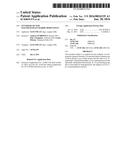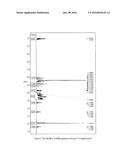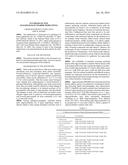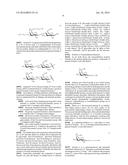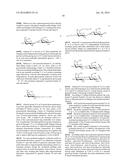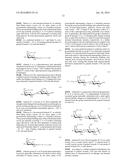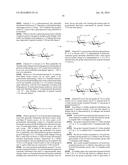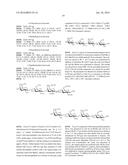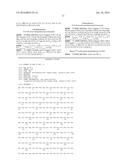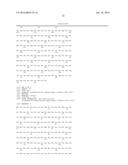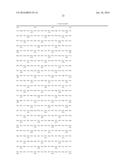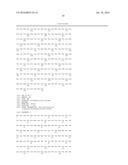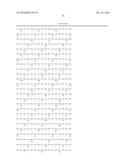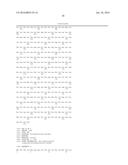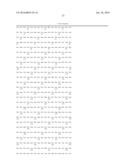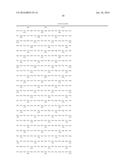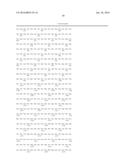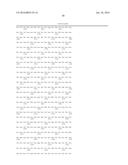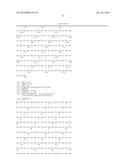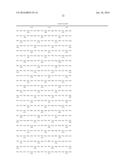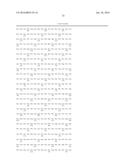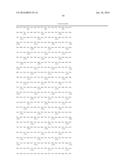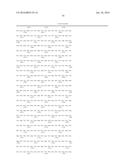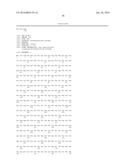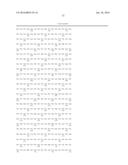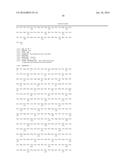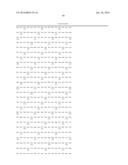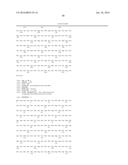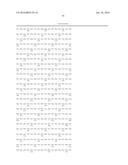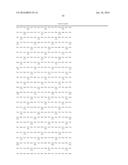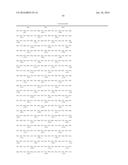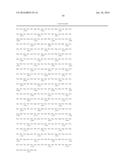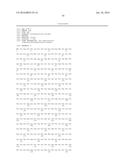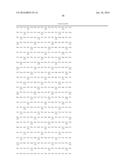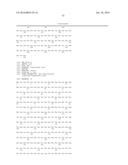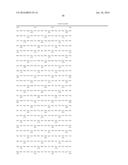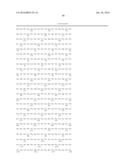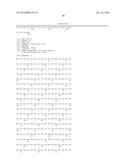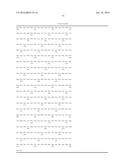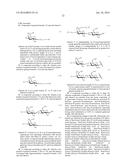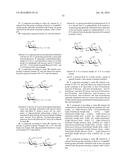Patent application title: SYNTHESIS OF NEW SIALOOLIGOSACCHARIDE DERIVATIVES
Inventors:
Andreas Schroven (Barssel, DE)
Elise Champion (Toulouse, FR)
Elise Champion (Toulouse, FR)
Gyula Dekany (Sinnamon Park, AU)
Gyula Dekany (Sinnamon Park, AU)
Assignees:
Glycom A/S
IPC8 Class: AC07H504FI
USPC Class:
536 172
Class name: Carbohydrates or derivatives o- or s- glycosides nitrogen containing
Publication date: 2016-01-28
Patent application number: 20160024129
Abstract:
The invention relates to a method for the synthesis of compounds of
general formula (1A) and salts thereof wherein one of the R groups is an
α-sialyl moiety and the other is H, X1 represents a
carbohydrate linker, A is a D-glucopyranosyl unit optionally substituted
with fucosyl, R1 is a protecting group that is removable by
hydrogenolysis, the integer in is 0 or 1, by a transsialidation reaction.Claims:
1-10. (canceled)
11. Compounds of general formula 1A' and salts thereof ##STR00053## wherein one of the R groups is an α-sialyl moiety and the other is H, R1 is a protecting group that is removable by hydrogenolysis, A is a D-glucopyranosyl unit optionally substituted with fucosyl, integer m is 0 or 1, and X1 represents a carbohydrate linker, provided that 1-O-.beta.-benzyl and 1-O-.beta.-(4,5-dimethoxy-2-nitro)-benzyl glycosides of 3'-O-(N-acetyl-neuraminosyl)-lactose sodium salt, and 1-O-.beta.-benzyl glycoside of 6'-O-(N-acetyl-neuraminosyl)-lactose sodium salt are excluded.
12. A compound according to claim 11, wherein compounds of general formula 1A' and salts thereof are characterized by general formula 1'-3A and salts thereof ##STR00054## wherein SA is an α-sialyl moiety, R1, A, X1 and m are defined in claim 11.
13. A compound according to claim 12, wherein compounds of general formula 1'-3A and salts thereof are characterized by general formulae 1'-3B or 1'-3C and salts thereof ##STR00055## wherein R3 is fucosyl or H, B is an N-acetyl-glucosaminopyranosyl unit optionally substituted with fucosyl and/or sialyl, and linker X2 means a mono-, di-, tri-, tetra-, penta- or oligosaccharide representing a linear or a branched structure having the monosaccharide building units selected from glucose, N-acetyl-glucosamine, galactose, fucose and sialic acid, R1 and A are defined in claim 11.
14. A compound according to claim 13, wherein compounds of general formulae 1'-3B or 1'-3C and salts thereof are human milk oligosaccharides of general formula 1'-3D and salts thereof ##STR00056## wherein Y is independently an N-acetyl-lactosaminyl group optionally substituted with a sialyl and/or fucosyl residue, integer p is independently 0, 1 or 2, R4' is selected from the groups characterized by general formulae 3-3 and 4-3, ##STR00057## wherein R6 is H or fucosyl residue, R7 H or α-sialyl moiety, SA is α-sialyl moiety, and R5' is selected from H, α-sialyl moiety, a group of general formula 3-3 and a group of general formula 4-3.
15. A compound according to claim 13 or claim 11, wherein compounds of general formula 1'-3B or 1'-3C and salts thereof are selected from the group consisiting of R1-glycosides of lactose, lacto-N-neotetraose, para-lacto-N-hexaose, para-lacto-N-neohexaose, lacto-N-neohexaose, para-lacto-N-octaose and lacto-N-neooctaose, lacto-N-tetraose, lacto-N-hexaose, lacto-N-octaose, iso-lacto-N-octaose, lacto-N-decaose and lacto-N-neodecaose optionally substituted with one or more sialyl and/or fucosyl residue and having sialyl substituent in 3-OH of a terminal galactosyl residue, and salts thereof.
16. A compound according to claim 15, wherein the compounds are selected from the group consisting of R'-glycosides of Neu5Acα2-3Galβ1-4Glc (3'-O-(N-acetyl-neuraminosyl)-lactose), Neu5Acα2-3Galβ1-4(Fucα1-3)Glc (3-O-fucosyl-3'-O-(N-acetyl-neuraminosyl)-lactose), Neu5Acα2-3Galβ1-3GlcNAcβ1-3Galβ1-4Glc (LST a), Neu5Acα2-3Galβ1-4GlcNAcβ1-3Galβ1-4Glc, Neu5Acα2-3Galβ1-3(Fucα1-4)GlcNAcβ1-3Galβ1-4Glc (FLST a), Neu5Acα2-3Galβ1-4(Fucα1-3)GlcNAc131-3Galβ- 1-4Glc, Neu5Acα2-3Galβ1-3GlcNAcβ1-3Galβ1-4(Fucα- 1-3)Glc, Neu5Acα2-3Galβ1-3(Fucα1-4)GlcNAcβ1-3Gal.bet- a.1-4(Fucα1-3)Glc, Neu5Acα2-3Galβ1-3(Neu5Acα2-6)GlcNAcβ1-3Galβ1-4- Glc (DSLNT), Neu5Acα2-3Galβ1-3(Neu5Acα2-6)(Fucα1-4)GlcNAcβ- 1-3Galβ1-4Glc (FDSLNT I), Neu5Acα2-3Galβ1-3(Neu5Acα2-6)GlcNAcβ1-3Galβ1-4- (Fucα1-3)Glc (FDSLNT II), Neu5Acα2-3Galβ1-4GlcNAcβ1-3Galβ1-4(Fucα1-3)Glc- , Neu5Acα2-3Galβ1-4(Fucα1-3)GlcNAcβ1-3Galβ1-4(F- ucα1-3)Glc, Neu5Acα2-3Galβ1-4(Fucα1-3)GlcNAcβ1-3Galβ1-4Glc and salts thereof.
17. A compound according to claim 11, wherein R1 is selected from the group consisting of benzyl or 2-naphthylmethyl groups optionally substituted with at least one group selected from the group consisting of phenyl, alkyl or halogen.
18. Compounds of general formula 2A' and salts thereof ##STR00058## wherein A is a D-glucopyranosyl unit optionally substituted with fucosyl, R' is a protecting group that is removable by hydrogenolysis, X1 represents a carbohydrate linker, integer m is 0 or 1, provided that a) when m is 0, then group A is substituted with fucosyl, and b) 1-O-.beta.-benzyl-LNT, 1-O-.beta.-(4-hydroxymethylbenzyl)-LNnT and 1-O-.beta.-benzyl-LNnT are excluded.
19. A compound according to claim 18, wherein compounds of general formula 2A' and salts thereof are characterized by general formulae 2B' or 2C' and salts thereof ##STR00059## wherein R3 is fucosyl, B is an N-acetyl-glucosaminopyranosyl unit optionally substituted with fucosyl and/or sialyl, and linker X2 means a mono-, di-, tri-, tetra-, penta- or oligosaccharide representing a linear or a branched structure having the monosaccharide building units selected from glucose, N-acetyl-glucosamine, galactose, fucose and sialic acid, R1 and A are as defined in claim 18.
20. A compound according to claim 19, wherein compounds of general formulae formulae 2B' or 2C' and salts thereof are human milk oligosaccharide derivatives of general formula 2D' or salts thereof ##STR00060## wherein R1 is a group removable by hydrogenolysis, R3 is H or fucosyl unit, Y is independently an N-acetyl-lactosaminyl group optionally substituted with a sialyl and/or fucosyl residue, integer p is independently 0, 1 or 2, R8 is selected form the groups characterized by general formulae 5 and 6, ##STR00061## wherein R6 is H or fucosyl residue, R7 is H or α-sialyl moiety, and R9 is selected from H, α-sialyl moiety, a group of general formula 5 and a group of general formula 6.
21. A compound according to claim 19, wherein compounds of 2B' or 2C' and salts thereof are selected from the group consisting of R1-glycosides of lacto-N-neotetraose, para-lacto-N-hexaose, para-lacto-N-neohexaose, lacto-N-neohexaose, para-lacto-N-octaose and lacto-N-neooctaose, lacto-N-tetraose, lacto-N-hexaose, lacto-N-octaose, iso-lacto-N-octaose, lacto-N-decaose and lacto-N-neodecaose optionally substituted with one or more sialyl and/or fucosyl residues and having an unsubstituted terminal galactosyl residue, and salts thereof.
22. A compound of according to claim 18, wherein the compounds are selected from the group consisting of R1-glycosides of Galβ1-4(Fucα1-3)Glc (3-O-fucosyllactose), Galβ1-3GlcNAcβ1-3Galβ1-4Glc (LNT), Galβ1-4GlcNAcβ1-3Galβ1-4Glc (LNnT), Galβ1-3(Fucα1-4)GlcNAcβ1-3Galβ1-4Glc (LNFP II), Galβ1-4(Fucα1-3)GlcNAcβ1-3Galβ1-4Glc (LNFP III), Galβ1-3GlcNAcβ1-3Galβ1-4(Fucα1-3)Glc (LNFP V), Galβ1-3(Fucα1-4)GlcNAcβ1-3Galβ1-4(Fucα1-3)Glc (LNDFH II), Galβ1-3(Neu5Acα2-6)GlcNAcβ1-3Galβ1-4Glc (LSTb), Galβ1-3(Neu5Acα2-6)(Fucα1-4)GlcNAcβ1-3Gal.b- eta.1-4Glc, Galβ1-3(Neu5Acα2-6)GlcNAcβ1-3Galβ1-4(Fucα1-3)G- lc, Galβ1-4GlcNAcβ1-3Galβ1-4(Fucα1-3)Glc, Galβ1-4(Fucα1-3)GlcNAcβ1-3Galβ1-4(Fucα1-3)Glc (LNDFH III), or salts thereof.
23. A compound according to claim 18, wherein R1 is selected from the group consisting of benzyl or 2-naphthylmethyl groups optionally substituted with at least one group selected from the group consisting of phenyl, alkyl or halogen.
Description:
CROSS REFERENCE TO RELATED APPLICATIONS
[0001] This application is a divisional of co-pending U.S. patent application Ser. No. 13/809,794, filed Mar. 15, 2013, now allowed, which is the National Phase entry of PCT/EP2011/062184, filed Jul. 15, 2011, which claims priority to European Patent Application No. 11166036.1, filed May 13, 2011 and Great Britain Patent Application No. 1012036.8, filed Jul. 16, 2010. The content of each of the foregoing applications is incorporated herein in their entirety by reference.
FIELD OF THE INVENTION
[0002] The present invention relates to the enzymatic synthesis of sialooligosaccharide glycosides, and novel precursors and products taking part in the synthesis.
BACKGROUND OF THE INVENTION
[0003] Sialic acids are derivatives of the nine-carbon sugar neuraminic acid and encompass three parent molecules, N-acetyl-(Neu5Ac), N-glycolyl-(Neu5Gc) and deamino-neuraminic acid (3-deoxy-D-glycero-D-galacto-nonulosonic acid, KDN), which can be substituted at C-4, C-7, C-8 and C-9 by various moieties. They have many major biological roles, ranging from embryogenesis to neural plasticity to pathogen interactions. Although they may rarely occur in free form, they are usually found in chemical covalent linkage at the non-reducing terminus or in internal positions of oligosaccharide side-chains of glycoproteins and glycolipids. The linkages of sialic acids in which they are bound to penultimate sugars such as galactose, N-acetyl-galactosamine and N-acetyl-glucosamine are most commonly α-2,3- and α-2,6-ketosidic bonds.
[0004] Among sialoglycoconjugates, sialylated human milk oligosaccharides are of great importance which is directly linked to their unique biological activities such as antibacterial, antiviral, immune system and cognitive development enhancing activities. Sialylated human milk oligosaccharides are found to act as prebiotics in the human intestinal system helping to develop and maintain the intestinal flora. Furthermore they have also proved to be anti-inflammatory, and therefore these compounds are attractive components in the nutritional industry for the production of, for example, infant formulas, infant cereals, clinical infant nutritional products, toddler formulas, or as dietary supplements or health functional food for children, adults, elderly or lactating women, both as synthetically composed and naturally occurring compounds and salts thereof. Likewise, the compounds are also of interest in the medicinal industry for the production of therapeutics. In the human milk oligosaccharides the sialic acid residue is always linked to the terminal 3-O- and/or 6-O-position(s) of D-galactose via α-glycosidic linkage.
[0005] The availability of naturally occurring sialylated human milk oligosaccharides is limited. Mature human milk is the natural milk source that contains the highest concentrations of milk oligosaccharides (12-14 g/l), other milk sources are cow's milk (0.01 g/l), goat's milk and milk from other mammals. This low natural availability and difficult isolation methods are important motivations for the development of biotechnological and chemical methodologies for the production of these attractive compounds.
[0006] Approximately 200 HMOs have been detected from human milk by means of combination of techniques including microchip liquid chromatography mass spectrometry (HPLC Chip/MS) and matrix-assisted laser desorption/ionization Fourier transform ion cyclotron resonance mass spectrometry (MALDI-FT ICR MS) (Ninonuevo et al. J. Agric. Food Chem. 54, 7471 (2006)), from which to date at least 115 oligosaccharides have been structurally determined (Urashima et al.: Milk Oligosaccharides, Nova Medical Books, NY, 2011). These human milk oligosaccharides can be grouped into 13 core units (Table 1). About a quarter of oligosaccharides contains sialic acid.
TABLE-US-00001 TABLE 1 13 different core structures of human milk oligosaccharides (HMOs) No Core name Core structure 1 lactose (Lac) Galβ1-4Glc 2 lacto-N-tetraose (LNT) Galβ1-3GlcNAcβ1-3Galβ1-4Glc 3 lacto-N-neotetraose Galβ1-4GlcNAcβ1-3Galβ1-4Glc (LNnT) 4 lacto-N-hexaose (LNH) Galβ1-3GlcNAcβ1-3(Galβ1-4GlcNAcβ1-6)Galβ1-4Glc 5 lacto-N-neohexaose Galβ1-4GlcNAcβ1-3(Galβ1-4GlcNAcβ1-6)Galβ1-4Glc (LNnH) 6 para-lacto-N-hexaose Galβ1-3GlcNAcβ1-3Galβ1-4GlcNAcβ1-3Galβ1-4Glc (para-LNH) 7 para-lacto-N-neohexaose Galβ1-4GlcNAcβ1-3Galβ1-4GlcNAcβ1-3Galβ1-4Glc (para-LNnH) 8 lacto-N-octaose (LNO) Galβ1-3GlcNAcβ1-3(Galβ1-4GlcNAcβ1-3Galβ1- 4GlcNAcβ1-6)Galβ1-4Glc 9 lacto-N-neooctaose Galβ1-4GlcNAcβ1-3(Galβ1-3GlcNAcβ1-3Galβ1- (LNnO) 4GlcNAcβ1-6)Galβ1-4Glc 10 Iso-lacto-N-octaose Galβ1-3GlcNAcβ1-3(Galβ1-3GlcNAcβ1-3Galβ1- (iso-LNO) 4GlcNAcβ1-6)Galβ1-4Glc 11 para-lacto-N-octaose Galβ1-3GlcNAcβ1-3Galβ1-4GlcNAcβ1-3Galβ1- (para-LNO) 4GlcNAcβ1-3Galβ1-4Glc 12 Lacto-N-decaose Galβ1-3GlcNAcβ1-3[Galβ1-4GlcNAcβ1-3(Galβ1- (LND) 4GlcNAcβ1-6)Galβ1-4GlcNAcβ1-6]Galβ1-4Glc 13 Lacto-N-neodecaose Galβ1-3GlcNAcβ1-3[Galβ1-3GlcNAcβ1-3(Galβ1- (LNnD) 4GlcNAcβ1-6)Galβ1-4GlcNAcβ1-6]Galβ1-4Glc
[0007] The isolation of sialooligosaccharides form human and other mammals' milk is rather difficult even in milligram quantities due to the presence of a large number of similar oligosaccharides. To date only analytical HPLC methodologies have been developed for the isolation of some sialooligosaccharides from natural source.
[0008] The synthesis of complex sialooligosaccharides follows multistep synthetic pathways utilising protection and deprotection strategies. Stereoselective chemical synthetic processes can become very complicated due to the extensive use of protecting groups. These strategies give sialylated oligosaccharides via stereoselective O-sialylation of appropriate protected glycosyl acceptors using glycosylhalide, thioglycoside or diethylphosphite donor activations. The use of either very expensive or very toxic chemicals for the sialylation such as mercury cyanide, mercury bromide and silver carbonate is one of the reasons that make these methodologies less attractive. Inefficient stereocontrol and/or poor yields likewise make(s) the strategies less suitable for further developments. Additionally, these strategies are characterized by severe purification difficulties.
[0009] In the case of enzymatic production of sialooligosaccharides, sialyltransferases and sialidases have been the preferred enzymes used. These complex enzymatic systems represent very expensive methodologies for scale-up production and difficult purification protocols are likewise a hindrance for further technology developments. Sialidases could not be used successfully in large scale production methodologies due to low yields and lack of regio- and stereoselectivity. Although in some cases sialyltransferase enzymes are found to be effective in the synthesis of complex sialooligosaccharides (e.g. the synthesis of 1-O-β-benzyl glycoside of 3'-O-(N-acetyl-neuraminosyl)-lactose sodium salt: WO 96/32492; the synthesis of 1-O-β-(4,5-dimethoxy-2-nitro)-benzyl glycoside of 3'-O-(N-acetyl-neuraminosyl)-lactose sodium salt: Cohen et al. J. Org. Chem. 65, 6145 (2000)), the need of CMP-activated sialic acid (cytidine 5'-monophosphosialic acid) as sialyl donor--whose availability is, in fact, rather limited--for transferring the sialic acid portion to the acceptor oligosaccharide restricts their usefulness.
[0010] The ability of N-acetyl-lactosamine benzyl glycoside and benzyl glycosides of mucin oligosaccharides from T. cruzi to act as substrate in transsialidase reaction has been studied (Lubineau et al. Carbohydr. Res. 300, 161 (1997); Agusti et al. Bioorg. Med. Chem. 15, 2611 (2007)).
[0011] Regioselective sialidation of unprotected or anomerically substituted galactose, lactose or N-acetyl-lactosamine derivatives by means of sialidases in poor yield has been reported (Thiem et al. Angew. Chem. Int. Ed. Eng. 30, 1503 (1991); Schmidt et al. Chem. Comm. 1919 (2000); Schmidt et al. J. Org. Chem. 65, 8518 (2000)).
[0012] Some biotechnological methodologies are also described using genetically modified bacteria, yeasts or other microorganisms. Such methods have serious drawbacks in regulatory processes due to limiting commercialisation opportunities.
[0013] Sialoglycoconjugates are known to be unstable under certain reaction conditions, such as to acid and base. Indeed, they are able to self-hydrolyse. Accordingly, conditions for preparation and purification of these compounds must be carefully selected.
[0014] In summary, isolation technologies have never been able to provide large quantities of sialooligosaccharides due to the large number of oligosaccharides present in the pool of natural origin, e.g. in human milk. Additionally, the presence of regioisomers characterized by extremely similar structures further made separation technologies unsuccessful. Enzymatic methodologies suffer from the low availability of enzymes, extremely high sugar nucleotide donor prices and regulatory difficulties due to the use of enzymes produced in genetically modified organisms. The preparation of oligosaccharides via biotechnology has huge regulatory obstacles due to the potential formation of several unnatural glycosylation products. Generally, all the chemical methods developed for the synthesis of sialooligosaccharides have several drawbacks which prevented the preparation of even multigram quantities of the target compounds (e.g. see the synthesis of 3'-O- and 6'-O-(N-acetyl-neuraminosyl)-lactose through the corresponding benzyl glycoside: Rencurosi et al. Carbohydr. Res. 337, 473 (2002)).
[0015] During the past decades the interest in the preparation and commercialisation of sialylated human milk oligosaccharides has been increasing steadily. There is still a need for novel methodologies which can simplify preparation and overcome or avoid purification problems encountered in prior art methods.
SUMMARY OF THE INVENTION
[0016] In one aspect, the present invention relates to a method for the synthesis of compounds of general formula 1A and salts thereof
##STR00001##
[0017] wherein one of the R groups is an α-sialyl moiety and the other is H, X1 represents a carbohydrate linker, A is a D-glucopyranosyl unit optionally substituted with fucosyl, R1 is a protecting group that is removable by hydrogenolysis, the integer m is 0 or 1, characterized in that a sialyl donor of formula SA-OR2 or salts thereof, wherein R2 can be a mono-, di- or oligosaccharide, glycolipid, glycoprotein or glycopeptide, cyclic or acyclic aliphatic group, or aryl residue, and SA is an α-sialyl moiety, is reacted with a sialyl acceptor of general formula 2A or a salt thereof
##STR00002##
[0018] wherein X1, A, m and R1 are as defined above, under the catalysis of an enzyme having transsialidase activity.
[0019] In another aspect, the present invention provides compounds of general formula 1A' and salts thereof
##STR00003##
[0020] wherein one of the R groups is an α-sialyl moiety and the other is H, R1 is a protecting group that is removable by hydrogenolysis, A is a D-glucopyranosyl unit optionally substituted with fucosyl, integer m is 0 or 1, and X1 represents a carbohydrate linker, provided that 1-O-β-benzyl and 1-O-β-(4,5-dimethoxy-2-nitro)-benzyl glycosides of 3'-O-(N-acetyl-neuraminosyl)-lactose sodium salt, and 1-O-β-benzyl glycoside of 6'-O-(N-acetyl-neuraminosyl)-lactose sodium salt are excluded.
BRIEF DESCRIPTION OF THE FIGURES
[0021] The invention will be described in further detail hereinafter with reference to: FIG. 1 which shows the 400 MHz 1H-NMR spectrum of benzyl 3'''-O-sialyl-β-LNnT according to the present invention.
DETAILED DESCRIPTION OF THE INVENTION
[0022] Whatever route is taken to synthesise an oligosaccharide, the final target unprotected oligosaccharide is soluble only in water, which presents challenges for the later steps of the synthesis. Organic solvents commonly used in synthetic manufacturing processes are not suitable for the reactions of the very final stages of the oligosaccharide synthesis.
[0023] The present invention provides new sialooligosaccharides protected in the anomeric position and methodology suitable for manufacturing thereof. The invention is based upon the utilisation of water soluble 1-O-protected oligosaccharide intermediates in transsialidation reaction, wherein the 1-O-protecting group chosen may be removed by hydrogenolysis. Preferably, the 1-O-protecting group should also provide to the oligosaccharide intermediate physical and chemical properties assisting powerful purification processes. For example, the introduction of an aromatic group such as a benzyl or substituted benzyl group as a hydrophobic moiety enables the derivatives to be soluble in organic protic solvents like alcohols while their water solubility also remains. This opens the possibility of using mobile phases having a wide range of water/alcohol proportions which can be applied in separation/purification techniques such as size exclusion or reverse phase chromatography. Moreover, with careful design of substituents on the aromatic group, crystalline compounds can in some cases be realized, which allows the development of powerful manufacturing procedures using crystallisation alone for product purifications. Furthermore, the benzylic 1-O-protecting group can be removed by catalytic reduction (hydrogenolysis) in the last step under mild and delicate conditions that prevent by-product formation, which is undoubtedly an advantage when at least one sialyl group is present in the target oligosaccharide. It is possible for the catalytic reduction to take place in aqueous solution.
[0024] General Terms
[0025] Throughout the present application the term "α-sialyl moiety" or "sialyl moiety" present in the sialyl donors and in the compounds of general formula 1, refers to glycosyl moieties of any naturally occurring or modified neuraminic or sialic acid derivatives and analogues thereof having an α-glycosidic linkage, as depicted by the example of N-acetyl neuraminic acid in Scheme 1. Preferred neuraminic acids are N-acetyl-(Neu5Ac), N-glycolyl-(Neu5Gc) and deamino-neuraminic acid (3-deoxy-D-glycero-D-galacto-nonulosonic acid, KDN). Also included are Neu5Ac, Neu5Gc and KDN derivatives that are derivatized with linkers, reactive functional groups, detectable labels or targeting moieties, and/or substituted at C-4, C-7-, C-8 and/or C-9, especially at C-9, with acyloxy, alkoxy, halogen or azido. More preferred O-substituents are acetyl (at C-4, C-7-, C-8 and/or C-9), lactyl (at C-9), methyl (at C-8), sulphate (at C-8) or phosphate (at C-8). The preferred substituents on the amino group are acyls including glycolyl and acetoacetyl as well.
##STR00004##
[0026] The "protecting group that is removable by hydrogenolysis" refers to groups whose C--O bond to the 1-oxygen is cleaved by addition of hydrogen in the presence of catalytic amounts of palladium, Raney nickel or another appropriate metal catalyst known for use in hydrogenolysis, resulting in the regeneration of the OH group. Such protecting groups are well known to the skilled man and are discussed in Protective Groups in Organic Synthesis, P G M Wuts and T W Greene, John Wiley & Sons 2007. Suitable protecting groups include benzyl, diphenylmethyl (benzhydryl), 1-naphthylmethyl, 2-naphthylmethyl or triphenylmethyl (trityl) groups, each of which may be optionally substituted by one or more groups selected from: alkyl, alkoxy, phenyl, amino, acylamino, alkylamino, dialkylamino, nitro, carboxyl, alkoxycarbonyl, carbamoyl, N-alkylcarbamoyl, N,N-dialkylcarbamoyl, azido, halogenalkyl or halogen. Preferably, such substitution, if present, is on the aromatic ring(s). Particularly preferred protecting groups are benzyl or 2-naphthylmethyl groups optionally substituted with one or more groups selected from phenyl, alkyl or halogen. More preferably, the protecting group is selected from unsubstituted benzyl, unsubstituted 2-naphthylmethyl, 4-chlorobenzyl, 3-phenylbenzyl and 4-methylbenzyl. These particularly preferred and more preferable protecting groups have the advantage that the by-products of the hydrogenolysis are exclusively toluene, 2-methylnaphthalene, or substituted toluene or 2-methylnaphthalene derivatives, respectively. Such by-products can easily be removed even in multi ton scales from water soluble oligosaccharide products via evaporation and/or extraction processes.
[0027] Throughout the present description, the term "alkyl" means a linear or branched chain saturated hydrocarbon group with 1-6 carbon atoms, such as methyl, ethyl, n-propyl, i-propyl, n-butyl, i-butyl, s-butyl, t-butyl, n-hexyl, etc.
[0028] The term "aryl" refers to a homoaromatic group such as phenyl or naphthyl.
[0029] In the present description, the term "acyl" represents an R'--C(═O)-group, wherein R' may be H, alkyl (see above) or aryl (see above), such as formyl, acetyl, propionyl, butyryl, pivaloyl, benzoyl, etc. The alkyl or aryl residue may either be unsubstituted or may be substituted with one or more groups selected from alkyl (only for aryl residues), halogen, nitro, aryl, alkoxy, amino, alkylamino, dialkylamino, carboxyl, alkoxycarbonyl, carbamoyl, N-alkylcarbamoyl, N,N-dialkylcarbamoyl, azido, halogenalkyl or hydroxyalkyl, giving rise to acyl groups such as chloroacetyl, trichloroacetyl, 4-chlorobenzoyl, 4-nitrobenzoyl, 4-phenylbenzoyl, 4-benzamidobenzoyl, 4-(phenylcarbamoyl)-benzoyl, glycolyl, acetoacetyl, etc.
[0030] The term "alkyloxy" or "alkoxy" means an alkyl group (see above) attached to the parent molecular moiety through an oxygen atom, such as methoxy, ethoxy, t-butoxy, etc.
[0031] "Halogen" means fluoro, chloro, bromo or iodo.
[0032] "Amino" refers to a --NH2 group.
[0033] "Alkylamino" means an alkyl group (see above) attached to the parent molecular moiety through an --NH-group, such as methylamino, ethylamino, etc.
[0034] "Dialkylamino" means two alkyl groups (see above), either identical or different ones, attached to the parent molecular moiety through a nitrogen atom, such as dimethylamino, diethylamino, etc.
[0035] "Acylamino" refers to an acyl group (see above) attached to the parent molecular moiety through an --NH-group, such as acetylamino (acetamido), benzoylamino (benzamido), etc.
[0036] "Carboxyl" denotes an --COOH group.
[0037] "Alkyloxycarbonyl" means an alkyloxy group (see above) attached to the parent molecular moiety through a --C(═O)-group, such as methoxycarbonyl, t-butoxycarbonyl, etc.
[0038] "Carbamoyl" is an H2N--C(═O)-group.
[0039] "N-Alkylcarbamoyl" means an alkyl group (see above) attached to the parent molecular moiety through a --HN--C(═O)-group, such as N-methylcarbamoyl, etc.
[0040] "N,N-Dialkylcarbamoyl" means two alkyl groups (see above), either identical or different ones, attached to the parent molecular moiety through a >N--C(═O)-group, such as N,N-methylcarbamoyl, etc.
[0041] In the present description the term "salt" in connection with compounds of general formulae 1 and 2 and of formula SA-OR2, which contain at least one sialyl residue, means an associated ion pair consisting of the negatively charged acid residue and one or more cations in any stoichiometric proportion. Cations, as used in the present context are atoms or molecules with positive charge. The cation may be inorganic as well as organic cation. Preferred inorganic cations are ammonium ion, alkali metal, alkali earth metal and transition metal ions, more preferably Na.sup.+, K.sup.+, Ca2+, Mg2+, Ba2+, Fe2+, Zn2+, Mn2+ and Cu2+, most preferably K.sup.+, Ca2+, Mg2+, Ba2+, Fe2+ and Zn2+. Basic organic compounds in positively charged form may be relevant organic cations. Such preferred positively charged counterparts are diethyl amine, triethyl amine, diisopropyl ethyl amine, ethanolamine, diethanolamine, triethanolamine, imidazol, piperidine, piperazine, morpholin, benzyl amine, ethylene diamine, meglumin, pyrrolidine, choline, tris-(hydroxymethyl)-methyl amine, N-(2-hydroxyethyl)-pyrrolidine, N-(2-hydroxyethyl)-piperidine, N-(2-hydroxyethyl)-piperazine, N-(2-hydroxyethyl)-morpholine, L-arginine, L-lysine, oligopeptides having L-arginine or L-lysine unit or oligopeptides having free amino group on N-terminal, etc., all in protonated form. Such salt formations can be used to modify characteristics of the complex molecule as a whole, such as stability, compatibility to excipients, solubility and ability to form crystals.
[0042] Transsialidation Reactions
[0043] In accordance with the present invention there is provided a process for synthesizing sialooligosaccharides of general formula 1 and salts thereof wherein one of the R groups is an α-sialyl moiety and the other is H, X represents a carbohydrate linker, R1 is a protecting group that is removable by hydrogenolysis and the integer n is 0 or 1, characterized in that a sialyl donor of formula SA-OR2 and salts thereof, wherein R2 can be a mono-, di- or oligosaccharide, glycolipid, glycoprotein or glycopeptide, cyclic or acyclic aliphatic group, or aryl residue, and SA is an α-sialyl moiety, is reacted with a sialyl acceptor of general formula 2 and salts thereof, under the catalysis of an enzyme having transsialidase activity. The process is depicted in Scheme 2.
##STR00005##
[0044] An advantage of providing compounds of general formula 1 is the more simple purification of the sialylated oligosaccharide 1-O-protected glycosides compared to the unglycosylated sialooligosaccharides. Since there is no formation of free sialic acid as a side product, and due to the different polarity of the reaction compounds, isolation of the products by reverse phase or size exclusion chromatography is possible. In the case of reverse phase chromatography when water is used, compounds of general formula 1 migrate much more slowly than the very polar compounds present in the reaction mixture, thus the polar compounds can be eluted smoothly. Compounds of general formula 1 can be then washed from the column with e.g. alcohol.
[0045] Enzymes Having Transsialidase Activity
[0046] Enzymes having transsialidase activity and suitable for the purpose of the method of making sialooligosaccharides claimed in the present application can be selected from sialidase and transsialidase enzymes.
[0047] Sialidases (EC 3.2.1.18), classified in the GH33 family, are retaining enzymes with the ability of hydrolyzing the α-linkage of the terminal sialic acid, mainly those bound to galactose with α-2-3 or α-2-6 linkage, of various sialoglycoconjugates. They are found particularly in diverse virus families and bacteria, and also in protozoa, some invertebrates and mammals. Some bacterial sialidases can be used to scavenge sialic acids from sialylated glycoprotein, glycolipids or other glycoconjugates for nutrients for bacterial cell growth.
[0048] Although sialidases are characterized by their hydrolytic activity, under appropriate reaction conditions they are able to catalyze the transfer of a sialic acid unit to an asialo acceptor by a transsialidation reaction giving rise to the formation of sialoglycoconjugates. Sialidases from pathogen bacteria or viruses such as Bacteroides fragilis, Clostridium species (e.g. C. perfringens), Corynebacterium diphtheriae, Haemophilus parasuis, Pasteurella multocida, Pseudomonas aeruginosa, Salmonella typhimurium, Streptococcus pneumoniae, Tannerella forsythia, Vibrio cholerae or Newcastle disease virus and from non-pathogenic bacteria or viruses such as Actinomyces viscosus, Arthrobacter species or Micromonospora viridifaciens are capable of acting as a catalyst for a sialylation reaction due to their transsialidase activity with α-2-3 and/or α-2-6 selectivity. As to the regioselectivity, the ratio between the α-2-3- and α-2-6-linked products varies depending on the enzymes and/or the acceptors. For example sialidases from A. ureafaciens, C. perfringens and V. cholerae have good α-2-6 selectivity, whereas those from S. typhimurium and Newcastle disease virus have good to excellent preference for formation of the α-2-3 linkage.
[0049] Recently, sialidases from Bifidobacterium species like Bifidobacterium bifidum and Bifidobacterium longum subsp. infantis have been identified, cloned and characterized. These sialidases can cleave and so recognize both α-2,3- and α-2,6-linked sialosides. Sialidases from Bifidobacterium longum subsp. infantis have a consistent preference for α-2,6-linkage whereas sialidases from Bifidobacterium bifidum have a consistent preference for α-2,3-linkage.
[0050] In order to improve regioselectivity and/or conversion of the transsialidation reaction the sialidases may be subjected to alteration by various engineering techniques.
[0051] In rational engineering novel altered enzymes (mutants) are created by point mutation. The mutation generally affects the active site of the enzyme. Replacement of the catalytic nucleophile with a non-nucleophilic residue results in the formation of an inactive mutant or an altered enzyme with reduced transglycosylation activity due the lack of an appropriate environment for the formation of the reactive host-guest complex for transglycosylation. However, in the presence of a more active sialyl donor than the natural one, the mutated enzyme is able to transfer efficiently the sialyl residue to a suitable acceptor. Rational engineering of enzymes generally requires reliance on the static 3D protein structure. These altered enzymes may be devoid of product hydrolysis activity.
[0052] A second technique called directed evolution strategy comprises random mutagenesis of the selected natural sialidase enzyme thus creating a library of enzyme variants each of which are altered in a single or multiple positions. They may be inserted into suitable microorganisms such as E. coli or S. cerevisiae for producing recombinant variants with slightly altered properties. Clones expressing improved enzymes are then identified with a fast and reliable screening method, selected and brought into a next round of the mutation process. The recurring cycles of mutation, recombination and selection are continued as far as mutant(s) with the desired activity and/or specificity is/are evolved.
[0053] With regard to transsialidases, the first transsialidase enzyme described was found in Trypanosoma cruzi, a protozoa which causes Chagas disease. Since that time transsialidases have been detected in several other trypanosome types such as Trypanosoma brucei gambiense, Trypanosoma brucei rhodesiense, Trypanosoma brucei brucei and Trypanosoma congolense. Moreover, the existence of transsialidases has been shown in Endotrypanum types, in Corynebacterium diphtheriae and even in the human plasma.
[0054] Transsialidases differ from sialidases in that, in addition to the hydrolytic activity towards sialic acids of the sialidases, the former have more considerable sialic acid transfer activity. Transsialidases can transfer sialic acids, preferably α-2,3-bonded sialic acids, from a donor molecule to an acceptor derivative, which is preferably a terminal galactose moiety with β-interglycosidic linkage. As a result of this transfer, an α-glycosidic bond is be formed between the sialic acid and the acceptor. However, if there is no suitable acceptor, the transsialidase hydrolyses the sialic acid.
[0055] It is possible to produce directed transsialidase enzyme mutants wherein the hydrolase activity is effaced in favour of the transsialidase action, e.g. by altering the amino acid sequence. After creating a library of altered genes by mutagenesis and/or recombination, they may be inserted into suitable microorganisms such as E. coli or S. cerevisiae for producing recombinant variants with slightly altered properties. Clones expressing improved enzymes are then identified, isolated and can be used for the desired purpose. For example, based on sequence and structure comparisons, sialidase from Trypanosoma rangeli may be mutated at six positions, wherein the resulting mutant is able to display a significant level of trans-sialidase activity (Paris et al. J. Mol. Biol. 345, 923 (2005)).
[0056] Preferably, the enzyme having transsialidase activity may be selected from sialidases or transsialidases derived from Bifidobacterium longum subsp. infantis ATCC 15697, Bifidobacterium bifidum JCM1254, Bifidobacterium bifidum S17, Bifidobacterium bifidum PRL2010, Bifidobacterium bifidum NCIMB 41171, Trypanosoma cruzi, etc.
[0057] More preferably the enzyme having transsialidase activity may be selected from sialidases or transsialidases as defined according to the following deposit numbers: gi1213524659 (Bifidobacterium longum subsp. infantis ATCC 15697, SEQ ID NO: 1), gi1213523006 (Bifidobacterium longum subsp. infantis ATCC 15697, SEQ ID NO: 2), gi1309252191 (Bifidobacterium bifidum S17, SEQ ID NO: 3), gi1309252190 (Bifidobacterium bifidum S17, SEQ ID NO: 4), gi1310867437 (Bifidobacterium bifidum PRL2010, SEQ ID NO: 5), gi1310867438 (Bifidobacterium bifidum PRL2010, SEQ ID NO: 6), gi1224283484 (Bifidobacterium bifidum NCIMB 41171, SEQ ID NO: 7), gi1224283485 (Bifidobacterium bifidum NCIMB 41171, SEQ ID NO: 8), gi1334283443 gi147252690 (Bifidobacterium bifidum JCM1254, SEQ ID NO: 9), gi147252690 (T. cruzi, SEQ ID NO: 10), gi1432485 (T. cruzi, SEQ ID NO: 11). Particularly preferred sialidases/transsialidases with transsialidase activity are listed in the following Table 2:
TABLE-US-00002 TABLE 2 Preferred sialidases/transsialidases GI number in GenBank SEQ Database Organism ID NO: gi|213524659 Bifidobacterium longum subsp. infantis ATCC 1 15697 gi|213523006 Bifidobacterium longum subsp. infantis ATCC 2 15697 gi|309252191 Bifidobacterium bifidum S17 3 gi|309252190 Bifidobacterium bifidum S17 4 gi|310867437 Bifidobacterium bifidum PRL2010 5 gi|310867438 Bifidobacterium bifidum PRL2010 6 gi|224283484 Bifidobacterium bifidum NCIMB 41171 7 gi|224283485 Bifidobacterium bifidum NCIMB 41171 8 gi|334283443 Bifidobacterium bifidum JCM1254 9 gi|47252690 Trypanosoma cruzi 10 gi|432485 Trypanosoma cruzi 11
[0058] It is envisaged that sialidase/transsialidase enzyme mutants retaining transsialidase activity and having a sequence similarity/homology to the sequence of the above mentioned enzyme sequences having transsialidase activity of at least 70%, more preferably at least 80%, even more preferably at least 85%, even more preferably at least 90% and most preferably at least 95% or even 97%, 98% or 99% as compared to the entire wild type sequence on amino acid level.
[0059] Preferably, the sequence similarity is at least 90%, more preferably 95%, 97%, 98% or most preferably 99%. Preferably, said trans-sialidase activity is at least 75% of that of the native form of the enzyme, more preferably at least 90% and still more preferably at least 100%.
[0060] Sialidases and transsialidases possess a broader donor and acceptor specificity than the sialyl transferases used in prior art processes, and so can be used in a particularly wide variety of reactions. Sialidases/transsialidases are therefore more advantageous for industrial utilisation than are sialyltransferases previously used.
[0061] Donors for Sialidases/Transsialidases
[0062] It is known that, upon infection of an organism with T. cruzi, the transsialidase in T. cruzi scavenges sialic acids from sialoglycoconjugates of the host's organism and efficiently sialylates its own surface mucin in order to mask its own epitope.
[0063] After numerous intensive investigations it has been found that a huge number of natural and synthetic sialic acid containing derivatives can act as sialyl donors in transsialidation reactions. Thus sialyl donor compounds of general formula SA-OR2 defined above can provide a substrate to be transferred by transsialidases to the acceptor. Transsialidases do not transfer pure sialic acid or CMP-sialic acid (which is, in fact, a β-sialide) to the acceptor, the presence of a sialic acid with an α-anomeric aglycon or α-anomeric substituent is a requisite for the transsialidase reactions. Typical natural sialyl donors can be selected from, but are not limited to, 3'-O-sialyl-lactose, fetuin, gangliosides, O- or N-linked glycopeptides, all of which contain a sialic acid α-2,3-linked to a terminal β-galactoside residue, or polysialic acid with α-2,8-linkage. Among synthetic sialosides 2-O-(4-methylumbelliferyl)- or 2-O-(optionally substituted phenyl)-α-D-sialosides, more commonly 2-O-(p-nitrophenyl)-α-D-sialoside, are of preference.
[0064] Acceptors for Sialidases/Transsialidases
[0065] Transsialidase acceptors used in transsialidation reaction disclosed above are characterized by general formula 2 and salts thereof which are R1-galactopyranosides (when n is 0) or oligosaccharide R1-glycosides whose terminal sugar moiety on the non-reducing end is galactopyranose (when n equals 1). The terminal galactopyranosyl unit is bound preferably with a β-glycosidic linkage.
[0066] The anomeric hydroxyl group of compounds of general formula 2 are protected with R1 groups that can be removed by hydrogenolysis. As set out previously, such groups include optionally substituted benzyl and naphthylmethyl groups. Benzyl or 2-naphthylmethyl groups optionally substituted with phenyl, alkyl or halogen are preferred R1-groups, and among them unsubstituted benzyl, unsubstituted 2-naphthylmethyl, 4-chlorobenzyl, 3-phenylbenzyl or 4-methylbenzyl groups are of particular preference.
[0067] When n is 1, the structural element X, as carbohydrate linker, means a mono-, di-, tri-, tetra-, penta- or oligosaccharide representing a linear or a branched structure. The monosaccharide building units of the carbohydrate linker can be any naturally occurring 5-, 6- or 9-carbon containing sugar derivatives, with the most frequently occurring units being glucose, N-acetyl glucosamine, galactose, fucose and sialic acid.
[0068] In a preferred method n is 1 and linker X corresponds to formula --(X1)m-A-forming acceptors of general formula 2A or salts thereof
##STR00006##
wherein A is a D-glucopyranosyl unit optionally substituted with fucosyl, X1 represents a carbohydrate linker, and integer m is 0 or 1. Group --OR1 is linked to the anomeric carbon (C1) atom of the D-glucopyranosyl ring, preferably in β orientation.
[0069] When m is 0, the terminal D-galactopyranosyl unit is directly coupled to group A through an interglycosidic linkage. Preferably, the interglycosidic linkage is a 1-4 linkage thus forming compounds of general formula 2B
##STR00007##
[0070] wherein R3 is fucosyl or H. More preferably the interglycosidic linkage between the galactose and the glucose portion is β thus giving rise to a lactose derivative. In an even more preferable embodiment aglycon --OR1 is also in β orientation.
[0071] When m is 1, the structural element X1, as carbohydrate linker, means a mono-, di-, tri-, tetra-, penta- or oligosaccharide representing a linear or a branched structure. The monosaccharide building units of the carbohydrate linker can be any naturally occurring 5-, 6- or 9-carbon containing sugar derivatives, with the most frequently occurring units being glucose, N-acetyl-glucosamine, galactose, fucose and sialic acid. Preferably, linker X1 is represented by the formula --B--X2-- thus forming compounds of general formula 2C or salts thereof
##STR00008##
[0072] wherein group B is an N-acetyl-glucosaminopyranosyl unit optionally substituted with fucosyl and/or sialyl, and linker X2 means a mono-, di-, tri-, tetra-, penta- or oligosaccharide representing a linear or a branched structure having the monosaccharide building units selected from glucose, N-acetyl-glucosamine, galactose, fucose and sialic acid. Group --OR1 is linked to the anomeric carbon (C1) atom of the D-glucopyranosyl ring, preferably in β orientation. In preference, the terminal galactosyl group is attached to group B through 1-3 or 1-4 interglycosidic linkage forming thus a lacto-N-biosyl or N-acetyl-lactosaminyl terminal disaccharide moieties, respectively. In a further favoured method, a fucosyl substituent may be coupled to the 3-OH or 4-OH group of unit B and/or to the 3-OH group of unit A, and/or sialyl may be connected to 6-OH of unit B.
[0073] In a more preferred method group X2 is galactose optionally substituted with sialyl or oligosaccharide representing a linear or a branched structure having the saccharide building units selected from N-acetyl-lactosamine, lacto-N-biose, fucose and sialic acid, forming thus human milk oligosaccharide derivatives represented by general formula 2D or salts thereof
##STR00009##
[0074] wherein R1 is a group removable by hydrogenolysis, R3 is H or fucosyl unit, Y is independently an N-acetyl-lactosaminyl group optionally substituted with a sialyl and/or fucosyl residue, integer p is independently 0, 1 or 2, R8 is selected form the groups characterized by general formulae 5 and 6,
##STR00010##
[0075] wherein R6 is H or fucosyl residue, R7 H or α-sialyl moiety, and R9 is selected from H, α-sialyl moiety, a group of general formula 5 and a group of general formula 6.
[0076] According to a further preferred method, the compound of general formula 2D and salts thereof as defined above is characterized by its linkages and attached moieties, wherein
[0077] an N-acetyl-lactosaminyl group in group Y, when attached to another N-acetyl-lactosaminyl group (p=2), is coupled with 1-3 interglycosidic linkage,
[0078] the group of general formula 5, when attached to Y (p=1, 2), is coupled with 1-3 interglycosidic linkage,
[0079] the group of general formula 6, when attached to Y (p=1, 2), is coupled with 1-3 interglycosidic linkage,
[0080] the fucosyl residue if attached to a N-acetyl-lactosaminyl group present in Y is linked to the N-acetyl-glucosamine of the N-acetyl-lactosaminyl group with 1-3 interglycosidic linkage,
[0081] the α-sialyl residue if attached to a N-acetyl-lactosaminyl group present in Y is linked to the galactose of the N-acetyl-lactosaminyl group with 2-6 interglycosidic linkage.
[0082] In a further aspect, the compound of general formula 2B, 2C or 2D and salts thereof as defined above represents the R1-glycosides of lactose, lacto-N-neotetraose, para-lacto-N-hexaose, para-lacto-N-neohexaose, lacto-N-neohexaose, para-lacto-N-octaose and lacto-N-neooctaose, lacto-N-tetraose, lacto-N-hexaose, lacto-N-octaose, iso-lacto-N-octaose, lacto-N-decaose and lacto-N-neodecaose optionally substituted with one or more sialyl and/or fucosyl residue and having unsubstituted terminal galactosyl residue. Preferably, the sialyl substituent is N-acetyl neuraminyl group.
[0083] Particularly preferably, the compound of general formula 2B, 2C or 2D and salts thereof as defined above is selected from the group of R1-glycosides of Galβ1-4Glc (lactose), Galβ1-4(Fucα1-3)Glc (3 -O-fucosyllactose), Galβ1-3GlcNAcβ1-3Galβ1-4Glc (LNT), Galβ1-4GlcNAcβ1-3Galβ1-4Glc (LNnT), Galβ1-3(Fucα1-4)GlcNAcβ1-3Galβ1-4Glc (LNFP II), Galβ1-4(Fucα1-3)GlcNAcβ1-3Galβ1-4Glc (LNFP III), Galβ1-3GlcNAcβ1-3Galβ1-4(Fucα1-4)Glc (LNFP V), Galβ1-3 (Fucα1-4)GlcNAcβ1-3Galβ1-4(Fucα1-3)Glc (LNDFH II), Galβ1-3(Neu5Acα2-6)GlcNAcβ1-3Galβ1-4Glc (LSTb), Galβ1-3(Neu5Acα2-6)(Fucα1-4)GlcNAcβ1-3Gal.b- eta.1-4Glc, Galβ1-3(Neu5Acα2-6)GlcNAcβ1-3Galβ1-4(Fucα1-3)G- lc, Galβ1-4GlcNAcβ1-3Galβ1-4(Fucα1-3)Glc, Galβ1-4(Fucα1-3)GlcNAcβ1-3Galβ1-4(Fucα1-3)Glc (LNDFH III), or salts thereof. The R1-glycosides may be alpha or beta-anomers. Preferably, said R1-glycosides are the beta-anomers.
[0084] A typical synthesis of compounds of general formula 2 comprises the treatment of galactose, or oligosaccharides having a galactopyranosyl unit at the nonreducing terminal, with acetic anhydride and sodium acetate at 50-125° C., followed by Lewis acid catalyzed glycosylation using R1--OH, preferably benzyl/substituted benzyl alcohols, in organic solvent such as DCM, toluene, THF, etc. Subsequently, compounds of general formula 2 are obtained via a final Zemplen deprotection of the glycosylated products.
[0085] According to another typical anomeric O-protection procedure, fully or partially protected galactose or oligosaccharides having a galactopyranosyl unit at the nonreducing end with a free anomeric OH in a dipolar aprotic solvent such as DMF, DMSO, N-methylpyrrolidone, hexamethylphosphoramide (HMPA), N,N'-dimethylhexahydropyrimidine-2-one (DMPU), THF, dioxane, acetonitrile, etc., or mixture thereof, is O-alkylated in the presence of a strong base and R1--X wherein X is a leaving group selected from halogen, alkylsulfonyloxy like mesyl, triflyl, etc. and arylsulfonyl like benzenesulfonyl, tosyl, etc. Preferred alkylating agents are benzyl or 1- or 2-naphthylmethyl halogenides optionally substituted with one or more groups selected from phenyl, alkyl or halogen. The strong base is able to deprotonate the anomeric OH chemoselectively due to its more acidic character when an equivalent amount or a slight excess (1 to 1.5 equiv.) of base is used. The strong base suitable for activating the anomeric OH is typically taken from the group of alkali metal or alkaline earth metal hydrides or alkoxides such as NaH, KH, CaH2, NaOMe, NaOtBu, KOtBu, inorganic hydroxides, potassium carbonate, etc. The alkylation agent is added in an equivalent amount or a slight excess (1 to 1.5 equiv.). The reaction is carried out between -10 and 80° C., preferably at a low temperature during whole course of the reaction or at a low temperature during the additon of the reagents/reactants and an elevated temperature in the later stages of the course of the reaction. Benzyl/substituted benzyl glycosides of general formula 2 can be obtained after usual work-up.
[0086] In a further aspect, the present invention relates to providing compounds of general formula 2A' and salts thereof
##STR00011##
wherein A is a D-glucopyranosyl unit optionally substituted with fucosyl, X1 represents a carbohydrate linker, integer m is 0 or 1, provided that a) when m is 0, then group A is substited with fucosyl, and b) the compound differs to 1-O-β-benzyl-LNT, 1-O-β-(4-hydroxymethylbenzyl)-LNnT and 1-O-β-benzyl-LNnT. Group --OR1 is linked to the anomeric carbon (C1) atom of the D-glucopyranosyl ring, preferably in β orientation.
[0087] When m is 0, the terminal D-galactopyranosyl unit is directly coupled to group A through an interglycosidic linkage. Preferably, the interglycosidic linkage is a 1-4 linkage thus forming compounds of general formula 2B' and salts thereof
##STR00012##
[0088] wherein R3 is fucosyl. More preferably the interglycosidic linkage between the galactose and the glucose portion is β thus giving rise to a lactose derivative. In an even more preferable embodiment aglycon --OR1 is also in β orientation.
[0089] When m is 1, the structural element X1, as carbohydrate linker, means a mono-, di-, tri-, tetra-, penta- or oligosaccharide representing a linear or a branched structure. The monosaccharide building units of the carbohydrate linker can be any naturally occurring 5-, 6- or 9-carbon containing sugar derivatives, with the most frequently occurring units being glucose, N-acetyl-glucosamine, galactose, fucose and sialic acid. Preferably, linker X1 is represented by the formula --B--X2-- thus forming compounds of general formula 2C' and salts thereof
##STR00013##
[0090] wherein group B is an N-acetyl-glucosaminopyranosyl unit optionally substituted with fucosyl and/or sialyl, and linker X2 means a mono-, di-, tri-, tetra-, penta- or oligosaccharide representing a linear or a branched structure having the monosaccharide building units selected from glucose, N-acetyl-glucosamine, galactose, fucose and sialic acid. Group --OR1 is linked to the anomeric carbon (C1) atom of the D-glucopyranosyl ring, preferably in β orientation. In preference, the terminal galactosyl group is attached to group B through 1-3 or 1-4 interglycosidic linkage forming thus a lacto-N-biosyl or N-acetyl-lactosaminyl terminal disaccharide moieties, respectively. In a further favoured method, a fucosyl substituent may be coupled to the 3-OH or 4-OH group of unit B and/or to the 3-OH group of unit A, and/or sialyl may be connected to 6-OH of unit B.
[0091] In a more preferred method group X2 is galactose optionally substituted with sialyl or oligosaccharide residue representing a linear or a branched structure having the saccharide building units selected from N-acetyl-lactosamine, lacto-N-biose, fucose and sialic acid, forming thus human milk oligosaccharide derivatives represented by general formula 2D' or salts thereof
##STR00014##
[0092] wherein R1 is a group removable by hydrogenolysis, R3 is H or fucosyl unit, Y is independently an N-acetyl-lactosaminyl group optionally substituted with a sialyl and/or fucosyl residue, integer p is independently 0, 1 or 2, R8 is selected form the groups characterized by general formulae 5 and 6,
##STR00015##
[0093] wherein R6 is H or fucosyl residue, R7 H or α-sialyl moiety, and R9 is selected from H, α-sialyl moiety, a group of general formula 5 and a group of general formula 6.
[0094] According to a further preferred embodiment, the compound of general formula 2D' and salts thereof as defined above is characterized by its linkages and attached moieties, wherein
[0095] an N-acetyl-lactosaminyl group in group Y, when attached to another N-acetyl-lactosaminyl group, is coupled with 1-3 interglycosidic linkage,
[0096] the group of general formula 5, when attached to Y, is coupled with 1-3 interglycosidic linkage,
[0097] the group of general formula 6, when attached to Y, is coupled with 1-3 interglycosidic linkage,
[0098] the fucosyl residue if attached to a N-acetyl-lactosaminyl group present in Y is linked to the N-acetyl-glucosamine of the N-acetyl-lactosaminyl group with 1-3 interglycosidic linkage,
[0099] the α-sialyl residue if attached to a N-acetyl-lactosaminyl present in Y is linked to the galactose of the N-acetyl-lactosaminyl group with 2-6 interglycosidic linkage.
[0100] In a further aspect, the compound of general formula 2C' or 2D' and salts thereof as defined above represents the R1-glycosides lacto-N-neotetraose, para-lacto-N-hexaose, para-lacto-N-neohexaose, lacto-N-neohexaose, para-lacto-N-octaose and lacto-N-neooctaose, lacto-N-tetraose, lacto-N-hexaose, lacto-N-octaose, iso-lacto-N-octaose, lacto-N-decaose and lacto-N-neodecaose optionally substituted with one or more sialyl and/or fucosyl residue and having unsubstituted terminal galactosyl residue. Preferably, the sialyl substituent is N-acetyl neuraminyl group.
[0101] Particularly preferably, the compound of general formula 2A' and salts thereof as defined above is selected from the group of R1-glycosides of Galβ1-4(Fucα1-3)Glc (3-O-fucosyllactose), Galβ1-3GlcNAcβ1-3Galβ1-4Glc (LNT), Galβ1-4GlcNAcβ1-3Galβ1-4Glc (LNnT), Galβ1-3 (Fucα1-4)GlcNAcβ1-3Galβ1-4Glc (LNFP II), Galβ1-4(Fucα1-3)GlcNAcβ1-3Galβ1-4Glc (LNFP III), Galβ1-3GlcNAcβ1-3Galβ1-4(Fucα1-3)Glc (LNFP V), Galβ1-3 (Fucα1-4)GlcNAcβ1-3Galβ1-4(Fucα1-3)Glc (LNDFH II), Galβ1-3 (Neu5Acα2-6)GlcNAcβ1-3Galβ1-4Glc (LSTb), Galβ1-3 (Neu5Acα2-6)(Fucα1-4)GlcNAcβ1-3Galβ1-4Glc, Galβ1-3 (Neu5Acα2-6)GlcNAcβ1-3Galβ1-4(Fucα1-3)Glc, Galβ1-4GlcNAcβ1-3Galβ1-4(Fucα1-3)Glc, Galβ1-4(Fucα1-3)GlcNAcβ1-3Galβ1-4(Fucα1-3)Glc (LNDFH III), or salts thereof. The R1-glycosides may be alpha or beta-anomers. Preferably, said R1-glycosides are the beta-anomers.
[0102] Products of Transsialidation Reaction
[0103] As set forth above, the transsialidation reaction claimed in the present application produces compounds of general formula 1 and salts thereof
##STR00016##
[0104] wherein one of the R groups is an α-sialyl moiety and the other is H, X represents a carbohydrate linker, R1 is a protecting group that is removable by hydrogenolysis and the integer n is 0 or 1, from compounds of general formula 2 and salts thereof. R1 group includes optionally substituted benzyl and naphthylmethyl groups, among which benzyl or 2-naphthylmethyl groups optionally substituted with phenyl, alkyl or halogen are preferred R1-groups, and among them unsubstituted benzyl, unsubstituted 2-naphthylmethyl, 4-chlorobenzyl, 3-phenylbenzyl or 4-methylbenzyl groups are of particular preference.
[0105] When n is 1, the structural element X, as carbohydrate linker, means a mono-, di-, tri-, tetra-, penta- or oligosaccharide representing a linear or a branched structure. The monosaccharide building units of the carbohydrate linker can be any naturally occurring 5-, 6- or 9-carbon containing sugar derivatives, with the most frequently occurring units being glucose, N-acetyl glucosamine, galactose, fucose and sialic acid.
[0106] In a preferred method n is 1 and linker X corresponds to formula --(X1)m-A-forming sialylated products of general formula 1A and salts thereof
##STR00017##
[0107] wherein A is a D-glucopyranosyl unit optionally substituted with fucosyl, X1 represents a carbohydrate linker, and integer m is 0 or 1. Group --OR1 is linked to the anomeric carbon (C1) atom of the D-glucopyranosyl ring, preferably in β orientation.
[0108] When m is 0, the D-galactopyranosyl unit is directly coupled to group A through an interglycosidic linkage. Preferably, the interglycosidic linkage is a 1-4 linkage thus forming compounds of general formula 1B and salts thereof
##STR00018##
[0109] wherein R3 is fucosyl or H. More preferably the interglycosidic linkage between the galactose and the glucose portion is β thus giving rise to a 3'-O-sialyl-lactose derivative. In an even more preferable embodiment aglycon --OR1 is also in β orientation.
[0110] When m is 1, the structural element X1, as carbohydrate linker, means a mono-, di-, tri-, tetra-, penta- or oligosaccharide representing a linear or a branched structure. The monosaccharide building units of the carbohydrate linker can be any naturally occurring 5-, 6- or 9-carbon containing sugar derivatives, with the most frequently occurring units being glucose, N-acetyl-glucosamine, galactose, fucose and sialic acid. Preferably, linker X1 is represented by the formula --B--X2- thus forming compounds of general formula 1C and salts thereof
##STR00019##
[0111] wherein group B is an N-acetyl-glucosaminopyranosyl unit optionally substituted with fucosyl and/or sialyl, and linker X2 means a mono-, di-, tri-, tetra-, penta- or oligosaccharide representing a linear or a branched structure having the monosaccharide building units selected from glucose, N-acetyl-glucosamine, galactose, fucose and sialic acid. Group --OR1 is linked to the anomeric carbon (C1) atom of the D-glucopyranosyl ring, preferably in β orientation. In preference, the sialyl-galactosyl group is attached to group B through 1-3 or 1-4 interglycosidic linkage forming thus a sialyl-lacto-N-biosyl or sialyl-N-acetyl-lactosaminyl terminal trisaccharide moieties, respectively. In a further favoured method, a fucosyl substituent may be coupled to the 3-OH or 4-OH group of unit B and/or to the 3-OH group of unit A, and/or sialyl may be connected to 6-OH of unit B.
[0112] In a more preferred method to synthesize sialyl oligosaccharide derivatives, group X2 in compounds of general formula 1C and salts thereof is galactose optionally substituted with sialyl or oligosaccharide representing a linear or a branched structure having the saccharide building units selected from N-acetyl-lactosamine, lacto-N-biose, fucose and sialic acid, forming thus human milk oligosaccharide derivatives represented by general formula 1D and salts thereof
##STR00020##
[0113] wherein R1 is a group removable by hydrogenolysis, R3 is H or fucosyl unit, Y is independently N-acetyl-lactosaminyl group optionally substituted with a sialyl and/or fucosyl residue, integer p is independently 0, 1 or 2, R4 is selected form the groups characterized by general formulae 3 and 4,
##STR00021##
[0114] wherein R6 is H or fucosyl residue, R7 H or α-sialyl moiety, one of the R groups is an α-sialyl moiety and the other is H, and R5 is selected from H, α-sialyl moiety, group of general formula 3 and group of general formula 4.
[0115] According to a further preferred method, the compound of general formula 1D and salts thereof as defined above is characterized by its linkages and attached moieties, wherein
[0116] an N-acetyl-lactosaminyl group in group Y (p=2), when attached to another N-acetyl-lactosaminyl group, is coupled with 1-3 interglycosidic linkage,
[0117] the group of general formula 3, when attached to Y (p=1, 2), is coupled with 1-3 interglycosidic linkage,
[0118] the group of general formula 4, when attached to Y (p=1, 2), is coupled with 1-3 interglycosidic linkage,
[0119] the fucosyl residue if attached to a N-acetyl-lactosaminyl group present in Y is linked to the N-acetyl-glucosamine of the N-acetyl-lactosaminyl group with 1-3 interglycosidic linkage,
[0120] the α-sialyl residue if attached to a N-acetyl-lactosaminyl present in Y is linked to the galactose of the N-acetyl-lactosaminyl group with 2-6 interglycosidic linkage.
[0121] In a further aspect, the compound of general formula 1B, 1C or 1D and salts thereof as defined above represents the R1-glycosides of lactose, lacto-N-neotetraose, para-lacto-N-hexaose, para-lacto-N-neohexaose, lacto-N-neohexaose, para-lacto-N-octaose and lacto-N-neooctaose, lacto-N-tetraose, lacto-N-hexaose, lacto-N-octaose, iso-lacto-N-octaose, lacto-N-decaose and lacto-N-neodecaose optionally substituted with one or more sialyl and/or fucosyl residue and having sialyl substituent in 3-OH or 6-OH of a terminal galactosyl residue. Preferably, the sialyl substituent(s) is/are N-acetyl-neuraminyl group(s).
[0122] Particularly preferably, the compound of general formula 1B, 1C or 1D and salts thereof as defined above is selected from the group of R1-glycosides of Neu5Acα2-3Galβ1-4Glc (3'-O-(N-acetyl-neuraminosyl)-lactose), Neu5Acα2-6Galβ1-4Glc (6'-O-(N-acetyl-neuraminosyl)-lactose), Neu5Acα2-3Galβ1-4(Fucα1-3)Glc (3-O-fucosyl-3'-O-(N-acetyl-neuraminosyl)-lactose), Neu5Acα2-3Galβ1-3GlcNAcβ1-3Galβ1-4Glc (LST a), Neu5Acα2-6Galβ1-3GlcNAcβ1-3Galβ1-4Glc, Neu5Acα2-3Galβ1-4GlcNAcβ1-3Galβ1-4Glc, Neu5Acα2-6Galβ1-4GlcNAcβ1-3Galβ1-4Glc (LST c), Neu5Acα2-3Galβ1-3 (Fucα1-4)GlcNAcβ1-3Galβ1-4Glc (FLST a), Neu5Acα2-6Galβ1-3(Fucα1-4)GlcNAcβ1-3Galβ1-4Glc- , Neu5Acα2-3Galβ1-4(Fucα1-3)GlcNAcβ1-3Galβ1-4Gl- c, Neu5Acα2-Galβ1-4(Fucα1-3)GlcNAcβ1-3Galβ1-4Gl- c, Neu5Acα2-3Galβ1-3GlcNAcβ1-3Galβ1-4(Fucα1-3)G- lc, Neu5Acα2-6Galβ1-3GlcNAcβ1-3Galβ1-4(Fucα1-4)- Glc, Neu5Acα2-3Galβ1-3 (Fucα1-4)GlcNAcβ1-3Galβ1-4(Fucα1-3)Glc, Neu5Acα2-6Galβ1-3(Fucα1-4)GlcNAcβ1-3Galβ1-4(Fu- cα1-3)Glc, Neu5Acα2-3Galβ1-3(Neu5Acα2-6)GlcNAcβ1-3Galβ1-4- Glc (DSLNT), Neu5Acα2-6Galβ1-3(Neu5Acα2-6)GlcNAcβ1-3Galβ1-4- Glc, Neu5Acα2-3Galβ1-3(Neu5Acα2-6)(Fucα1-4)GlcNAc.b- eta.1-3Galβ1-4Glc (FDSLNT I), Neu5Acα2-6Galβ1-3(Neu5Acα2-6)(Fucα1-4)GlcNAcβ- 1-3Galβ1-4Glc, Neu5Acα2-3Galβ1-3(Neu5Acα2-6)GlcNAcβ1-3Galβ1-4- (Fucα1-3)Glc (FDSLNT II), Neu5Acα2-6Galβ1-3(Neu5Acα2-6)GlcNAcβ1-3Galβ1-4- (Fucα1-3)Glc, Neu5Acα2-3Galβ1-4GlcNAcβ1-3Galβ1-4(Fucα1-3)Glc- , Neu5Acα2-6Galβ1-4GlcNAcβ1-3Galβ1-4(Fucα1-3)Gl- c (FLST c), Neu5Acα2-3Galβ1-4(Fucα1-3)GlcNAcβ1-3Galβ1-4(Fu- cα1-3)Glc, Neu5Acα2-6Galβ1-4(Fucα1-3)GlcNAcβ1-3Galβ1-4(Fu- cα1-3)Glc, Neu5Acα2-3Galβ1-4(Fucα1-3)GlcNAcβ1-3Galβ1-4Glc- , Neu5Acα2-6Galβ1-4(Fucα1-3)GlcNAcβ1-3Galβ1-4Gl- c or salts thereof. The R1-glycosides may be alpha- or beta-anomers. Preferably, said R1-glycosides are the beta-anomers.
[0123] In case of selective α-2-3 sialidation, the transsialidation reaction claimed in the present application produces compounds of general formula 1-3 and salts thereof
##STR00022##
[0124] wherein SA is an α-sialyl moiety, X represents a carbohydrate linker, R1 is a protecting group that is removable by hydrogenolysis and the integer n is 0 or 1, from compounds of general formula 2 and salts thereof R1 group includes optionally substituted benzyl and naphthylmethyl groups, among which benzyl or 2-naphthylmethyl groups optionally substituted with phenyl, alkyl or halogen are preferred R1-groups, and among them unsubstituted benzyl, unsubstituted 2-naphthylmethyl, 4-chlorobenzyl, 3-phenylbenzyl or 4-methylbenzyl groups are of particular preference.
[0125] When n is 1, the structural element X, as carbohydrate linker, means a mono-, di-, tri-, tetra-, penta- or oligosaccharide representing a linear or a branched structure. The monosaccharide building units of the carbohydrate linker can be any naturally occurring 5-, 6- or 9-carbon containing sugar derivatives, with the most frequently occurring units being glucose, N-acetyl glucosamine, galactose, fucose and sialic acid.
[0126] In a preferred method n is 1 and linker X corresponds to formula --(X1)m-A-forming sialylated products of general formula 1-3A and salts thereof
##STR00023##
[0127] wherein A is a D-glucopyranosyl unit optionally substituted with fucosyl, X1 represents a carbohydrate linker, and integer m is 0 or 1. Group --OR1 is linked to the anomeric carbon (C1) atom of the D-glucopyranosyl ring, preferably in β orientation.
[0128] When m is 0, the D-galactopyranosyl unit is directly coupled to group A through an interglycosidic linkage. Preferably, the interglycosidic linkage is a 1-4 linkage thus forming compounds of general formula 1-3B and salts thereof
##STR00024##
[0129] wherein R3 is fucosyl or H. More preferably the interglycosidic linkage between the galactose and the glucose portion is β thus giving rise to a 3'-O-sialyl-lactose derivative. In an even more preferable embodiment aglycon --OR1 is also in β orientation.
[0130] When m is 1, the structural element X1, as carbohydrate linker, means a mono-, di-, tri-, tetra-, penta- or oligosaccharide representing a linear or a branched structure. The monosaccharide building units of the carbohydrate linker can be any naturally occurring 5-, 6- or 9-carbon containing sugar derivatives, with the most frequently occurring units being glucose, N-acetyl-glucosamine, galactose, fucose and sialic acid. Preferably, linker X1 is represented by the formula --B--X2-- thus forming compounds of general formula 1-3C and salts thereof
##STR00025##
[0131] wherein group B is an N-acetyl-glucosaminopyranosyl unit optionally substituted with fucosyl and/or sialyl, and linker X2 means a mono-, di-, tri-, tetra-, penta- or oligosaccharide representing a linear or a branched structure having the monosaccharide building units selected from glucose, N-acetyl-glucosamine, galactose, fucose and sialic acid. Group --OR1 is linked to the anomeric carbon (C1) atom of the D-glucopyranosyl ring, preferably in β orientation. In preference, the sialyl-galactosyl group is attached to group B through 1-3 or 1-4 interglycosidic linkage forming thus a sialyl-lacto-N-biosyl or sialyl-N-acetyl-lactosaminyl terminal trisaccharide moieties, respectively. In a further favoured method, a fucosyl substituent may be coupled to the 3-OH or 4-OH group of unit B and/or to the 3-OH group of unit A, and/or sialyl may be connected to 6-OH of unit B.
[0132] In a more preferred method to synthesize sialyl oligosaccharide derivatives, group X2 in compounds of general formula 1-3C and salts thereof is galactose optionally substituted with sialyl or oligosaccharide representing a linear or a branched structure having the saccharide building units selected from N-acetyl-lactosamine, lacto-N-biose, fucose and sialic acid, forming thus human milk oligosaccharide derivatives represented by general formula 1-3D and salts thereof
##STR00026##
[0133] wherein R1 is a group removable by hydrogenolysis, R3 is H or fucosyl unit, Y is independently N-acetyl-lactosaminyl group optionally substituted with a sialyl and/or fucosyl residue, integer p is independently 0, 1 or 2, R4' is selected form the groups characterized by general formulae 3-3 and 4-3,
##STR00027##
[0134] wherein R6 is H or fucosyl residue, R7 H or α-sialyl moiety, SA is α-sialyl moiety and R5' is selected from H, α-sialyl moiety, group of general formula 3-3 and group of general formula 4-3.
[0135] According to a further preferred embodiment, the compound of general formula 1-3D and salts thereof as defined above is characterized by its linkages and attached moieties, wherein
[0136] an N-acetyl-lactosaminyl group in group Y (p=2), when attached to another N-acetyl-lactosaminyl group, is coupled with 1-3 interglycosidic linkage,
[0137] the group of general formula 3-3, when attached to Y (p=1, 2), is coupled with 1-3 interglycosidic linkage,
[0138] the group of general formula 4-3, when attached to Y (p=1, 2), is coupled with 1-3 interglycosidic linkage,
[0139] the fucosyl residue if attached to a N-acetyl-lactosaminyl group present in Y is linked to the N-acetyl-glucosamine of the N-acetyl-lactosaminyl group with 1-3 interglycosidic linkage,
[0140] the α-sialyl residue if attached to a N-acetyl-lactosaminyl present in Y is linked to the galactose of the N-acetyl-lactosaminyl group with 2-6 interglycosidic linkage.
[0141] In a further aspect, the compound of general formula 1-3B, 1-3C or 1-3D and salts thereof as defined above represents the R1-glycosides of lactose, lacto-N-neotetraose, para-lacto-N-hexaose, para-lacto-N-neohexaose, lacto-N-neohexaose, para-lacto-N-octaose and lacto-N-neooctaose, lacto-N-tetraose, lacto-N-hexaose, lacto-N-octaose, iso-lacto-N-octaose, lacto-N-decaose and lacto-N-neodecaose optionally substituted with one or more sialyl and/or fucosyl residue and having sialyl substituent in 3-OH of a terminal galactosyl residue, and salts thereof. Preferably, the sialyl substituent(s) is/are N-acetyl neuraminyl group(s).
[0142] Particularly preferably, the compound of general formula 1-3B, 1-3C or 1-3D and salts thereof as defined above is selected from the group of R1-glycosides of Neu5Acα2-3Galβ1-4Glc (3'-O-(N-acetyl-neuraminosyl)-lactose), Neu5Acα2-3Galβ1-4(Fucα1-3)Glc (3-O-fucosyl-3'-O-(N-acetyl-neuraminosyl)-lactose), Neu5Acα2-3Galβ1-3GlcNAcβ1-3Galβ1-4Glc (LST a), Neu5Acα2-3Galβ1-4GlcNAcβ1-3Galβ1-4Glc, Neu5Acα2-3Galβ1-3(Fucα1-4)GlcNAcβ1-3Galβ1-4Glc (FLST a), Neu5Acα2-3Galβ1-4(Fucα1-3)GlcNAcβ1-3Gal.b- eta.1-4Glc, Neu5Acα2-3Galβ1-3GlcNAcβ1-3Galβ1-4(Fucα1-3)Glc- , Neu5Acα2-3Galβ1-3(Fucα1-4)GlcNAcβ1-3Galβ1-4(F- ucα1-3)Glc, Neu5Acα2-3Galβ1-3(Neu5Acα2-6)GlcNAcβ1-3Galβ1-4- Glc (DSLNT), Neu5Acα2-3Galβ1-3(Neu5Acα2-6)(Fucα1-4)GlcNAcβ- 1-3Galβ1-4Glc (FDSLNT I), Neu5Acα2-3Galβ1-3(Neu5Acα2-6)GlcNAcβ1-3Galβ1-4- (Fucα1-3)Glc (FDSLNT II), Neu5Acα2-3Galβ1-4GlcNAcβ1-3Galβ1-4(Fucα1-3)Glc- , Neu5Acα2-3Galβ1-4(Fucα1-3)GlcNAcβ1-3Galβ1-4(F- ucα1-3)Glc, Neu5Acα2-3Galβ1-4(Fucα1-3)GlcNAcβ1-3Galβ1-4Glc and salts thereof. The R1-glycosides may be alpha- or beta-anomers. Preferably, said R1-glycosides are the beta-anomers.
[0143] In case of selective α-2-6 sialidation, the transsialidation reaction claimed in the present application produces compounds of general formula 1-6 and salts thereof
##STR00028##
[0144] wherein SA is an α-sialyl moiety, X represents a carbohydrate linker, R1 is a protecting group that is removable by hydrogenolysis and the integer n is 0 or 1, from compounds of general formula 2 and salts thereof R1 group includes optionally substituted benzyl and naphthylmethyl groups, among which benzyl or 2-naphthylmethyl groups optionally substituted with phenyl, alkyl or halogen are preferred R1-groups, and among them unsubstituted benzyl, unsubstituted 2-naphthylmethyl, 4-chlorobenzyl, 3-phenylbenzyl or 4-methylbenzyl groups are of particular preference.
[0145] When n is 1, the structural element X, as carbohydrate linker, means a mono-, di-, tri-, tetra-, penta- or oligosaccharide representing a linear or a branched structure. The monosaccharide building units of the carbohydrate linker can be any naturally occurring 5-, 6- or 9-carbon containing sugar derivatives, with the most frequently occurring units being glucose, N-acetyl glucosamine, galactose, fucose and sialic acid.
[0146] In a preferred method n is 1 and linker X corresponds to formula --(X1)m-A-forming sialylated products of general formula 1-6A and salts thereof
##STR00029##
[0147] wherein A is a D-glucopyranosyl unit optionally substituted with fucosyl, X1 represents a carbohydrate linker, and integer m is 0 or 1. Group --OR1 is linked to the anomeric carbon (C1) atom of the D-glucopyranosyl ring, preferably in β orientation.
[0148] When m is 0, the D-galactopyranosyl unit is directly coupled to group A through an interglycosidic linkage. Preferably, the interglycosidic linkage is a 1-4 linkage thus forming compounds of general formula 1-6B and salts thereof
##STR00030##
[0149] wherein R3 is fucosyl or H. More preferably the interglycosidic linkage between the galactose and the glucose portion is β thus giving rise to a 3'-O-sialyl-lactose derivative. In an even more preferable embodiment aglycon --OR1 is also in β orientation.
[0150] When m is 1, the structural element X1, as carbohydrate linker, means a mono-, di-, tri-, tetra-, penta- or oligosaccharide representing a linear or a branched structure. The monosaccharide building units of the carbohydrate linker can be any naturally occurring 5-, 6- or 9-carbon containing sugar derivatives, with the most frequently occurring units being glucose, N-acetyl-glucosamine, galactose, fucose and sialic acid. Preferably, linker X1 is represented by the formula --B--X2-- thus forming compounds of general formula 1-6C and salts thereof
##STR00031##
[0151] wherein group B is an N-acetyl-glucosaminopyranosyl unit optionally substituted with fucosyl and/or sialyl, and linker X2 means a mono-, di-, tri-, tetra-, penta- or oligosaccharide representing a linear or a branched structure having the monosaccharide building units selected from glucose, N-acetyl-glucosamine, galactose, fucose and sialic acid. Group --OR1 is linked to the anomeric carbon (C1) atom of the D-glucopyranosyl ring, preferably in β orientation. In preference, the sialyl-galactosyl group is attached to group B through 1-3 or 1-4 interglycosidic linkage forming thus a sialyl-lacto-N-biosyl or sialyl-N-acetyl-lactosaminyl terminal trisaccharide moieties, respectively. In a further favoured method, a fucosyl substituent may be coupled to the 3-OH or 4-OH group of unit B and/or to the 3-OH group of unit A, and/or sialyl may be connected to 6-OH of unit B.
[0152] In a more preferred method to synthesize sialyl oligosaccharide derivatives, group X2 in compounds of general formula 1-6C and salts thereof is galactose optionally substituted with sialyl or oligosaccharide representing a linear or a branched structure having the saccharide building units selected from N-acetyl-lactosamine, lacto-N-biose, fucose and sialic acid, forming thus human milk oligosaccharide derivatives represented by general formula 1-6D and salts thereof
##STR00032##
[0153] wherein R1 is a group removable by hydrogenolysis, R3 is H or fucosyl unit, Y is independently N-acetyl-lactosaminyl group optionally substituted with a sialyl and/or fucosyl residue, integer p is independently 0, 1 or 2, R4'' is selected from the groups characterized by general formulae 3-6 and 4-6,
##STR00033##
[0154] wherein R6 is H or fucosyl residue, R7 H or α-sialyl moiety, SA is α-sialyl moiety and R5''' is selected from H, α-sialyl moiety, group of general formula 3-6 and group of general formula 4-6, or salts thereof
[0155] According to a further preferred embodiment, the compound of general formula 1-6D and salts thereof as defined above is characterized by its linkages and attached moieties, wherein
[0156] an N-acetyl-lactosaminyl group in group Y (p=2), when attached to another N-acetyl-lactosaminyl group, is coupled with 1-3 interglycosidic linkage,
[0157] the group of general formula 3-6, when attached to Y (p=1, 2), is coupled with 1-3 interglycosidic linkage,
[0158] the group of general formula 4-6, when attached to Y (p=1, 2), is coupled with 1-3 interglycosidic linkage,
[0159] the fucosyl residue if attached to a N-acetyl-lactosaminyl group present in Y is linked to the N-acetyl-glucosamine of the N-acetyl-lactosaminyl group with 1-3 interglycosidic linkage,
[0160] the α-sialyl residue if attached to a N-acetyl-lactosaminyl present in Y is linked to the galactose of the N-acetyl-lactosaminyl group with 2-6 interglycosidic linkage.
[0161] In a further aspect, the compound of general formula 1-6B, 1-6C or 1-6D and salts thereof as defined above represents the R1-glycosides of lactose, lacto-N-neotetraose, para-lacto-N-hexaose, para-lacto-N-neohexaose, lacto-N-neohexaose, para-lacto-N-octaose and lacto-N-neooctaose, lacto-N-tetraose, lacto-N-hexaose, lacto-N-octaose, iso-lacto-N-octaose, lacto-N-decaose and lacto-N-neodecaose optionally substituted with one or more sialyl and/or fucosyl residue and having sialyl substituent in 6-OH of a terminal galactosyl residue, and salts thereof. Preferably, the sialyl substituent(s) is/are N-acetyl neuraminyl group(s).
[0162] Particularly preferably, the compound of general formula 1-6B, 1-6C or 1-6D and salts thereof as defined above is selected from the group of R1-glycosides of Neu5Acα2-6Galβ1-4Glc (6'-O-(N-acetyl-neuraminosyl)-lactose), Neu5Acα2-6Galβ1-4(Fucα1-3)Glc, Neu5Acα2-6Galβ1-3GlcNAcβ1-3Galβ1-4Glc, Neu5Acα2-6Galβ1-4GlcNAcβ1-3Galβ1-4Glc (LST c), Neu5Acα2-6Galβ1-3(Fucα1-4)GlcNAcβ1-3Galβ1-4Glc- , Neu5Acα2-6Galβ1-4(Fucα1-3)GlcNAcβ1-3Galβ1-4Gl- c, Neu5Acα2-6Galβ1-3GlcNAcβ1-3Galβ1-4(Fucα1-3)G- lc, Neu5Acα2-6Galβ1-3 (Fucα1-4)GlcNAcβ1-3Galβ1-4(Fucα1-3)Glc, Neu5Acα2-6Galβ1-3(Neu5Acα2-6)GlcNAcβ1-3Galβ1-4- Glc, Neu5Acα2-6Galβ1-3(Neu5Acα2-6)(Fucα1-4)GlcNAc.b- eta.1-3Galβ1-4Glc, Neu5Acα2-6Galβ1-3(Neu5Acα2-6)GlcNAcβ1-3Galβ1-4- (Fucα1-3)Glc, Neu5Acα2-6Galβ1-4GlcNAcβ1-3Galβ1-4(Fucα1-3)Glc (FLST c), Neu5Acα2-6Galβ1-4(Fucα1-3)GlcNAcβ1-3Gal.b- eta.1-4(Fucα1-3)Glc, Neu5Acα2-6Galβ1-4(Fucα1-3)GlcNAcβ1-3Galβ1-4Glc or salts thereof. The R1-glycosides may be alpha- or beta-anomers. Preferably, said R1-glycosides are the beta-anomers.
[0163] It should be emphasized that some compounds represented by general formula 1 and salts thereof defined above and obtainable in the transsialidation reaction disclosed in the present application are novel. Thus the invention relates to providing novel compounds of general formula 1A' and salts thereof
##STR00034##
[0164] wherein one of the R groups is an α-sialyl moiety and the other is H, R1 is a protecting group that is removable by hydrogenolysis, A is a D-glucopyranosyl unit optionally substituted with fucosyl, integer m is 0 or 1, and X1 represents a carbohydrate linker, provided that 1-O-β-benzyl and 1-O-β-(4,5-dimethoxy-2-nitro)-benzyl glycosides of 3'-O-(N-acetyl-neuraminosyl)-lactose sodium salt, and 1-O-β-benzyl glycoside of 6'-O-(N-acetyl-neuraminosyl)-lactose sodium salt are excluded. Group --OR1 is linked to the anomeric carbon (C1) atom of the D-glucopyranosyl ring, preferably in β orientation.
[0165] When m is 0, the D-galactopyranosyl unit is directly coupled to group A through an interglycosidic linkage. Preferably, the interglycosidic linkage is a 1-4 linkage thus forming compounds of general formula 1B' and salts thereof
##STR00035##
[0166] wherein R3 is fucosyl or H. More preferably the interglycosidic linkage between the galactose and the glucose portion is β thus giving rise to a 3'-O-sialyl-lactose derivative. In an even more preferable embodiment aglycon --OR1 is also in β orientation.
[0167] When m is 1, the structural element X1, as carbohydrate linker, means a mono-, di-, tri-, tetra-, penta- or oligosaccharide representing a linear or a branched structure. The monosaccharide building units of the carbohydrate linker can be any naturally occurring 5-, 6- or 9-carbon containing sugar derivatives, with the most frequently occurring units being glucose, N-acetyl-glucosamine, galactose, fucose and sialic acid. Preferably, linker X1 is represented by the formula --B--X2-- thus forming compounds of general formula 1C' and salts thereof
##STR00036##
[0168] wherein group B is an N-acetyl-glucosaminopyranosyl unit optionally substituted with fucosyl and/or sialyl, and linker X2 means a mono-, di-, tri-, tetra-, penta- or oligosaccharide representing a linear or a branched structure having the monosaccharide building units selected from glucose, N-acetyl-glucosamine, galactose, fucose and sialic acid. Group --OR1 is linked to the anomeric carbon (C1) atom of the D-glucopyranosyl ring, preferably in β orientation. In preference, the sialyl-galactosyl group is attached to group B through 1-3 or 1-4 interglycosidic linkage forming thus a sialyl-lacto-N-biosyl or sialyl-N-acetyl-lactosaminyl terminal trisaccharide moieties, respectively. In a further favoured method, a fucosyl substituent may be coupled to the 3-OH or 4-OH group of unit B and/or to the 3-OH group of unit A, and/or sialyl may be connected to 6-OH of unit B.
[0169] In a more preferred embodiment, group X2 in compounds of general formula 1C' and salts thereof is galactose optionally substituted with sialyl or oligosaccharide representing a linear or a branched structure having the saccharide building units selected from N-acetyl-lactosamine, lacto-N-biose, fucose and sialic acid, forming thus human milk oligosaccharide derivatives represented by general formula 1D' and salts thereof
##STR00037##
[0170] wherein R1 is a group removable by hydrogenolysis, R3 is H or fucosyl unit, Y is independently N-acetyl-lactosaminyl group optionally substituted with a sialyl and/or fucosyl residue, integer p is independently 0, 1 or 2, R4 is selected form the groups characterized by general formulae 3 and 4,
##STR00038##
[0171] wherein R6 is H or fucosyl residue, R7 H or α-sialyl moiety, one of the R groups is an α-sialyl moiety and the other is H, and R5 is selected from H, α-sialyl moiety, group of general formula 3 and group of general formula 4.
[0172] According to a further preferred embodiment, the compound of general formula 1D' and salts thereof as defined above is characterized by its linkages and attached moieties, wherein
[0173] an N-acetyl-lactosaminyl group in group Y (p=2), when attached to another N-acetyl-lactosaminyl group, is coupled with 1-3 interglycosidic linkage,
[0174] the group of general formula 3, when attached to Y (p=1, 2), is coupled with 1-3 interglycosidic linkage,
[0175] the group of general formula 4, when attached to Y (p=1, 2), is coupled with 1-3 interglycosidic linkage,
[0176] the fucosyl residue if attached to a N-acetyl-lactosaminyl group present in Y is linked to the N-acetyl-glucosamine of the N-acetyl-lactosaminyl group with 1-3 interglycosidic linkage,
[0177] the α-sialyl residue if attached to a N-acetyl-lactosaminyl present in Y is linked to the galactose of the N-acetyl-lactosaminyl group with 2-6 interglycosidic linkage.
[0178] In a further aspect, the compound of general formula 1B', 1C' or 1D' and salts thereof as defined aboveis selected from the group consisting of the R1-glycosides of lactose, lacto-N-neotetraose, para-lacto-N-hexaose, para-lacto-N-neohexaose, lacto-N-neohexaose, para-lacto-N-octaose and lacto-N-neooctaose, lacto-N-tetraose, lacto-N-hexaose, lacto-N-octaose, iso-lacto-N-octaose, lacto-N-decaose and lacto-N-neodecaose optionally substituted with one or more sialyl and/or fucosyl residue and having sialyl substituent in 3-OH or 6-OH of a terminal galactosyl residue, and salts thereof. Preferably, the sialyl substituent(s) is/are N-acetyl neuraminyl group(s).
[0179] Particularly preferably, the compound of general formula 1A' and salts thereof as defined above is selected from the group consisting of R1-glycosides of Neu5Acα2-3Galβ1-4Glc (3'-O-(N-acetyl-neuraminosyl)-lactose), Neu5Acα2-6Galβ1-4Glc (6'-O-(N-acetyl-neuraminosyl)-lactose), Neu5Acα2-3Galβ1-4(Fucα1-3)Glc (3-O-fucosyl-3'-O-(N-acetyl-neuraminosyl)-lactose), Neu5Acα2-3Galβ1-3GlcNAcβ1-3Galβ1-4Glc (LST a), Neu5Acα2-6Galβ1-3GlcNAcβ1-3Galβ1-4Glc, Neu5Acα2-3Galβ1-4GlcNAcβ1-3Galβ1-4Glc, Neu5Acα2-6Galβ1-4GlcNAcβ1-3Galβ1-4Glc (LST c), Neu5Acα2-3Galβ1-3 (Fucα1-4)GlcNAcβ1-3Galβ1-4Glc (FLST a), Neu5Acα2-6Galβ1-3 (Fucα1-4)GlcNAcβ1-3Galβ1-4Glc, Neu5Acα2-3Galβ1-4(Fucα1-3)GlcNAcβ1-3Galβ1-4Glc- , Neu5Acα2-Galβ1-4(Fucα1-3)GlcNAcβ1-3Galβ1-4Glc- , Neu5Acα2-3Galβ1-3GlcNAcβ1-3Galβ1-4(Fucα1-4)Gl- c, Neu5Acα2-6Galβ1-3GlcNAcβ1-3Galβ1-4(Fucα1-4)G- lc, Neu5Acα2-3Galβ1-3 (Fucα1-4)GlcNAcβ1-3Galβ1-4(Fucα1-3)Glc, Neu5Acα2-6Galβ1-3 (Fucα1-4)GlcNAcβ1-3Galβ1-4(Fucα1-3)Glc, Neu5Acα2-3Galβ1-3 (Neu5Acα2-6)GlcNAcβ1-3Galβ1-4Glc (DSLNT), Neu5Acα2-6Galβ1-3 (Neu5Acα2-6)GlcNAcβ1-3Galβ1-4Glc, Neu5Acα2-3Galβ1-3 (Neu5Acα2-6)(Fucα1-4)GlcNAcβ1-3Galβ1-4Glc (FDSLNT I), Neu5Acα2-6Galβ1-3 (Neu5Acα2-6)(Fucα1-4)GlcNAcβ1-3Galβ1-4Glc, Neu5Acα2-3Galβ1-3 (Neu5Acα2-6)GlcNAcβ1-3Galβ1-4(Fucα1-3)Glc (FDSLNT II), Neu5Acα2-6Galβ1-3 (Neu5Acα2-6)GlcNAcβ1-3Galβ1-4(Fucα1-3)Glc, Neu5Acα2-3Galβ1-4GlcNAcβ1-3Galβ1-4(Fucα1-3)Glc- , Neu5Acα2-6Galβ1-4GlcNAcβ1-3Galβ1-4(Fucα1-3)Gl- c (FLST c), Neu5Acα2-3Galβ1-4(Fucα1-3)GlcNAcβ1-3Galβ1-4(Fu- cα1-3)Glc, Neu5Acα2-6Galβ1-4(Fucα1-3)GlcNAcβ1-3Galβ1-4(Fu- cα1-3)Glc, Neu5Acα2-3Galβ1-4(Fucα1-3)GlcNAcβ1-3Galβ1-4Glc- , Neu5Acα2-6Galβ1-4(Fucα1-3)GlcNAcβ1-3Galβ1-4Gl- c or salts thereof. The R1-glycosides may be alpha- or beta-anomers. Preferably, said R1-glycosides are the beta-anomers.
[0180] In one embodiment within the group of compounds of general formula 1A` and salts thereof the present invention relates to α-2-3-sialylated compounds of general formula 1'-3A and salts thereof
##STR00039##
[0181] wherein A is a D-glucopyranosyl unit optionally substituted with fucosyl, X1 represents a carbohydrate linker, and integer m is 0 or 1. Group --OR1 is linked to the anomeric carbon (C1) atom of the D-glucopyranosyl ring, preferably in β orientation.
[0182] When m is 0, the D-galactopyranosyl unit is directly coupled to group A through an interglycosidic linkage. Preferably, the interglycosidic linkage is a 1-4 linkage thus forming compounds of general formula 1'-3B and salts thereof
##STR00040##
[0183] wherein R3 is fucosyl or H. More preferably the interglycosidic linkage between the galactose and the glucose portion is β thus giving rise to a 3'-O-sialyl-lactose derivative. In an even more preferable embodiment aglycon --OR1 is also in β orientation.
[0184] When m is 1, the structural element X1, as carbohydrate linker, means a mono-, di-, tri-, tetra-, penta- or oligosaccharide representing a linear or a branched structure. The monosaccharide building units of the carbohydrate linker can be any naturally occurring 5-, 6- or 9-carbon containing sugar derivatives, with the most frequently occurring units being glucose, N-acetyl-glucosamine, galactose, fucose and sialic acid. Preferably, linker X1 is represented by the formula --B--X2-- thus forming compounds of general formula 1'-3C and salts thereof
##STR00041##
[0185] wherein group B is an N-acetyl-glucosaminopyranosyl unit optionally substituted with fucosyl and/or sialyl, and linker X2 means a mono-, di-, tri-, tetra-, penta- or oligosaccharide representing a linear or a branched structure having the monosaccharide building units selected from glucose, N-acetyl-glucosamine, galactose, fucose and sialic acid. Group --OR1 is linked to the anomeric carbon (C1) atom of the D-glucopyranosyl ring, preferably in β orientation. In preference, the sialyl-galactosyl group is attached to group B through 1-3 or 1-4 interglycosidic linkage forming thus a sialyl-lacto-N-biosyl or sialyl-N-acetyl-lactosaminyl terminal trisaccharide moieties, respectively. In a further favoured method, a fucosyl substituent may be coupled to the 3-OH or 4-OH group of unit B and/or to the 3-OH group of unit A, and/or sialyl may be connected to 6-OH of unit B.
[0186] In a more preferred embodiment, group X2 in compounds of general formula 1'-3C and salts thereof is galactose optionally substituted with sialyl or oligosaccharide representing a linear or a branched structure having the saccharide building units selected from N-acetyl-lactosamine, lacto-N-biose, fucose and sialic acid, forming thus human milk oligosaccharide derivatives represented by general formula 1'-3D and salts thereof
##STR00042##
[0187] wherein R1 is a group removable by hydrogenolysis, R3 is H or fucosyl unit, Y is independently N-acetyl-lactosaminyl group optionally substituted with a sialyl and/or fucosyl residue, integer p is independently 0, 1 or 2, R4' is selected from the groups characterized by general formulae 3-3 and 4-3,
##STR00043##
[0188] wherein R6 is H or fucosyl residue, R7 H or α-sialyl moiety, SA is α-sialyl moiety and R5' is selected from H, α-sialyl moiety, group of general formula 3-3 and group of general formula 4-3.
[0189] According to a further preferred embodiment, the compound of general formula 1'-3D and salts thereof as defined above is characterized by its linkages and attached moieties, wherein
[0190] an N-acetyl-lactosaminyl group in group Y (p=2), when attached to another N-acetyl-lactosaminyl group, is coupled with 1-3 interglycosidic linkage,
[0191] the group of general formula 3-3, when attached to Y (p=1, 2), is coupled with 1-3 interglycosidic linkage,
[0192] the group of general formula 4-3, when attached to Y (p=1, 2), is coupled with 1-3 interglycosidic linkage,
[0193] the fucosyl residue if attached to a N-acetyl-lactosaminyl group present in Y is linked to the N-acetyl-glucosamine of the N-acetyl-lactosaminyl group with 1-3 interglycosidic linkage,
[0194] the α-sialyl residue if attached to a N-acetyl-lactosaminyl present in Y is linked to the galactose of the N-acetyl-lactosaminyl group with 2-6 interglycosidic linkage.
[0195] In a further aspect, the compound of general formula 1'-3B, 1'-3C or 1'-3D and salts thereof as defined above is selected from the group consisting of the R1-glycosides of lactose, lacto-N-neotetraose, para-lacto-N-hexaose, para-lacto-N-neohexaose, lacto-N-neohexaose, para-lacto-N-octaose and lacto-N-neooctaose, lacto-N-tetraose, lacto-N-hexaose, lacto-N-octaose, iso-lacto-N-octaose, lacto-N-decaose and lacto-N-neodecaose optionally substituted with one or more sialyl and/or fucosyl residue and having sialyl substituent in 3-OH of a terminal galactosyl residue, and salts thereof. Preferably, the sialyl substituent(s) is/are N-acetyl-neuraminyl group(s).
[0196] Particularly preferably, the compound of general formula 1'-3B, 1'-3C or 1'-3D and salts thereof as defined above is selected from the group consisting of R1-glycosides of Neu5Acα2-3Galβ1-4Glc (3'-O-(N-acetyl-neuraminosyl)-lactose), Neu5Acα2-3Galβ1-4(Fucα1-3)Glc (3-O-fucosyl-3'-O-(N-acetyl-neuraminosyl)-lactose), Neu5Acα2-3Galβ1-3GlcNAcβ1-3Galβ1-4Glc (LST a), Neu5Acα2-3Galβ1-4GlcNAcβ1-3Galβ1-4Glc, Neu5Acα2-3Galβ1-3(Fucα1-4)GlcNAcβ1-3Galβ1-4Glc (FLST a), Neu5Acα2-3Galβ1-4(Fucα1-3)GlcNAcβ1-3Gal.b- eta.1-4Glc, Neu5Acα2-3Galβ1-3GlcNAcβ1-3Galβ1-4(Fucα1-3)Glc- , Neu5Acα2-3Galβ1-3 (Fucα1-4)GlcNAcβ1-3Galβ1-4(Fucα1-3)Glc, Neu5Acα2-3Galβ1-3(Neu5Acα2-6)GlcNAcβ1-3Galβ1-4- Glc (DSLNT), Neu5Acα2-3Galβ1-3(Neu5Acα2-6)(Fucα1-4)GlcNAcβ- 1-3Galβ1-4Glc (FDSLNT I), Neu5Acα2-3Galβ1-3(Neu5Acα2-6)GlcNAcβ1-3Galβ1-4- (Fucα1-3)Glc (FDSLNT II), Neu5Acα2-3Galβ1-4GlcNAcβ1-3Galβ1-4(Fucα1-3)Glc- , Neu5Acα2-3Galβ1-4(Fucα1-3)GlcNAcβ1-3Galβ1-4(F- ucα1-3)Glc, Neu5Acα2-3Galβ1-4(Fucα1-3)GlcNAcβ1-3Galβ1-4Glc or salts thereof. The R1-glycosides may be alpha- or beta-anomers. Preferably, said R1-glycosides are the beta-anomers.
[0197] In another embodiment within the group of compounds of general formula 1A' and salts thereof the present invention relates to α-2-6-sialylated compounds of general formula 1'-6A and salts thereof
##STR00044##
[0198] wherein A is a D-glucopyranosyl unit optionally substituted with fucosyl, X1 represents a carbohydrate linker, and integer m is 0 or 1. Group --OR1 is linked to the anomeric carbon (C1) atom of the D-glucopyranosyl ring, preferably in β orientation.
[0199] When m is 0, the D-galactopyranosyl unit is directly coupled to group A through an interglycosidic linkage. Preferably, the interglycosidic linkage is a 1-4 linkage thus forming compounds of general formula 1'-6B and salts thereof
##STR00045##
[0200] wherein R3 is fucosyl or H. More preferably the interglycosidic linkage between the galactose and the glucose portion is β thus giving rise to a 3'-O-sialyl-lactose derivative. In an even more preferable embodiment aglycon --OR1 is also in β orientation.
[0201] When m is 1, the structural element X1, as carbohydrate linker, means a mono-, di-, tri-, tetra-, penta- or oligosaccharide representing a linear or a branched structure. The monosaccharide building units of the carbohydrate linker can be any naturally occurring 5-, 6- or 9-carbon containing sugar derivatives, with the most frequently occurring units being glucose, N-acetyl-glucosamine, galactose, fucose and sialic acid. Preferably, linker X1 is represented by the formula --B--X2-- thus forming compounds of general formula 1'-6C and salts thereof
##STR00046##
[0202] wherein group B is an N-acetyl-glucosaminopyranosyl unit optionally substituted with fucosyl and/or sialyl, and linker X2 means a mono-, di-, tri-, tetra-, penta- or oligosaccharide representing a linear or a branched structure having the monosaccharide building units selected from glucose, N-acetyl-glucosamine, galactose, fucose and sialic acid. Group --OR1 is linked to the anomeric carbon (C1) atom of the D-glucopyranosyl ring, preferably in β orientation. In preference, the sialyl-galactosyl group is attached to group B through 1-3 or 1-4 interglycosidic linkage forming thus a sialyl-lacto-N-biosyl or sialyl-N-acetyl-lactosaminyl terminal trisaccharide moieties, respectively. In a further favoured method, a fucosyl substituent may be coupled to the 3-OH or 4-OH group of unit B and/or to the 3-OH group of unit A, and/or sialyl may be connected to 6-OH of unit B.
[0203] In a more preferred embodiment, group X2 in compounds of general formula 1'-6C and salts thereof is galactose optionally substituted with sialyl or oligosaccharide representing a linear or a branched structure having the saccharide building units selected from N-acetyl-lactosamine, lacto-N-biose, fucose and sialic acid, forming thus human milk oligosaccharide derivatives represented by general formula 1'-6D and salts thereof
##STR00047##
[0204] wherein R1 is a group removable by hydrogenolysis, R3 is H or fucosyl unit, Y is independently N-acetyl-lactosaminyl group optionally substituted with a sialyl and/or fucosyl residue, integer p is independently 0, 1 or 2, R4'' is selected form the groups characterized by general formulae 3-6 and 4-6,
##STR00048##
[0205] wherein R6 is H or fucosyl residue, R7 H or α-sialyl moiety, SA is α-sialyl moiety and R5'' is selected from H, α-sialyl moiety, group of general formula 3-6 and group of general formula 4-6.
[0206] According to a further preferred method, the compound of general formula 1'-6D and salts thereof as defined above is characterized by its linkages and attached moieties, wherein
[0207] an N-acetyl-lactosaminyl group in group Y (p=2), when attached to another N-acetyl-lactosaminyl group, is coupled with 1-3 interglycosidic linkage,
[0208] the group of general formula 3-6, when attached to Y (p=1, 2), is coupled with 1-3 interglycosidic linkage,
[0209] the group of general formula 4-6, when attached to Y (p=1, 2), is coupled with 1-3 interglycosidic linkage,
[0210] the fucosyl residue if attached to a N-acetyl-lactosaminyl group present in Y is linked to the N-acetyl-glucosamine of the N-acetyl-lactosaminyl group with 1-3 interglycosidic linkage,
[0211] the α-sialyl residue if attached to a N-acetyl-lactosaminyl present in Y is linked to the galactose of the N-acetyl-lactosaminyl group with 2-6 interglycosidic linkage.
[0212] In a further aspect, the compound of general formula 1'-6B, 1'-6C or 1'-6D and salts thereof as defined above represents the R1-glycosides of lactose, lacto-N-neotetraose, para-lacto-N-hexaose, para-lacto-N-neohexaose, lacto-N-neohexaose, para-lacto-N-octaose and lacto-N-neooctaose, lacto-N-tetraose, lacto-N-hexaose, lacto-N-octaose, iso-lacto-N-octaose, lacto-N-decaose and lacto-N-neodecaose optionally substituted with one or more sialyl and/or fucosyl residue and having sialyl substituent in 6-OH of a terminal galactosyl residue, and salts thereof. Preferably, the sialyl substituent(s) is/are N-acetyl neuraminyl group(s).
[0213] Particularly preferably, the compound of general formula 1'-6B, 1'-6C or 1'-6D and salts thereof as defined above is selected from the group of R1-glycosides of Neu5Acα2-6Galβ1-4Glc (6'-O-(N-acetyl-neuraminosyl)-lactose), Neu5Acα2-6Galβ1-4(Fucα1-3)Glc, Neu5Acα2-6Galβ1-3GlcNAcβ1-3Galβ1-4Glc, Neu5Acα2-6Galβ1-4GlcNAcβ1-3Galβ1-4Glc (LST c), Neu5Acα2-6Galβ1-3(Fucα1-4)GlcNAcβ1-3Galβ1-4Glc- , Neu5Acα2-6Galβ1-4(Fucα1-3)GlcNAcβ1-3Galβ1-4Gl- c, Neu5Acα2-6Galβ1-3GlcNAcβ1-3Galβ1-4(Fucα1-3)G- lc, Neu5Acα2-6Galβ1-3(Fucα1-4)GlcNAcβ1-3Galβ1-4- (Fucα1-3)Glc, Neu5Acα2-6Galβ1-3(Neu5Acα2-6)GlcNAcβ1-3Galβ1-4- Glc, Neu5Acα2-6Galβ1-3(Neu5Acα2-6)(Fucα1-4)GlcNAc.b- eta.1-3Galβ1-4Glc, Neu5Acα2-6Galβ1-3(Neu5Acα2-6)GlcNAcβ1-3Galβ1-4- (Fucα1-3)Glc, Neu5Acα2-6Galβ1-4GlcNAcβ1-3Galβ1-4(Fucα1-3)Glc (FLST c), Neu5Acα2-6Galβ1-4(Fucα1-3)GlcNAcβ1-3Gal.b- eta.1-4(Fucα1-3)Glc, Neu5Acα2-6Galβ1-4(Fucα1-3)GlcNAcβ1-3Galβ1-4Glc or salts thereof. The R1-glycosides may be alpha- or beta-anomers. Preferably, said R1-glycosides are the beta-anomers.
[0214] Other features of the invention will become apparent in the course of the following descriptions of exemplary embodiments which are given for illustration of the invention and are not to be limiting thereof
[0215] Experimental
[0216] 1. Synthesis of Sialyl Acceptors
[0217] A) General procedure: lactose (5 g, 14.6 mmol) and TsOH.H2O (0.2 g, 1.05 mmol) were added in one portion to a mixture of DMF (20 ml) and benzaldehyde dimethyl acetal (5.5 ml, 35.4 mmol, 2.4 eq.) at room temperature. The reaction mixture was stirred strongly at 70° C. under exclusion of humidity for 1 hour. After cooling triethyl amine (0.15 ml) was added then the volatile components (MeOH, triethyl amine, remaining benzaldehyde dimethyl acetal) were removed in vacuo. To the reaction mixture the benzyl bromide derivative (1.5 eq.)--predissolved in 5-10 ml of DMF, if the reagent is a solid--was added and the mixture was cooled to 0° C. for 20 min. Still under cooling NaH (0.8 g of a 55% dispersion on mineral oil, 1.3 eq.) was added in one portion and the mixture was stirred under cooling until the hydrogen formation stopped then at room temperature for 2-3 hours. Methanol (2 ml) was added carefully and the reaction was stirred for a further 5 min. The reaction mixture was portioned between 100 ml of DCM and 100 ml of water and extracted. The water layer was back-extracted twice with 100 ml of DCM. The combined organic phases were evaporated, the residue was dissolved in 100 ml of acetonitrile and extracted with 100 ml of hexane. The acetonitrile was distilled off and the residue was taken up in isopropanol (10 ml) and isopropyl ether (50 ml) at 50° C. The clear solution was cooled to -20° C. for or overnight. The crystals obtained were filtered off and washed twice with TBME and dried. Recrystallization may be carried out from a mixture of TBME (˜50 ml) and ethanol (˜20 ml).
4-Chlorobenzyl 4',6'-O-benzylidene-β-lactoside
[0218] Yield: 1.71 g
4-Methylbenzyl 4',6'-O-benzylidene-β-lactoside
[0219] Yield: 3.20 g
3-Phenylbenzyl 4',6'-O-benzylidene-β-lactoside
[0220] Yield: 2.70 g
2-Naphthylmethyl 4',6'-O-benzylidene-β-lactoside
[0221] Yield: 1.77 g
[0222] B) To a mixture of one of the above benzylidene acetals (500 mg) in methanol (10 ml) and water (0.5 ml) TFA was added at room temperature and the reaction mixture was stirred for 2-4 hours under exclusion of humidity then evaporated. The remaining material was co-evaporated with ethanol 3-4 times giving a crude solid, which, after drying, may be recrystallized from a mixture of methanol (˜10-35 ml) and water (˜0-2 mL).
4-Chlorobenzyl β-lactoside
[0223] Yield: 333 mg
[0224] 13C-NMR (75.1 MHz, D2O): δ=135.25, 133.67, 130.30, 128.70, 103.00, 101.13, 78.39, 75.44, 74.89, 74.49, 72.88, 72.58, 71.03, 70.83, 68.62, 61.11, 60.13.
4-Methylbenzyl β-lactoside
[0225] Yield: 439 mg
[0226] 13C-NMR (75.1 MHz, D2O): δ=138.91, 133.50, 129.37, 129.07, 103.01, 100.96, 78.43, 75.44, 74.87, 74.52, 72.90, 72.59, 71.47, 71.03, 68.63, 61.11, 60.17, 20.34.
3-Phenylbenzyl β-lactoside
[0227] Yield: 438 mg
[0228] 13C-NMR (75.1 MHz, d6-DMSO/d4-MeOH/D2O 8:1:1): δ=140.29, 140.24, 138.88, 129.13, 129.02, 127.66, 126.88, 126.83, 126.03, 125.90, 103.95, 102.03, 80.76, 75.65, 75.07, 75.00, 73.34, 73.28, 70.66, 69.81, 68.27, 60.56.
2-Naphthylmethyl β-lactoside
[0229] Yield: 378 mg
[0230] 13C-NMR (75.1 MHz, D2O/d6-DMSO): δ=134.96, 133.24, 133.12, 128.59, 128.31, 128.08, 127.46, 126.98, 126.90, 126.79, 103.26, 101.59, 78.89, 75.62, 75.09, 74.81, 73.14, 72.81, 71.33, 71.14, 68.75, 61.22, 60.39.
[0231] C)
##STR00049##
[0232] 10 g (8.13 mmol) of benzyl 2,3,6,2',6'-penta-O-(4-chlorobenzoyl)-4'-O-benzoyl-β-lactoside and 10 g (1.6 equiv.) of methyl N-trichloroacetyl-3,6,2',3',4'6'-hexa-O-acetyl-1-thio-lactosaminide were dissolved in 35 ml of dry CHCl3 under argon. To this solution 3.7 g of NIS and 490 mg of AgOTf were added at rt, and the stirring was continued for approx. 20 min. Triethyl amine (5 ml) was added to the slurry, diluted with CH2Cl2 (500 ml) and then extracted 2× with sodium thiosulphate solution (10%), the organic phase was separated, dried with MgSO4, filtered, concentrated, and the syrup was chromatographed on a column of silica-gel, using a gradient of CH2Cl2:acetone 98:2→95:5. Yield: 12.7 g, 80%. MS (ESP): 1972.1 [M+Na].sup.+, 1988.1 [M+K].sup.+, 1948.2 [M-H].sup.-, 1984.0 [M+Cl].sup.-. 13C NMR (CDCl3) δ: 101.2, 100.7, 100.0, 98.8 (anomeric carbons).
##STR00050##
[0233] 10 g (5.1 mmol) of tetrasaccharide prepared above was dissolved in MeOH (110 ml) and a solution of NaOMe (1 M in MeOH) was added until pH 10 was attained. The solution was stirred at 40° C. for 5 h, then was neutralized by addition of Amberlite IR 120 H.sup.+ resin, the resin was filtered off, and the filtrate was evaporated to dryness. The residue was dissolved in warm DMF (10 ml) and added dropwise to iPr2O (150 ml) and the suspension was stirred for an additional 3 h. The precipitate was filtered off, washed withiPr2O (2×20 ml) and dried to yield 4.2 g of product as off-white powder (91%). MS (ESP): 900.1 [M-H].sup.-. 13C NMR (D2O) δ: 105.6, 105.5, 104.2, 103.7 (anomeric carbons).
##STR00051##
[0234] 35 g of a compound of the tetrasaccharide prepared above was dissolved in 110 ml of MeOH and 110 ml of aqueous KOH (7.5 g) solution and the mixture was stirred at rt. for 1 d. The mixture was then chilled with an ice-bath, neutralized by HCl-gas and concentrated to dryness. The resulting crude brown glass was then acetylated with pyridine (150 ml) and acetic anhydride (150 ml) at rt. for 1 d. The solution was concentrated, the syrup was dissolved in CH2Cl2, the organic phase was extracted with 1M HCl-solution and then with sat. NaHCO3-solution, dried with MgSO4, filtered and concentrated to yield 43 g of brown foam, which was subjected to column chromatography using CH2Cl2:acetone 8:2 as eluent. 13C NMR (CDCl3) δ: 101.2, 100.8, 100.4, 99.2 (anomeric carbons).
##STR00052##
[0235] 140 g (107 5 mmol) of the peracetylated tetrasaccharide prepared above was dissolved in 1.5 L of MeOH, NaOMe-solution (1M) was added until pH 10, and the mixture was stirred at 50° C. overnight. The product crystallized from the reaction mixture. The mixture is allowed to cool to rt., then it was chilled, filtered, the filtrate was washed with cold EtOH, then dried to yield 69 g of benzyl β-LNnT as a white powder (86.5 mmol, 80%). 13C NMR (D2O) δ: 105.6, 105.5, 105.4, 103.6 (anomeric carbons). Mp. 284-286° C.
[0236] D) General Procedure for the Preparation of a Neutral HMO Benzyl/Substituted Benzyl Glycoside
[0237] A selected neutral HMO (1 equiv.) was dissolved/suspended in 1-10 volumes (g/mL) of DMF, DMSO or a mixture thereof. The reaction mixture was cooled to 0° C. and benzyl bromide/substituted benzyl bromide (1.2-1.4 equiv.) was added. A strong base such as sodium hydride, potassium hydride, calcium hydride, potassium t-butoxide, sodium t-butoxide (1.2-1.4 equiv) was added at 0-40° C. and the reaction mixture was stirred for 6-24 hours at 0-60° C. Subsequently, water was added to quench the excess of base and the reaction mixture was stirred at RT for 30 minutes. The resulting reaction mixture was concentrated and purified in reverse phase chromatography, silica gel chromatography, ion-exchange chromatography, size-exclusion chromatography, etc. or crystallized giving rise to the desired benzylated/substituted benzylated neutral HMO compound in 70-80% yields.
1-O-β-(4-methylbenzyl)-LNnT
[0238] 1H NMR (D2O): 7.3 (dd, 4H), 4.88 (d, 1H), 4.7 (m), 4.54 (d, 1H), 4.48 (d, 1H), 4.42 (d, 1H), 4.34 (d), 4.0-3.5 (m), 3.34 (dd, 1H).
[0239] 13C NMR (D2O): 184.2, 177.6, 173.7, 141.5, 136.1, 131.9, 131.4, 105.6, 105.5, 105.4, 103.6, 93.2, 84.7, 81.5, 81.0, 80.8, 78.0, 77.6, 77.4, 77.1, 75.5, 75.2, 74.8, 74.0, 73.6, 72.9, 63.7, 62.8, 58.9, 56.4, 25.9, 22.9.
1-O-β-(4-chlorobenzyl)-LNnT
[0240] 1H NMR (D2O): 7.4 (s, 4H), 4.9 (d, 1H), 4.72 (m), 4.52 (d, 1H), 4.8 (d, 1H), 4.42 (d, 1H), 4.16 (d, 1H), 4.0-3.52 (m).
[0241] 13C NMR (D2O): 138.9, 177.6, 138.3, 137.9, 136.2, 131.3, 105.6, 105.5, 105.4, 103.7, 93.2, 86.1, 84.7, 81.5, 81.0, 80.8, 78.0, 77.5, 77.4, 77.2, 77.1, 75.5, 75.2, 74.9, 63.7, 58.9, 57.8, 56.4, 24.8.
1-O-β-benzyl-LNT
[0242] 1H-NMR (D2O, 400 MHz) δ 2.03 (s, 3H, CH3CONH), 3.35 (dd, 1H, J=8.1 8.5 Hz, H-2), 3.49 (m, 1H, H-5''), 3.53 (m, H-2'''), 3.65 (m, 1H, H-3'''), 3.57 (dd, 1H, J=8.1 9.0 Hz, H-4''), 3.58 (m, 1H, H-5), 3.59 (dd, 1H, J=7.7 10.0 Hz, H-2'), 3.62 (m, 1H, H-3), 3.63 (m, 1H, H-4), 3.71 (m, 1H, H-5'), 3.71 (m, 1H, H-5''), 3.73 (dd, 1H, J=3.3 10.0 Hz, H-3'), 3.76 (m, 2H, H-6ab'''), 3.76 (m, 2H, H-6ab'), 3.80 (m, 1H, H-6a''), 3.80 (dd, 1H, J=5.0 12.2 Hz, H-6a), 3.82 (dd, 1H, J=8.1 10.5 Hz, H-3''), 3.90 (m, 1H, H-6b''), 3.90 (dd, 1H, J=8.4 10.5 Hz, H-2''), 3.92 (d, 1H, J=3.3 Hz, H-4'''), 3.98 (dd, 1H, J=1.6 12.2 Hz, H-6b), 4.15 (d, 1H, J=3.3 Hz, H-4'), 4.44 (d, 1H, J=7.7 Hz, H-1'), 4.45 (d, 1H, J=7.7 Hz, H-1'''), 4.56 (d, 1H, J=8.1 Hz, H-1), 4.73 (d, 1H, J=8.4 Hz, H-1''), 4.76 (d, 1H, J=11.7 Hz, CH2Ph), 4.94 (d, 1H, J=11.7 Hz, CH2Ph), 7.40-7.50 (m, 5H, Ph).
[0243] 13C-NMR (D2O, 100 MHz) δ 24.9 (CH3CONH), 57.4 (C-2''), 62.8 (C-6), 63.2 (C-6''), 63.7 (C-6'''), 63.7 (C-6'), 71.0 (C-4'), 71.2 (C-4'''), 71.3 (C-4''), 72.7 (C-2'), 73.4 (C-2'''), 74.2 (CH2Ph), 75.2 (C-3'''), 75.5 (C-2), 77.1 (C-3), 77.5 (C-5'), 77.6 (C-5'''), 77.9 (C-5), 78.0 (C-5''), 81.1 (C-4), 84.7 (C-3'), 84.8 (C-3''), 103.7 (C-1), 105.3 (C-1''), 105.6 (C-1'), 106.2 (C-1'''), 131.1 (Ph), 131.4 (2C, Ph), 131.5 (2C, Ph), 139.2 (Ph), 177.7 (CH3CONH).
[0244] M.p. 245° C. (dec.). [α]D22=-10.3 (c=1, H2O).
1-O-β-(4-methylbenzyl)-LNT
[0245] 1H-NMR (D2O, 300 MHz) δ 1.97 (s, 3H), 2.29 (s, 3H), 3.27 (dd, 1H, J=8.1 8.5 Hz), 3.39-3.87 (m, 21H), 3.92 (dd, 1H, J=1.8 12.3 Hz), 4.09 (d, 1H, J=3.3 Hz), 4.37 (d, 1H, J=8.1Hz), 4.38 (d, 1H, J=7.8 Hz), 4.47 (d, 1H, J=8.1 Hz), 4.65 (d, 1H, J=11.7 Hz), 4.67 (d, 1H, J=8.1 Hz), 4.83 (d, 1H, J=11.7 Hz), 7.22 (d, 2H, J=8.1 Hz), 7.30 (d, 2H, J=8.1 Hz).
[0246] 13C-NMR (D2O, 75.4 MHz) δ 23.1, 25.0, 57.7, 62.8, 63.2, 63.7, 63.8, 71.0, 71.1, 71.3, 72.7, 73.4, 74.1, 75.2, 75.5, 77.1, 77.5, 77.6, 77.9, 78.0, 81.1, 84.7, 84.8, 103.6, 105.3, 105.7, 106.2, 131.7 (2C), 132.0 (2C), 136.2, 141.5, 177.7.
[0247] 2. Trans-Sialylation Reactions
[0248] General procedure: a solution of 2-O-(p-nitrophenyl)-α-D-sialoside (25 mmol) and the appropriate sialyl acceptor (35 mmol) in degassed incubation buffer (1.0 m, 100 mM Tris/HCl, pH 7.5, 50 mg BSA, 0.02% NaN3) was incubated with recombinant transsialidase from T. cruzi (80 μl, 1.3 mg/ml) at 23° C. for 24 h. The reaction was monitored by TLC (butanol/acetic acid/water 5:2:2). After completion, the enzyme was denatured and centrifuged before the supernatant is lyophilized. The dry residue was dissolved in water and purified by biogel chromatography (P-2 Biogel, 16×900 mm) with water or by reverse phase chromatography. The yields vary between 45-85%.
4-Chlorobenzyl 3'-O-(N-acetyl-neuraminosyl)-β-lactoside
[0249] 1H-NMR (500 MHz, D2O): δ [ppm]=7.46-7.42 (m, 4H, H.sub.(a/b)arom); 4.91 (d, 1H, CH2a-Bn); 4.74 (d, 1H, CH2b-Bn); 4.55-4.52 (m, 2H, H-1/H-1'); 4.11 (dd, 1H, H-3'); 2.76 (dd, 1H, H-3''eq); 2.04 (s, 3H, COCH3); 1.81 (dd, 1H, H-3''ax).
[0250] J.sub.(a,b)-Bn=11.8; J2',3'=9.9; J3',4'=2.9; J3''ax,3''eq=12.4; J3''ax,4''=12.1; J3''eq,4''=4.5 Hz.
[0251] 13C-NMR (126 MHz, D2O): δ [ppm]=135.2, 133.5 (quart. Carom); 130.2 (CHa-arom), 128.6 (CHb-arom); 102.6 (C-1'); 101.1 (C-1); 51.7 (C-5''); 39.6 (C-3''); 22.0 (COCH3).
4-Methylbenzyl 3'-O-(N-acetyl-neuraminosyl)-β-lactoside
[0252] 1H-NMR (500 MHz, D2O): δ [ppm]=7.36 (d, 2H, H-aarom); 7.28 (d, 2H, H-barom); 4.89 (d, 1H, CH2a-Bn); 4.72 (d, 1H, CH2b-Bn); 4.54-4.52 (m, 2H, H-1/H-1'); 4.12 (dd, 1H, H-3'); 2.76 (dd, 1H, H-3''eq); 2.35 (s, 3H, CH3-Tol); 2.04 (s, 3H, COCH3), 1.81 (dd, 1H, H-3''ax).
[0253] J.sub.(a,b)arom=7.9; J.sub.(a,b)-Bn=11.5; J2',3'=9.9; J3',4'=3.0; J3''ax,3''eq=12.5; J3'',4''=12.2; J3''eq,4''=4.6 Hz.
[0254] 13C-NMR (126 MHz, D2O): δ [ppm]=138.8, 133.4 (quart. Carom); 129.3 (CHa-arom), 129.0 (CHb-arom); 102.6 (C-1'); 100.9 (C-1); 99.8 (C-2''), 51.7 (C-5''); 39.6 (C-3''); 22.0 (COCH3); 20.2 (CH3-Tol).
2-Naphthylmethyl 3'-O-(N-acetyl-neuraminosyl)-β-lactoside
[0255] 1H-NMR (500 MHz, D2O): δ [ppm]=7.99-7.97 (m, 4H, H-arom); 7.62-7.59 (m, 3H, H-arom); 5.10 (d, 1H, CH2a-Bn); 4.95 (d, 1H, CH2b-Bn); 4.60 (d, 1H, H-1); 4.53 (d, 1H, H-1'); 4.12 (dd, 1H, H-3'); 2.77 (dd, 1H, H-3''eq); 2.04 (s, 3H, COCH3); 1.81 (dd, 1H, H-3''ax).
[0256] J.sub.(a,b)-Bn=11.9; J1,2=8.0; J1',2'=7.9; J2',3'=9.9; J3',4'=3.0; J3''ax,3''eq=12.5; J3''ax,4''=12.1; J3''eq,4''=4.6 Hz.
[0257] 13C-NMR (126 MHz, D2O): δ [ppm]=128.3, 127.9, 127.7, 127.6, 126.6, 126.5 (CHarom); 102.6 (C-1'); 101.1 (C-1); 51.7 (C-5''); 22.0 (COCH3).
3-Phenylbenzyl 3'-O-(N-acetyl-neuraminosyl)-β-lactoside
[0258] 1H-NMR (400 MHz, D2O): δ [ppm]=7.75-7.44 (m, 9H, H-arom); 4.99 (d, 1H, CH2a-Bn); 4.82 (d, 1H, CH2b-Bn); 4.57 (d, 1H, H-1); 4.53 (d, 1H, H-1'); 4.13 (dd, 1H, H-3'); 2.78 (dd, 1H, H-3''eq); 2.05 (s, 3H, COCH3); 1.82 (dd, 1H, H-3''ax).
[0259] J.sub.(a,b)-Bn=11.8; J1,2=8.0;=7.9; J2',3'=9.9; J3',4'=3.1; J3''ax,3''eq=12.5; J3''ax,4''=12.0; J3''eq,4''=4.6 Hz.
[0260] 13C-NMR (100 MHz, D2O): δ [ppm]=140.9, 140.3, 137.5 (quart. Carom); 129.4, 129.2, 127.9, 127.8, 127.1, 127.0, 126.9, (CHarom); 102.7 (C-1'); 101.2 (C-1); 99.6 (C-2''); 51.8 (C-5''); 39.7 (C-3''); 22.1 (COCH3).
Benzyl 3'''-O-(N-acetyl-neuraminosyl)-β-LNnT
[0261] 1H-NMR (400 MHz, D2O): see FIG. 1.
Sequence CWU
1
1
111393PRTBifidobacterium longum subsp. infantis ATCC
15697source1..393/mol_type="protein" /organism="Bifidobacterium
longum subsp. infantis ATCC 15697" 1Met Thr Glu Asn Gly Met Met Asn Thr
Asn Asn Thr Val Cys Gly Ala 1 5 10
15 Asn His Asp Gly Ala Met Ser Leu Ala Ala Pro Gly Asp Tyr
Gly Val 20 25 30 Ala
Cys Tyr Arg Ile Pro Ala Leu Ala Glu Ala Pro Asn Gly Trp Ile 35
40 45 Leu Ala Ala Phe Asp Ala
Arg Pro His Asn Cys Gln Asp Ala Pro Gln 50 55
60 Ala Asn Ser Ile Val Gln Arg Ile Ser Lys Asp
Gly Gly Arg Ser Phe 65 70 75
80Glu Pro Gln His Val Val Ala Ala Gly His Asp Gly Val Asp Lys Tyr
85 90 95 Gly Tyr Ser
Asp Pro Ser Tyr Val Val Asp Arg Gln Thr Gly Glu Val 100
105 110 Phe Leu Phe Phe Val Lys Ser Tyr
Asp Ala Gly Phe Gly Thr Ser Gln 115 120
125 Ala Gly Val Asp Pro Ser Ala Arg Glu Val Leu Gln Ala
Ala Val Thr 130 135 140
Ser Ser Ile Asp Asn Gly Val Thr Trp Ser Glu Pro Arg Ile Ile Thr 145
150 155 160Ala Asp Ile Thr
Asn Ser Glu Ser Trp Ile Ser Arg Phe Ala Ser Ser 165
170 175 Gly Ala Gly Ile Gln Leu Thr Tyr Gly
Glu His Ala Gly Arg Leu Ile 180 185
190 Gln Gln Tyr Thr Ile Lys Glu Leu Asp Gly Arg Tyr Arg Ala
Val Ser 195 200 205
Val Phe Ser Asp Asp His Gly Ala Thr Trp His Ala Gly Thr Pro Val 210
215 220 Gly Asp His Met Asp
Glu Asn Lys Val Val Glu Leu Ser Asp Gly Arg 225 230
235 240Val Met Leu Asn Ser Arg Ser Ser Asp Gly
Asn Gly Cys Arg Tyr Val 245 250
255 Ala Ile Ser Arg Asp Gly Gly Ala Thr Tyr Gly Pro Val Ile Arg
Glu 260 265 270 Thr
Gln Leu Pro Asp Pro Glu Asn Asn Ala Gln Ile Ala Arg Ala Phe 275
280 285 Pro Asp Ala Pro Glu Gly
Ser Ala Gln Ala Lys Val Leu Leu Tyr Ser 290 295
300 Ser Ser Ser Pro Ser Asp Arg Ile Asp Gly Leu
Val Arg Val Ser Ile 305 310 315
320Asp Asp Gly Lys Thr Trp Ser Ala Gly Arg Arg Phe Thr Thr Gly Pro
325 330 335 Met Ala Tyr
Ser Val Ile Ala Ala Leu Ser His Lys Ala Gly Gly Gly 340
345 350 Tyr Gly Leu Leu Tyr Glu Gly Asp
Asn Asn Asn Ile Met Tyr Thr Arg 355 360
365 Ile Ser Leu Asp Trp Leu Asn Gly Gln Leu Asn Val Asp
Gly Ile Gly 370 375 380
Gly Phe Pro Leu Ser Gly Glu Gly Gly 385 390
2760PRTBifidobacterium longum subsp. infantis ATCC
15697source1..760/mol_type="protein" /organism="Bifidobacterium
longum subsp. infantis ATCC 15697" 2Met Ala Ala Ser Asn Pro Ile Ser Trp
Ser Gln Arg Thr Phe Pro Ser 1 5 10
15 Pro Glu Gly Thr Ile Ala Cys Arg Phe Arg Ala His Ala Asp
Gly Arg 20 25 30 Ile
Phe Asp Ala Val Asn Gly Ser Ala Asn Asp Ala Pro Leu Leu Ile 35
40 45 Cys Ala Ile Glu His Asp
Ala Leu Arg Val Arg Ala Thr Thr Pro Arg 50 55
60 Gln His Val Asp Phe Asp Ile Glu Asp Thr Thr
Gly Ile Ala Asp Gly 65 70 75
80Ala Met His Thr Phe Ala Leu Thr Phe Gly Glu Phe Gly Thr Arg Val
85 90 95 Tyr Leu Asp
Gly Ser Gln Cys Phe Ser Gly Thr Ala Asn Leu Cys Pro 100
105 110 Thr Thr Leu Thr Gly Thr Glu Gly
Ser Gly Gln Gly Ala Ile Arg Leu 115 120
125 Ala Gly Pro Ser Ile Asp Val Thr Asp Met Arg Leu His
Ala Ile Pro 130 135 140
Leu Thr Ser Glu Ser Ile Ala Ala Leu Thr Pro Arg Pro Ala Pro Asp 145
150 155 160Ile Asp Phe Ala Ala
Ala Gln Leu Ala Pro Arg Asp Val Arg Arg Val 165
170 175 Arg Thr Leu Arg Ser Gly Thr Ile Phe Met
His Phe Arg Val Arg Gly 180 185
190 Pro Arg Gln Tyr Gly Thr Leu Leu Ala Ala Gly Glu Arg Gly Glu
Glu 195 200 205 Arg
Leu Ala Val Ser Ile Asp Asp Asn Gly Ile Thr Met Thr Ala Ala 210
215 220 Asp Gly Leu Tyr Glu Pro
Ser Thr Tyr His Ala Arg Gly Ala Trp Asp 225 230
235 240Asp Gly Arg Trp His Asp Leu Ser Ile Arg Ser
Ala Arg Gly Ala Ile 245 250
255 Asp Met Tyr Val Asp Gly Trp His Glu Leu His Gln Ala Gly Gln Val
260 265 270 Phe Phe Gly
Asp Trp Pro Gln Leu Asp Glu Val Ala Ile Gly Gln Asn 275
280 285 Thr Glu Gly Val Arg Leu Met Gly
Glu Val Arg Asn Gly Gly Val Phe 290 295
300 Thr Thr Pro Leu Thr Asp Gly Ala Ile Arg Arg Leu Ser
Asp Ala Pro 305 310 315
320Ala Leu Thr Thr Thr Ala Leu Phe Asp Lys Gly Tyr His Gly Ser Val
325 330 335 Ser Tyr Arg Ile
Pro Ser Ile Ile Arg Thr Pro His Gly Val Val Val 340
345 350 Ala Gly Ala Asp Gln Arg Thr Ala Ile
Ala Asn Asp Ala Pro Asn His 355 360
365 Ile Asn Phe Val Met Arg Arg Ser Leu Asp Gly Gly Arg Thr
Trp Leu 370 375 380
Asp Met Gln Thr Val Ile Ala Asn Pro Gly Glu Gly Val Asp Gly Ala 385
390 395 400Cys Thr Ile Asp Ser
Cys Leu Val Cys Asp Glu Arg Asn Gly Arg Leu 405
410 415 Thr Val Leu Ile Asp Arg Phe Ala Gly Gly
Val Gly Leu Pro Asn Asn 420 425
430 Thr Pro Gly Thr Gly Val Asp Arg His Gly Arg Pro Cys Leu Tyr
Asp 435 440 445 Arg
Ala Gly Thr Arg Tyr Val Leu Ala Asp Asp Gly Thr Val Leu Asp 450
455 460 Gly Gly Gly Glu Arg Thr
Gly Tyr Arg Val Asp Ala His Gly Asn Val 465 470
475 480Thr His Glu Gly Arg Ala Ser Gly Asn Ile Tyr
Leu Lys Glu Gly Ala 485 490
495 Asp Pro Asp Glu Ser Leu Leu Ile Glu Arg Thr Ser Phe Ile Ile Glu
500 505 510 Leu His Ser
Asp Asp Asp Gly Glu Thr Trp Ser Thr Pro Arg Asn Ile 515
520 525 Asn His Met Ile Lys Glu Asp Trp
Met His Phe Leu Gly Val Ser Pro 530 535
540 Gly Asn Gly Ile Gln Leu Gln Ala Ser Glu His Arg Gly
Arg Leu Leu 545 550 555
560Val Pro Phe Tyr Cys Thr Gly Ala Ser Leu Lys His Tyr Ser Gly Gly
565 570 575 Ala Leu Ile Ser
Asp Asp Gly Gly Asp Thr Trp Arg Arg Gly Ser Met 580
585 590 Ile Asn Asp Gly Arg Ile Val Asn Gly
Thr Ala Val Asp Pro Lys Asn 595 600
605 Ile Arg Asp Asp Asp Ala Thr Thr His Glu Ser Val Phe Val
Glu Arg 610 615 620
Ala Asp Gly Thr Val Val Cys Phe Phe Arg Asn Gln Asn His Ala Gly 625
630 635 640Arg Ile Gly Val Ala
Leu Ser His Asp Gly Gly Glu Thr Trp Asp Asp 645
650 655 Leu Tyr Phe Asp Lys Asp Val Pro Asp Ile
Phe Cys Gln Pro Asn Ala 660 665
670 Val Ala Cys Ala Pro Arg Ser Asp Thr Met Val Phe Ala Asn Ala
Ser 675 680 685 Gln
Met Leu Pro Tyr Arg Gly Asn Gly Val Leu Arg Leu Ser Leu Asp 690
695 700 Gly Ala Arg Thr Trp Ala
Ala His Arg Cys Ile Asn Pro Tyr His Tyr 705 710
715 720Gly Tyr Gln Cys Met Thr Met Leu Pro Asp Gly
Glu Leu Gly Leu Leu 725 730
735 Trp Glu Arg Glu Thr Ala Gly Leu Tyr Phe Thr Thr Leu Pro Leu Ser
740 745 750 Val Phe Gly
Ala Ala Glu Thr His 755 7603836PRTBifidobacterium
bifidumsource1..836/mol_type="protein" /organism="Bifidobacterium
bifidum" 3Met Val Arg Ser Thr Lys Pro Ser Leu Leu Arg Arg Leu Gly Ala Leu
1 5 10 15 Val Ala Ala
Ala Ala Met Leu Val Val Leu Pro Ala Gly Val Ser Thr 20
25 30 Ala Ser Ala Ala Ser Asp Asp Ala
Asp Met Leu Thr Val Thr Met Thr 35 40
45 Arg Thr Asp Thr Leu Gly Asp Glu Val Tyr Val Gly Asp
Thr Leu Thr 50 55 60
Tyr Ser Phe Thr Asn Thr Asn Asn Thr Ser Ser Ala Phe Thr Ala Phe 65
70 75 80Pro Ala Glu Ser Asn
Leu Ser Gly Val Leu Thr Thr Gly Thr Pro Asn 85
90 95 Cys Arg Tyr Glu Asn Leu Ala Gly Gly Ala
Ser Tyr Pro Cys Ser Thr 100 105
110 Ala Ser His Thr Ile Thr Ala Asp Asp Leu Thr Ala Gly Ser Phe
Thr 115 120 125 Pro
Arg Thr Val Trp Lys Ala Thr Ser Asp Arg Gly Gly Thr Gln Val 130
135 140 Leu Gln Asp Asn Ile Val
Ser Thr Gly Asp Thr Val Thr Val Lys Glu 145 150
155 160Gly Lys Arg Pro Asp Pro Ala Thr Ile Pro Thr
Asp Arg Ala Asp Gly 165 170
175 Glu Ala Val Arg Leu Ala Thr Ala Arg Gln Asn Leu Gly Thr Glu Cys
180 185 190 Tyr Arg Ile
Pro Ala Leu Ala Glu Ala Pro Asn Gly Trp Ile Leu Ala 195
200 205 Ala Phe Asp Gln Arg Pro Asn Thr
Ala Met Ala Asn Gly Ser Gly Val 210 215
220 Lys Cys Trp Asp Ala Pro Gln Pro Asn Ser Ile Val Gln
Arg Ile Ser 225 230 235
240Lys Asp Gly Gly Lys Ser Trp Thr Pro Ile Gln Tyr Val Ala Gln Gly
245 250 255 Lys Asn Ala Pro
Glu Arg Tyr Gly Tyr Ser Asp Pro Ser Tyr Val Val 260
265 270 Asp Glu Glu Thr Gly Glu Ile Phe Leu
Phe Phe Val His Ser Tyr Asn 275 280
285 Lys Gly Phe Ala Asp Ser Gln Leu Gly Val Asp Glu Ser Asn
Arg Asn 290 295 300
Val Leu His Ala Val Val Val Ser Ser Lys Asp Asn Gly Glu Thr Trp 305
310 315 320Ser Lys Pro Arg Asp
Ile Thr Ala Asp Ile Thr Lys Gly Tyr Glu Asn 325
330 335 Glu Trp Lys Ser Arg Phe Ala Thr Ser Gly
Ala Gly Ile Gln Leu Lys 340 345
350 Tyr Gly Lys Tyr Lys Gly Arg Leu Ile Gln Gln Tyr Ala Val Gly
Arg 355 360 365 Thr
Thr Gly Ser Asn Ala Ala Val Ser Val Tyr Ser Asp Asp His Gly 370
375 380 Lys Thr Trp Gln Ala Gly
Asn Pro Val Thr Gly Met Leu Met Asp Glu 385 390
395 400Asn Lys Val Val Glu Leu Ser Asp Gly His Val
Met Leu Asn Ser Arg 405 410
415 Pro Gly Asn Gly Ser Gly Tyr Arg Arg Val Ala Ile Ser Glu Asp Gly
420 425 430 Gly Val Asn
Tyr Gly Thr Val Lys Asn Glu Thr Gln Leu Pro Asp Pro 435
440 445 Asn Asn Asn Ala His Ile Thr Arg
Ala Phe Pro Asn Ala Pro Glu Gly 450 455
460 Ser Ala Lys Ala Lys Val Leu Leu Tyr Ser Ser Pro Arg
Ala Asn Asn 465 470 475
480Glu Gly Arg Ala Asn Gly Val Val Arg Ile Ser Leu Asp Asp Gly Thr
485 490 495 Thr Trp Ser Ser
Gly Lys Leu Tyr Lys Ala Gly Ser Met Ala Tyr Ser 500
505 510 Val Ile Thr Ala Leu Ser Gly Ala Ala
Gly Gly Gly Tyr Gly Leu Leu 515 520
525 Tyr Glu Gly Ala Trp Val Thr Gly Gly Gly Ile Asp Ser His
Asp Ile 530 535 540
Met Tyr Thr His Ile Ser Met Asp Trp Leu Gly Tyr Leu Ser Ala Thr 545
550 555 560Ala Asp Asp Val Thr
Ala Ser Val Glu Glu Gly Ala Ser Thr Val Asp 565
570 575 Val Thr Val Pro Val Ser Asn Val Gly Ser
Val Asp Tyr Thr Gly Val 580 585
590 Thr Val Thr Pro Ala Asp Leu Pro Thr Gly Trp Ser Ala Ser Pro
Val 595 600 605 Asn
Val Gly Ala Leu Ala Ser Gly Ala Ser Lys Asp Val Thr Val Thr 610
615 620 Val Asn Val Pro Ala Thr
Ala Lys Lys Asp Asp Val Ala Lys Ile Val 625 630
635 640Leu Arg Val Thr Gly Thr Ser Ala Ala Asn Ala
Asp Ala Thr Thr Gly 645 650
655 Phe Asp Gly Ser Ile Thr Val Asn Val Thr Glu Lys Ser Glu Pro Asp
660 665 670 Pro Glu Pro
Glu Pro Thr Ile Thr Gly Val Ser Ala Val Thr Ser Gln 675
680 685 Ala Gly Val Lys Val Gly Asp Val
Phe Asp Ala Ser Lys Val Ser Val 690 695
700 Thr Ala Ala Met Ser Asp Gly Ser Ser Lys Ala Leu Ala
Ala Gly Glu 705 710 715
720Tyr Ser Leu Ser Ala Val Asp Ala Asp Gly Lys Ala Val Asp Leu Ala
725 730 735 Glu Pro Phe Ala
Ala Ala Gly Val Val Thr Val Thr Val Ser Val Pro 740
745 750 Val Glu Gly Ala Asp Pro Leu Thr Ala
Ser Phe Thr Ile Asp Val Ala 755 760
765 Glu Lys Ser Ala Asp Pro Glu Pro Lys Pro Glu Pro Glu Pro
Lys Pro 770 775 780
Glu Pro Glu Lys Pro Ala Gly Pro Lys Val Asp Val Pro Thr Glu Lys 785
790 795 800Pro Gly Leu Ser Lys
Thr Gly Ala Ser Thr Ala Gly Met Ser Ile Val 805
810 815 Phe Val Leu Leu Ala Leu Ser Gly Val Ala
Ala Leu Ser Leu Arg Arg 820 825
830 Arg Ser Val His 835 41795PRTBifidobacterium
bifidumsource1..1795/mol_type="protein" /organism="Bifidobacterium
bifidum" 4Met Thr Thr Ile Phe Arg Arg Ala Thr Ala Lys Thr Leu Met Arg Lys
1 5 10 15 Leu Ser Gly
Leu Leu Val Ala Ile Ala Met Leu Ala Val Leu Pro Ala 20
25 30 Gly Thr Ile Ser Ala Asn Ala Ala
Asp Glu Pro Pro Gln Glu Tyr Leu 35 40
45 Gln Leu Thr Leu Thr Arg Thr Asp Ser Asn Gly Thr Pro
Ala Glu Val 50 55 60
Gly Asp Lys Leu Thr Tyr Ser Leu Gly Tyr Lys Asn Val Ser Asp Thr 65
70 75 80Gly Phe Ile Val His
Pro Thr Ala Ser Asn Leu Asn Asn Val Ala Thr 85
90 95 Pro Gln Ser Ala Ser Asn Pro Asn Pro Met
Cys Arg Trp Gly Asn Leu 100 105
110 Ala Ala Gly Ala Ser Ala Ala Cys Thr Trp Ser Ala Ser Lys Glu
Phe 115 120 125 Ala
Tyr His Val Val Thr Glu Asp Asp Val Ala Asn Gly Phe Thr Pro 130
135 140 Thr Ala Thr Val Ser Ala
Thr Thr Gln Asp Gly Thr Asn Gly Val Leu 145 150
155 160Gln Ser Val Asp Ile Thr Gly Glu Thr Val Pro
Ala Val Pro Ala Thr 165 170
175 Ser Thr Leu Arg Val Ala Met Gln Arg Thr Asp Thr Leu Gly Asp Asn
180 185 190 Val Lys Ile
Gly Asp Arg Leu Thr Phe Asn Phe Thr Tyr Thr Asn Lys 195
200 205 Thr Ala Gln Lys Ile Tyr Ala Tyr
Pro Ser Glu Ser Asn Ile Glu Arg 210 215
220 Val Asp Val Val Ser Phe Pro Arg Asn Ser Cys Arg Ser
Gly Val Glu 225 230 235
240Ala Asn Gln Thr Ala Ser Cys Gly Phe Ala Tyr His Val Ile Thr Ala
245 250 255 Glu Asp Val Val
Ala Arg Arg Tyr Thr Pro Thr Ala Thr Phe Arg Ala 260
265 270 Thr Ser Asp Arg Asp Gly Thr Gln Val
Leu Gln Asp Asp Met Thr Phe 275 280
285 Thr Thr Gly Thr Val Thr Val Ala Gly Pro Ala Asp Asp Ala
Ala Ser 290 295 300
Thr Pro Thr Glu Arg Lys Asp Gly Glu Pro Leu Leu Leu Ala Thr Asn 305
310 315 320Lys Gln Ile Gly Asn
Thr Asp Tyr Tyr Arg Ile Pro Ala Ile Ala Gln 325
330 335 Ala Pro Asn Gly Trp Ile Leu Ala Ala Trp
Asp Leu Arg Pro Lys Leu 340 345
350 Ala Ala Asp Ala Pro Asn Pro Asn Ser Ile Val Gln Arg Ile Ser
Lys 355 360 365 Asp
Gly Gly Lys Ser Trp Glu Thr Leu Ala Tyr Val Ala Gln Gly Arg 370
375 380 Ser Ala Thr Asn Lys Tyr
Gly Tyr Ser Asp Pro Ser Tyr Val Val Asp 385 390
395 400Glu Glu Ala Gly Lys Ile Phe Leu Phe Cys Val
Lys Ser Tyr Asp Gln 405 410
415 Gly Tyr Phe Gly Ser Val Leu Gly Val Glu Asp Ala Arg Asn Val Leu
420 425 430 Gln Ala Val
Val Met Glu Ser Asp Asp Asn Gly Ala Thr Trp Ser Glu 435
440 445 Pro Arg Asn Ile Thr Lys Asp Ile
Thr Lys Gly His Glu Asp Glu Trp 450 455
460 Lys Ser Arg Phe Ala Ser Ser Gly His Gly Ile Gln Leu
Lys Tyr Gly 465 470 475
480Gln Tyr Lys Gly Arg Leu Ile Gln Gln Tyr Ala Val Arg Thr Thr Ser
485 490 495 Asn Thr Asn Ile
Ala Val Ser Val Tyr Ser Asp Asp His Gly Lys Thr 500
505 510 Trp Lys Ala Gly Asn Pro Val Thr Glu
Val Asn Met Asp Glu Asn Lys 515 520
525 Val Val Glu Leu Ser Asp Gly Arg Val Met Leu Asn Ser Arg
Pro Gly 530 535 540
Ala Ala Gly Tyr Arg Arg Val Ala Ile Ser Glu Asp Gly Gly Val Asn 545
550 555 560Tyr Gly Pro Ile Lys
Ser Glu Thr Gln Leu Pro Asp Pro Asn Asn Asn 565
570 575 Ala Gln Ile Thr Arg Ala Phe Pro Asn Ala
Pro Glu Gly Ser Ala Lys 580 585
590 Ala Lys Val Leu Leu Tyr Ser Ala Pro Arg Ala Ser Asn Glu Gly
Arg 595 600 605 Ala
Asn Gly Val Val Arg Val Ser Phe Asp Asp Gly Thr Thr Trp Ser 610
615 620 Ala Gly Lys Leu Phe Lys
Ala Gly Ser Met Ala Tyr Ser Val Ile Thr 625 630
635 640Ala Leu Asn Asp Ala Ala Gly Gly Gly Tyr Gly
Leu Leu Tyr Glu Gly 645 650
655 Glu Ser Ile Thr Tyr Thr Arg Ala Ser Met Glu Trp Leu Gly Tyr Leu
660 665 670 Thr Ala Thr
Ala Ser Gly Thr Ala Ala Val Lys Glu Gly Glu Gly Thr 675
680 685 Leu Thr Ala Pro Val Thr Val Thr
Asn Asp Gly Leu Thr Asp Tyr Thr 690 695
700 Asn Val Thr Val Thr Pro Thr Gly Leu Pro Ser Gly Trp
Ser Ala Glu 705 710 715
720Ala Val Asn Val Gly Asn Leu Ala Ala Gly Gln Ser Ala Thr Val Asn
725 730 735 Val Pro Val Thr
Val Pro Ala Ala Ala Val Ser Gly Thr Val Ala Lys 740
745 750 Ala Thr Met Lys Ile Thr Gly Lys Tyr
Ala Gln Ser Glu Asp Thr Leu 755 760
765 His Ser Phe Ala Glu Gly Glu Leu Ala Val Thr Val Thr Asp
Pro Asp 770 775 780
Pro Ala Ala Lys Arg Leu Lys Leu Thr Ile Glu Arg Thr Asp Asp Asn 785
790 795 800Gly Asp Pro Val Lys
Val Gly Asp Thr Leu Thr Tyr Arg Ile Thr Tyr 805
810 815 Glu Asn Val Gly Thr Gln Ser Phe Ala Val
Tyr Pro Arg Glu Ser Asn 820 825
830 Leu Asp Gly Val Thr Thr Pro Gln Ser Ala Ser Asn Pro
Ala Pro Val 835 840 845
Cys Arg Trp Ser Arg Leu Ala Pro Gly Ala Thr Gly Ala Cys Val Ser 850
855 860 Gly Asn Gly Lys Gln
Leu Ala Tyr His Thr Val Thr Glu Ala Asp Ala 865 870
875 880Thr Ala Gly Ser Phe Thr Pro Ser Ala Thr
Ile Asp Ala Thr Ala Asp 885 890
895 Ala Ser Gly Glu Thr Val Leu Glu Ser Val Ser Ile Thr Gly Asp
Pro 900 905 910 Val
Thr Val Ser Gln Pro Val Glu Leu Pro Ala Asp Ile Ala Ala Trp 915
920 925 Lys Thr Arg Asn Glu Ala
Leu Ala Asp Trp Gln Thr Leu Ser Glu Lys 930 935
940 Leu Ala Lys Thr Asp Arg Ile Asn Trp Leu Phe
Thr Gly Asp Ser Ile 945 950 955
960Thr His Gly Val Gln Phe Thr Arg Gly Tyr Arg Thr Tyr Ser Glu Leu
965 970 975 Phe Ala Asn
His Leu Asp Thr Ala Ser Val Arg Gly Val Ser Arg Ala 980
985 990 Asn Asp Val Val Met Asn Thr Gly
Ile Ser Ser Ala Asp Ala Ser Trp 995 1000
1005 Pro Leu Lys Asp Gly Ala Phe Glu Lys Trp Val Ser Asp
Lys His Pro 1010 1015 1020
Asp Val Val Phe Leu Thr Phe Gly Met Asn Asp Gly Arg Thr Gly Gln 1025
1030 1035 1040Ala Phe Thr Val
Asp Gln Tyr Thr Ala Asn Leu Ser Thr Leu Ile Asp 1045
1050 1055 Lys Ile Arg Asp Leu Gly Ala Ile Pro
Val Leu Gln Thr Gln Asn Tyr 1060 1065
1070 Thr Thr Asn Thr Thr Phe Asn Ala Asn Leu Asp Thr Tyr Phe
Asp Ala 1075 1080 1085
Glu Arg Arg Leu Ala Leu Asp Lys Asn Val Leu Leu Val Asp Phe Asn 1090
1095 1100 Lys Gln Trp Leu Glu
Leu Gly Gly Gly Asn Arg Glu Ser Gly Thr Tyr 1105 1110
1115 1120Met Gly Ala Gly Asn Asp Ile His Pro Gly
Glu Asn Gly His Ile Glu 1125 1130
1135 Trp Ala Lys Phe Thr Leu Gly Ala Leu Asn Met Ile Ala Asn Asp
Asp 1140 1145 1150 Pro
Leu Ala Arg Trp Ser Ser Ser Asp Thr Thr Leu Asp Lys Pro Thr 1155
1160 1165 Val Thr Val Asp Ala Asp
Gly Asn Gly Leu Lys Gly Ser Asp Gly Leu 1170 1175
1180 Glu Pro Ala Pro Ala Ala Ala Lys Ser Val Gly
Lys Phe Leu Ser Gly 1185 1190 1195
1200Ala Gln Tyr Val Asp Leu Gly Gly Asp Val Val Ser Ala Val Ala Gly
1205 1210 1215 Lys Arg
Glu Ser Asn Val Thr Ile Arg Phe Arg Ala Ser Ala Thr Gly 1220
1225 1230 Gln Pro Gln Thr Leu Phe Ser
Leu Gly Asp Ser Asp Ser Ala Thr Arg 1235 1240
1245 Ala Thr Val Arg Leu Ser Ala Thr Gly Leu Val Gln
Phe Leu Asn Ser 1250 1255 1260
Gly Asn Thr Gly Asp Phe Tyr Thr Val Gly Thr Asn Asp Leu Ala Asp
1265 1270 1275 1280Gly Ala
Trp His Thr Val Ser Val Asn Phe Val Ala Asn Gly Phe Thr
1285 1290 1295 Ile Tyr Val Asp Gly Ala
Ala Met Arg Ala Ile Ser Gly Gly Ala Gly 1300
1305 1310 Thr Gln Leu Asn Val Pro Gly Ala Ile Thr
Val Asn Thr Ala Thr Ala 1315 1320
1325 Gly Ala Ile Arg Gly Ala Asp Ser Ala Gly Gly Ala Gln Gln
Leu Thr 1330 1335 1340
Gly Ile Val Asp Tyr Val Ala Ala Trp Ser Arg Thr Leu Thr Asp Ala 1345
1350 1355 1360Glu Ala Lys Arg Ile
Ser Ala Glu Thr Ser Ala Val Ala Val Thr Lys 1365
1370 1375 Val Asp Ala Ala Val Asn Ala Leu Gln Pro
Ile Ile Ser Asp Thr Gly 1380 1385
1390 Ala Arg Lys Asn Ile Val Phe Val Gly Gly Glu Thr Ile Glu Gly
Gly 1395 1400 1405 Tyr
Thr Asp His Leu Ile Ala Lys Asn Ile Val Gln Leu Leu Asp Glu 1410
1415 1420 Arg Val Arg Trp Glu Tyr
Val Thr Gly Leu Ser Ala Thr Asp Arg Glu 1425 1430
1435 1440Arg Gln Arg Ala Lys Phe Phe Val Ala Ala Gly
Gln Gly Gly Leu Thr 1445 1450
1455 Ala Lys Gln Met Asp Glu Asp Tyr Ala Ala Met Val Gly Glu Tyr Ser
1460 1465 1470 Pro Asp
Ile Leu Phe Leu Ala Pro Asp Leu Tyr Asp Ala Asp Gly Asn 1475
1480 1485 Leu Ala Glu Ser Ala Ala Ala
Ala Phe Ala Gly His Ile Arg Ser Val 1490 1495
1500 Ala Ala Lys Ala Lys Glu Ala Gly Ala Lys Val Val
Leu Val Thr Pro 1505 1510 1515
1520Val Thr Val Arg Gly Gly Glu Asp Glu Tyr Ala Gly Ala Met Arg Thr
1525 1530 1535 Val Ala Lys
Glu Asp Asp Leu Pro Leu Ile Asp Ala Gln Ala Trp Ile 1540
1545 1550 Gly Lys Val Val Ala Ala Asp Ala
Ser Val Lys Thr Ala Trp Phe Asn 1555 1560
1565 Lys Ala Gly Gln Leu Asn Tyr Ala Gly His Leu Gly Tyr
Ala Arg Phe 1570 1575 1580
Met Met Arg Ser Leu Asp Leu Tyr Pro Ser Asn Val Ser Gly Ser Arg 1585
1590 1595 1600Ile Ala Ser Leu
Pro Tyr Asp Thr Ala Asn Val Thr Leu Val Gly Ala 1605
1610 1615 Ser Glu Asn Gly Gly Glu Leu Pro Val
Gly Arg Val Glu Gly Thr Asp 1620 1625
1630 Arg Ala His Ile Asp Thr Met Gln Ile Gly Ala Ala Ala Ser
Leu Val 1635 1640 1645
Val Val Asp Ser Tyr Ala Val Tyr Glu Ile Gly Glu Asp Gly Gly Arg 1650
1655 1660 Thr Leu Val Ala Asp
Gly Leu Lys Pro Ala Asp Val Leu Ala Asp Gly 1665 1670
1675 1680Ile Asp Val Thr Val Asn Asp Thr Ala Ala
His Arg Tyr Glu Val Val 1685 1690
1695 Gly Ser Ala Asn Val Pro Glu Gly Ala Asp Ala Val Thr Val Thr
Tyr 1700 1705 1710 Thr
Ala Thr Leu Ala Ala Val Glu Glu Pro Glu Pro Gly Pro Asp Pro 1715
1720 1725 Asp Pro Thr Pro Asp Pro
Ser Glu Lys Pro Asp Gly Asp Gly Thr Gly 1730 1735
1740 Asp Gly Thr Gly Ala Gly Thr Gly Asp Val Gln
Lys Pro Thr Pro Asp 1745 1750 1755
1760Ala Val Ala Lys Thr Gly Ala Asp Val Phe Gly Leu Leu Thr Ala Val
1765 1770 1775 Ala Ala
Leu Leu Ala Ala Gly Gly Val Thr Leu Ser Leu Arg Arg Arg 1780
1785 1790 Ala Asn Arg 17955
1795PRTBifidobacterium bifidumsource1..1795/mol_type="protein"
/organism="Bifidobacterium bifidum" 5Met Thr Thr Ile Phe Arg Arg Ala Thr
Ala Lys Thr Leu Met Arg Lys 1 5 10
15 Leu Ser Gly Leu Leu Val Ala Ile Ala Met Leu Ala Val Leu
Pro Ala 20 25 30 Gly
Thr Ile Ser Ala Asn Ala Ala Asp Glu Pro Pro Gln Glu Tyr Leu 35
40 45 Gln Leu Thr Leu Thr Arg
Thr Asp Ser Asn Gly Thr Pro Ala Glu Val 50 55
60 Gly Asp Lys Leu Thr Tyr Ser Leu Gly Tyr Lys
Asn Val Ser Asp Thr 65 70 75
80Gly Phe Ile Val His Pro Thr Ala Ser Asn Leu Asn Asn Val Ala Thr
85 90 95 Pro Gln Ser
Ala Ser Asn Pro Asn Pro Met Cys Arg Trp Gly Asn Leu 100
105 110 Ala Ala Gly Ala Ser Ala Ala Cys
Thr Trp Ser Ala Ser Lys Glu Phe 115 120
125 Ala Tyr His Val Val Thr Glu Asp Asp Val Ala Asn Gly
Phe Thr Pro 130 135 140
Thr Ala Thr Val Ser Ala Thr Thr Gln Asp Gly Thr Asn Gly Val Leu 145
150 155 160Gln Ser Val Asp Ile
Thr Gly Glu Thr Val Pro Ala Val Pro Ala Thr 165
170 175 Ser Thr Leu Arg Val Ala Met Gln Arg Thr
Asp Thr Leu Gly Asp Asn 180 185
190 Val Lys Ile Gly Asp Arg Leu Thr Phe Asn Phe Thr Tyr Thr Asn
Lys 195 200 205 Thr
Ala Gln Lys Ile Tyr Ala Tyr Pro Ser Glu Ser Asn Ile Glu Arg 210
215 220 Val Asp Val Val Ser Phe
Pro Arg Asn Ser Cys Arg Ser Gly Val Glu 225 230
235 240Ala Asn Gln Thr Ala Ser Cys Gly Phe Ala Tyr
His Val Ile Thr Ala 245 250
255 Glu Asp Val Val Ala Arg Arg Tyr Thr Pro Thr Ala Thr Phe Arg Ala
260 265 270 Thr Ser Asp
Arg Asp Gly Thr Gln Val Leu Gln Asp Asp Met Thr Phe 275
280 285 Thr Thr Gly Thr Val Thr Val Ala
Gly Pro Ala Asp Asp Ala Ala Ser 290 295
300 Thr Pro Thr Glu Arg Lys Asp Gly Glu Pro Leu Leu Leu
Ala Thr Asn 305 310 315
320Lys Gln Ile Gly Asn Thr Asp Tyr Tyr Arg Ile Pro Ala Ile Ala Gln
325 330 335 Ala Pro Asn Gly
Trp Ile Leu Ala Ala Trp Asp Leu Arg Pro Lys Leu 340
345 350 Ala Ala Asp Ala Pro Asn Pro Asn Ser
Ile Val Gln Arg Ile Ser Lys 355 360
365 Asp Gly Gly Lys Ser Trp Glu Thr Leu Ala Tyr Val Ala Gln
Gly Arg 370 375 380
Ser Ala Thr Asn Lys Tyr Gly Tyr Ser Asp Pro Ser Tyr Val Val Asp 385
390 395 400Glu Glu Ala Gly Lys
Ile Phe Leu Phe Cys Val Lys Ser Tyr Asp Gln 405
410 415 Gly Tyr Phe Gly Ser Val Leu Gly Val Glu
Asp Ala Arg Asn Val Leu 420 425
430 Gln Ala Val Val Met Glu Ser Asp Asp Asn Gly Ala Thr Trp Ser
Glu 435 440 445 Pro
Arg Asn Ile Thr Lys Asp Ile Thr Lys Gly His Glu Asp Glu Trp 450
455 460 Lys Ser Arg Phe Ala Ser
Ser Gly His Gly Ile Gln Leu Lys Tyr Gly 465 470
475 480Gln Tyr Lys Gly Arg Leu Ile Gln Gln Tyr Ala
Val Arg Thr Thr Ser 485 490
495 Asn Thr Asn Ile Ala Val Ser Val Tyr Ser Asp Asp His Gly Lys Thr
500 505 510 Trp Lys Ala
Gly Asn Pro Val Thr Glu Ala Asn Met Asp Glu Asn Lys 515
520 525 Val Val Glu Leu Ser Asp Gly Arg
Val Met Leu Asn Ser Arg Pro Gly 530 535
540 Ala Ala Gly Tyr Arg Arg Val Ala Ile Ser Glu Asp Gly
Gly Val Asn 545 550 555
560Tyr Gly Pro Ile Lys Ser Glu Thr Gln Leu Pro Asp Pro Asn Asn Asn
565 570 575 Ala Gln Ile Thr
Arg Ala Phe Pro Asn Ala Pro Glu Gly Ser Ala Lys 580
585 590 Ala Lys Val Leu Leu Tyr Ser Ala Pro
Arg Ala Ser Asn Glu Gly Arg 595 600
605 Ala Asn Gly Val Val Arg Val Ser Phe Asp Asp Gly Thr Thr
Trp Ser 610 615 620
Ala Gly Lys Leu Phe Lys Glu Gly Ser Met Ala Tyr Ser Val Ile Thr 625
630 635 640Ala Leu Asn Asp Ala
Ala Gly Gly Gly Tyr Gly Leu Leu Tyr Glu Gly 645
650 655 Glu Ser Ile Thr Tyr Thr Arg Val Ser Met
Glu Trp Leu Gly Tyr Leu 660 665
670 Thr Ala Thr Ala Ser Gly Thr Ala Thr Val Lys Glu Gly Glu Gly
Thr 675 680 685 Leu
Thr Ala Pro Val Thr Val Thr Asn Asp Gly Leu Thr Asp Tyr Thr 690
695 700 Asn Val Thr Val Thr Pro
Thr Gly Leu Pro Ser Gly Trp Ser Ala Glu 705 710
715 720Ala Val Asn Val Gly Asn Leu Ala Ala Gly Gln
Ser Ala Thr Val Asn 725 730
735 Val Pro Val Thr Val Pro Ala Ala Ala Val Ser Gly Thr Val Ala Lys
740 745 750 Ala Thr Met
Lys Ile Thr Gly Lys Tyr Ala Gln Ser Glu Asp Thr Leu 755
760 765 His Ser Phe Ala Glu Gly Glu Leu
Ala Val Thr Val Thr Glu Pro Asp 770 775
780 Pro Ala Ala Lys Arg Leu Lys Leu Thr Ile Glu Arg Thr
Asp Asp Asn 785 790 795
800Gly Ala Pro Val Lys Val Gly Asp Thr Leu Thr Tyr Arg Ile Thr Tyr
805 810 815 Glu Asn Val Gly
Thr Gln Ser Phe Ala Val Tyr Pro Arg Lys Ser Asn 820
825 830 Leu Asp Gly Val Thr Thr Pro Gln Ser
Ala Ser Asn Pro Ala Pro Val 835 840
845 Cys Arg Trp Ser Arg Leu Asp Pro Gly Thr Thr Gly Ala Cys
Val Ser 850 855 860
Gly Asn Gly Lys Arg Leu Ala Tyr His Thr Val Thr Glu Ala Asp Ala 865
870 875 880Thr Ala Gly Ser Phe
Thr Pro Ser Ala Thr Ile Asp Ala Thr Ala Asp 885
890 895 Thr Ser Gly Glu Thr Val Leu Glu Ser Val
Ser Ile Thr Gly Asp Pro 900 905
910 Val Thr Val Ser Gln Pro Val Glu Leu Pro Ala Asp Ile Ala Ala
Trp 915 920 925 Lys
Thr Arg Asn Glu Ala Leu Asp Asp Trp Gln Thr Leu Ser Glu Lys 930
935 940 Leu Ala Lys Thr Asp Arg
Ile Asn Trp Leu Phe Thr Gly Asp Ser Ile 945 950
955 960Thr His Gly Val Gln Leu Thr Arg Gly Tyr Arg
Thr Tyr Ser Glu Leu 965 970
975 Phe Ala Asn His Leu Asp Thr Ala Ser Val Arg Gly Val Ser Arg Ala
980 985 990 Asn Asp Val
Val Met Asn Thr Gly Ile Ser Ser Ala Asp Ala Ser Trp 995
1000 1005 Pro Leu Lys Asp Gly Ala Phe Glu
Lys Trp Val Ser Asp Lys His Pro 1010 1015
1020 Asp Val Val Phe Leu Thr Phe Gly Met Asn Asp Gly Arg
Thr Gly Gln 1025 1030 1035
1040Ala Phe Thr Val Asp Gln Tyr Thr Ala Asn Leu Ser Thr Leu Ile Asp
1045 1050 1055 Lys Ile Arg Asp
Leu Gly Ala Ile Pro Val Leu Gln Thr Gln Asn Tyr 1060
1065 1070 Thr Thr Asn Thr Thr Phe Asn Ala Asn
Leu Asp Thr Tyr Phe Asp Ala 1075 1080
1085 Glu Arg Arg Leu Ala Leu Asp Lys Asn Val Leu Leu Val Asp
Phe Asn 1090 1095 1100
Lys Gln Trp Leu Glu Leu Gly Gly Gly Asn Arg Glu Ser Gly Thr Tyr 1105
1110 1115 1120Met Gly Ala Gly Asn
Asp Ile His Pro Gly Glu Asn Gly His Ile Glu 1125
1130 1135 Trp Ala Lys Phe Thr Leu Gly Ala Leu Asn
Met Ile Ala Asn Asp Asp 1140 1145
1150 Pro Leu Ala Arg Trp Ser Ser Ser Asp Thr Thr Leu Asp Lys Pro
Thr 1155 1160 1165 Val
Thr Val Asp Ala Asp Gly Asn Gly Leu Lys Gly Ser Asp Gly Leu 1170
1175 1180 Glu Pro Ala Pro Ala Ala
Ala Lys Ser Val Gly Lys Phe Leu Ser Gly 1185 1190
1195 1200Ala Gln Tyr Val Asp Leu Gly Gly Asp Val Val
Ser Ala Val Ala Gly 1205 1210
1215 Lys Arg Glu Ser Asn Val Thr Ile Arg Phe Arg Ala Ser Ala Thr Gly
1220 1225 1230 Gln Pro
Gln Thr Leu Phe Ser Leu Gly Asp Ser Asp Ser Ala Thr Arg 1235
1240 1245 Ala Thr Val Arg Leu Ser Ala
Thr Gly Leu Val Gln Phe Leu Asn Ser 1250 1255
1260 Gly Asn Thr Gly Asp Phe Tyr Thr Val Gly Thr Asn
Asp Leu Ala Asp 1265 1270 1275
1280Gly Ala Trp His Thr Val Ser Val Asn Phe Val Ala Asn Gly Phe Thr
1285 1290 1295 Ile Tyr Val
Asp Gly Ala Ala Met Arg Ala Ile Ser Gly Gly Ala Gly 1300
1305 1310 Thr Gln Leu Asn Val Pro Gly Ala
Ile Thr Val Asn Thr Ala Thr Ala 1315 1320
1325 Gly Ala Ile Arg Gly Ala Asp Ser Ala Gly Gly Ala Gln
Gln Leu Thr 1330 1335 1340
Gly Ile Val Asp Tyr Val Ala Ala Trp Ser Arg Thr Leu Thr Asp Ala 1345
1350 1355 1360Glu Ala Lys Arg
Ile Ser Ala Glu Thr Ser Ala Val Ala Val Thr Lys 1365
1370 1375 Val Asp Ala Ala Val Asn Ala Leu Gln
Pro Ile Ile Ser Asp Thr Gly 1380 1385
1390 Ala Arg Lys Asn Ile Val Phe Val Gly Gly Glu Thr Ile Glu
Gly Gly 1395 1400 1405
Tyr Thr Asp His Leu Ile Ala Lys Asn Ile Val Gln Leu Leu Asp Glu 1410
1415 1420 Arg Val Arg Trp Glu
Tyr Val Thr Gly Leu Ser Ala Thr Asp Arg Glu 1425 1430
1435 1440Leu Gln Arg Ala Lys Phe Phe Val Ala Ala
Gly Gln Gly Gly Leu Thr 1445 1450
1455 Ala Lys Gln Met Asp Glu Asp Tyr Ala Ala Met Val Gly Glu Tyr
Ser 1460 1465 1470 Pro
Asp Ile Leu Phe Leu Ala Pro Asp Leu Tyr Asp Ala Asp Gly Ile 1475
1480 1485 Leu Ala Glu Ser Asp Ala
Ala Ala Phe Ala Gly His Ile Arg Ser Val 1490 1495
1500 Ala Ala Lys Ala Lys Glu Ala Gly Ala Lys Val
Val Leu Val Thr Pro 1505 1510 1515
1520Val Thr Val Arg Gly Gly Glu Asp Glu Tyr Ala Gly Ala Met Arg Thr
1525 1530 1535 Val Ala
Lys Glu Asp Asp Leu Pro Leu Ile Asp Ala Gln Ala Trp Ile 1540
1545 1550 Gly Lys Val Val Ala Ala Asp
Ala Ser Val Lys Thr Ala Trp Phe Asn 1555 1560
1565 Lys Ala Gly Gln Leu Asn Tyr Ala Gly His Leu Gly
Tyr Ala Arg Phe 1570 1575 1580
Met Met Arg Ser Leu Asp Leu Tyr Pro Ser Asn Val Ser Gly Ser Arg
1585 1590 1595 1600Ile Ala
Ser Leu Pro Tyr Asp Thr Ala Asn Val Thr Leu Val Gly Ala
1605 1610 1615 Ser Glu Asn Gly Gly Glu
Leu Pro Val Gly Arg Val Glu Gly Thr Asp 1620
1625 1630 Arg Ala His Ile Asp Thr Met Gln Ile Gly
Ala Ala Ala Ser Leu Val 1635 1640
1645 Val Thr Asp Ser Tyr Ala Val Tyr Glu Ile Gly Glu Asp Gly
Gly Arg 1650 1655 1660
Thr Leu Val Ala Asp Gly Leu Lys Pro Ala Asp Val Leu Ala Asp Gly 1665
1670 1675 1680Ile Asp Val Thr Val
Asn Asp Thr Ala Ala His Arg Tyr Glu Val Val 1685
1690 1695 Gly Ser Ala Asn Val Pro Glu Gly Ala Asp
Ala Val Thr Val Thr Tyr 1700 1705
1710 Thr Ala Thr Leu Ala Ala Val Glu Glu Pro Glu Pro Gly Pro Asp
Pro 1715 1720 1725 Asp
Pro Thr Pro Asp Pro Ser Glu Lys Pro Asp Gly Asp Gly Thr Gly 1730
1735 1740 Asp Gly Thr Gly Ala Gly
Ala Gly Asp Val Gln Lys Pro Thr Pro Asp 1745 1750
1755 1760Ala Val Ala Lys Thr Gly Ala Asp Val Phe Gly
Leu Leu Ala Ala Val 1765 1770
1775 Ala Val Leu Leu Ala Ala Gly Gly Val Thr Leu Ser Leu Arg Arg Arg
1780 1785 1790 Ala Asn
Arg 17956 770PRTBifidobacterium
bifidumsource1..770/mol_type="protein" /organism="Bifidobacterium
bifidum" 6Met Val Arg Ser Thr Lys Pro Ser Leu Leu Arg Arg Phe Gly Ala Leu
1 5 10 15 Val Ala Ala
Ala Ala Met Leu Val Val Leu Pro Ala Gly Val Ser Thr 20
25 30 Ala Ser Ala Ala Ser Asp Asp Ala
Asp Met Leu Thr Val Thr Met Thr 35 40
45 Arg Thr Asp Ala Leu Gly Asp Glu Val Tyr Val Gly Asp
Thr Leu Thr 50 55 60
Tyr Ser Phe Thr Asn Thr Asn Asn Thr Ser Ser Ala Phe Thr Ala Phe 65
70 75 80Pro Ala Glu Ser Asn
Leu Ser Gly Val Leu Thr Thr Gly Thr Pro Asn 85
90 95 Cys Arg Tyr Glu Asn Leu Ala Gly Gly Ala
Ser Tyr Pro Cys Ser Thr 100 105
110 Ala Ser His Thr Ile Thr Ala Asp Asp Leu Thr Ala Gly Ser Phe
Thr 115 120 125 Pro Arg
Thr Val Trp Lys Ala Thr Ser Asp Arg Gly Gly Thr Gln Val 130
135 140 Leu Gln Asp Asn Ile Val Ser
Thr Gly Asp Thr Val Thr Val Lys Glu 145 150
155 160Gly Lys Arg Pro Asp Pro Ala Thr Ile Pro Thr Asp
Arg Ala Asp Gly 165 170
175 Glu Ala Val Arg Leu Ala Thr Ala Arg Gln Asn Leu Gly Thr Glu Cys
180 185 190 Tyr Arg Ile
Pro Ala Leu Ala Glu Ala Pro Asn Gly Trp Ile Leu Ala 195
200 205 Ala Phe Asp Gln Arg Pro Asn Thr
Ala Met Ala Asn Gly Ser Gly Val 210 215
220 Lys Cys Trp Asp Ala Pro Gln Pro Asn Ser Ile Val Gln
Arg Ile Ser 225 230 235
240Lys Asp Gly Gly Lys Ser Trp Thr Pro Ile Gln Tyr Val Ala Gln Gly
245 250 255 Lys Asn Ala Pro
Glu Arg Tyr Gly Tyr Ser Asp Pro Ser Tyr Val Val 260
265 270 Asp Lys Glu Thr Gly Glu Ile Phe Leu
Phe Phe Val His Ser Tyr Asn 275 280
285 Lys Gly Phe Ala Asp Ser Gln Leu Gly Val Asp Glu Ser Asn
Arg Asn 290 295 300
Val Leu His Ala Val Val Val Ser Ser Lys Asp Asn Gly Glu Thr Trp 305
310 315 320Ser Lys Pro Arg Asp
Ile Thr Ala Asp Ile Thr Lys Gly Tyr Glu Asn 325
330 335 Glu Trp Lys Ser Arg Phe Ala Thr Ser Gly
Ala Gly Ile Gln Leu Lys 340 345
350 Tyr Gly Lys Tyr Lys Gly Arg Leu Ile Gln Gln Tyr Ala Val Gly
Arg 355 360 365 Thr
Thr Gly Ser Asn Ala Ala Val Ser Val Tyr Ser Asp Asp His Gly 370
375 380 Lys Thr Trp Gln Ala Gly
Asn Pro Val Thr Gly Met Leu Met Asp Glu 385 390
395 400Asn Lys Val Val Glu Leu Ser Asp Gly Arg Val
Met Leu Asn Ser Arg 405 410
415 Pro Gly Asn Gly Ser Gly Tyr Arg Arg Val Ala Ile Ser Glu Asp Gly
420 425 430 Gly Val Asn
Tyr Gly Thr Val Lys Asn Glu Thr Gln Leu Pro Asp Pro 435
440 445 Asn Asn Asn Ala His Ile Thr Arg
Ala Phe Pro Asn Ala Pro Glu Gly 450 455
460 Ser Ala Lys Ala Lys Val Leu Leu Tyr Ser Ser Pro Arg
Ala Asn Asn 465 470 475
480Glu Gly Arg Ala Asn Gly Val Val Arg Ile Ser Leu Asp Asp Gly Thr
485 490 495 Thr Trp Ser Ser
Gly Lys Leu Tyr Lys Glu Gly Ser Met Ala Tyr Ser 500
505 510 Val Ile Thr Ala Leu Ser Gly Ala Ala
Gly Gly Gly Tyr Gly Leu Leu 515 520
525 Tyr Glu Gly Ala Trp Val Thr Gly Gly Gly Ile Asp Ser His
Asp Ile 530 535 540
Met Tyr Thr His Ile Ser Met Asp Trp Leu Gly Tyr Leu Ser Ala Thr 545
550 555 560Ala Asp Asp Val Thr
Ala Ser Val Glu Glu Gly Ala Ser Thr Val Asp 565
570 575 Val Thr Val Pro Val Ser Asn Val Gly Ser
Val Asp Tyr Thr Gly Val 580 585
590 Thr Val Thr Pro Ala Asp Leu Pro Thr Gly Trp Ser Ala Ser Pro
Val 595 600 605 Asn
Val Gly Ala Leu Ala Ser Gly Ala Ser Lys Asp Val Thr Val Thr 610
615 620 Val Asn Val Pro Ala Thr
Ala Lys Lys Asp Asp Val Ala Lys Ile Val 625 630
635 640Leu Arg Val Thr Gly Thr Ser Ala Ala Asn Ala
Asn Ala Thr Thr Gly 645 650
655 Phe Asp Gly Ser Ile Thr Val Asn Val Thr Glu Lys Ser Glu Pro Asp
660 665 670 Pro Glu Pro
Glu Pro Thr Ile Thr Gly Val Ser Ala Val Thr Ser Gln 675
680 685 Ala Gly Val Lys Val Gly Asp Val
Phe Asp Ala Ser Lys Val Ser Val 690 695
700 Thr Ala Ala Met Ser Asp Gly Ser Ser Lys Ala Leu Ala
Ala Gly Glu 705 710 715
720Tyr Ser Leu Ser Ala Val Asp Ala Asp Gly Lys Ala Val Asp Leu Ala
725 730 735 Glu Pro Phe Ala
Ala Ala Gly Val Val Thr Val Thr Val Ser Val Pro 740
745 750 Val Glu Gly Ala Asp Pro Leu Thr Ala
Ser Phe Thr Ile Asp Val Ala 755 760
765 Glu Lys 7707834PRTBifidobacterium
bifidumsource1..834/mol_type="protein" /organism="Bifidobacterium
bifidum" 7Met Val Arg Ser Thr Lys Pro Ser Leu Leu Arg Arg Leu Gly Ala Leu
1 5 10 15 Val Ala Ala
Ala Ala Met Leu Val Val Leu Pro Ala Gly Val Ser Thr 20
25 30 Ala Ser Ala Ala Ser Asp Asp Ala
Asp Met Leu Thr Val Thr Met Thr 35 40
45 Arg Thr Asp Ala Leu Gly Asp Glu Val Tyr Val Gly Asp
Thr Leu Thr 50 55 60
Tyr Ser Phe Thr Asn Thr Asn Asn Thr Ser Ser Ala Phe Thr Ala Phe 65
70 75 80Pro Ala Glu Ser Asn
Leu Ser Gly Val Leu Thr Thr Gly Thr Pro Asn 85
90 95 Cys Arg Tyr Glu Asn Leu Ala Gly Gly Ala
Ser Tyr Pro Cys Ser Thr 100 105
110 Ala Ser His Thr Ile Thr Ala Asp Asp Leu Thr Ala Gly Ser Phe
Thr 115 120 125 Pro
Arg Thr Val Trp Lys Ala Thr Ser Asp Arg Gly Gly Thr Gln Val 130
135 140 Leu Gln Asp Asn Ile Val
Ser Thr Gly Asp Thr Val Thr Val Lys Glu 145 150
155 160Gly Lys Arg Pro Asp Pro Ala Thr Ile Pro Thr
Asp Arg Ala Asp Gly 165 170
175 Glu Ala Val Arg Leu Ala Thr Ala Arg Gln Asn Leu Gly Thr Glu Cys
180 185 190 Tyr Arg Ile
Pro Ala Leu Ala Glu Ala Pro Asn Gly Trp Ile Leu Ala 195
200 205 Ala Phe Asp Gln Arg Pro Asn Thr
Ala Met Ala Asn Gly Ser Gly Val 210 215
220 Lys Cys Trp Asp Ala Pro Gln Pro Asn Ser Ile Val Gln
Arg Ile Ser 225 230 235
240Lys Asp Gly Gly Lys Ser Trp Thr Pro Ile Gln Tyr Val Ala Gln Gly
245 250 255 Lys Asn Ala Pro
Glu Arg Tyr Gly Tyr Ser Asp Pro Ser Tyr Val Val 260
265 270 Asp Glu Glu Thr Gly Glu Ile Phe Leu
Phe Phe Val His Ser Tyr Asn 275 280
285 Lys Gly Phe Ala Asp Ser Gln Leu Gly Val Asp Glu Ser Asn
Arg Asn 290 295 300
Val Leu His Ala Val Val Val Ser Ser Lys Asp Asn Gly Glu Thr Trp 305
310 315 320Ser Lys Pro Arg Asp
Ile Thr Ala Asp Ile Thr Lys Gly Tyr Glu Asn 325
330 335 Glu Trp Lys Ser Arg Phe Ala Thr Ser Gly
Ala Gly Ile Gln Leu Lys 340 345
350 Tyr Gly Lys Tyr Lys Gly Arg Leu Ile Gln Gln Tyr Ala Val Gly
Arg 355 360 365 Thr
Thr Gly Ser Asn Ala Ala Val Ser Val Tyr Ser Asp Asp His Gly 370
375 380 Lys Thr Trp Gln Ala Gly
Asn Pro Val Thr Gly Met Leu Met Asp Glu 385 390
395 400Asn Lys Val Val Glu Leu Ser Asp Gly Arg Val
Met Leu Asn Ser Arg 405 410
415 Pro Gly Asn Gly Ser Gly Tyr Arg Arg Val Ala Ile Ser Lys Asp Gly
420 425 430 Gly Val Asn
Tyr Gly Thr Val Lys Asn Glu Thr Gln Leu Pro Asp Pro 435
440 445 Asn Asn Asn Ala His Ile Thr Arg
Ala Phe Pro Asn Ala Pro Glu Gly 450 455
460 Ser Ala Lys Ala Lys Val Leu Leu Tyr Ser Ser Pro Arg
Ala Asn Asn 465 470 475
480Glu Gly Arg Ala Asn Gly Val Val Arg Ile Ser Leu Asp Asp Gly Thr
485 490 495 Thr Trp Ser Ser
Gly Lys Leu Tyr Lys Ala Gly Ser Met Ala Tyr Ser 500
505 510 Val Ile Thr Ala Leu Ser Gly Ala Ala
Gly Gly Gly Tyr Gly Leu Leu 515 520
525 Tyr Glu Gly Ala Trp Val Thr Gly Gly Gly Ile Asp Ser His
Asp Ile 530 535 540
Met Tyr Thr His Ile Ser Met Asp Trp Leu Gly Tyr Leu Ser Ala Thr 545
550 555 560Ala Asp Asp Val Thr
Ala Ser Val Glu Glu Gly Ala Ser Thr Val Asp 565
570 575 Val Thr Val Pro Val Ser Asn Ile Gly Ser
Val Asp Tyr Thr Gly Val 580 585
590 Thr Val Thr Pro Ala Asp Leu Pro Thr Gly Trp Ser Ala Ser Pro
Val 595 600 605 Asn
Val Gly Ala Leu Ala Ser Gly Ala Ser Lys Asp Val Thr Val Thr 610
615 620 Val Asn Val Pro Ala Thr
Ala Lys Lys Asp Asp Val Ala Lys Ile Val 625 630
635 640Leu Arg Val Thr Gly Thr Ser Ala Ala Asn Ala
Asp Ala Thr Thr Gly 645 650
655 Phe Asp Gly Ser Ile Thr Val Asn Val Thr Glu Lys Ser Glu Pro Asp
660 665 670 Pro Glu Pro
Glu Pro Thr Ile Thr Gly Val Ser Ala Val Thr Ser Gln 675
680 685 Ala Gly Val Lys Val Gly Asp Val
Phe Asp Ala Ser Lys Val Ser Val 690 695
700 Thr Ala Ala Met Ser Asp Gly Ser Ser Lys Ala Leu Ala
Ala Gly Glu 705 710 715
720Tyr Ser Leu Ser Ala Val Asp Ala Asp Gly Lys Ala Val Asp Leu Ala
725 730 735 Glu Pro Phe Ala
Ala Ala Gly Val Val Thr Val Thr Val Ser Val Pro 740
745 750 Val Glu Gly Ala Asn Pro Leu Thr Ala
Ser Phe Thr Ile Asp Val Ala 755 760
765 Glu Lys Ser Val Asp Pro Glu Pro Lys Pro Glu Pro Lys Pro
Glu Pro 770 775 780
Glu Lys Pro Ala Gly Pro Lys Val Asp Val Pro Thr Glu Gln Pro Gly 785
790 795 800Leu Ser Lys Thr Gly
Ala Ser Thr Ala Gly Met Ser Ile Val Phe Val 805
810 815 Leu Leu Ala Leu Ser Gly Val Ala Ala Leu
Ser Leu Arg Arg Arg Ser 820 825
830 Ala His 81782PRTBifidobacterium
bifidumsource1..1782/mol_type="protein" /organism="Bifidobacterium
bifidum" 8Met Arg Lys Leu Ser Gly Leu Leu Val Ala Ile Ala Met Leu Ala Val
1 5 10 15 Leu Pro Ala
Gly Thr Ile Ser Ala Asn Ala Ala Asp Glu Pro Pro Gln 20
25 30 Glu Tyr Leu Gln Leu Thr Leu Thr
Arg Thr Asp Ser Asn Gly Thr Pro 35 40
45 Ala Glu Val Gly Asp Lys Leu Thr Tyr Ser Leu Gly Tyr
Lys Asn Val 50 55 60
Ser Asp Thr Gly Phe Ile Val His Pro Thr Ala Ser Asn Leu Asn Asn 65
70 75 80Val Ala Thr Pro Gln
Ser Ala Ser Asn Pro Asn Pro Met Cys Arg Trp 85
90 95 Gly Asn Leu Ala Ala Gly Ala Ser Ala Ala
Cys Thr Trp Ser Ala Ser 100 105
110 Lys Glu Phe Ala Tyr His Val Val Thr Glu Asp Asp Val Ala Asn
Gly 115 120 125 Phe
Thr Pro Thr Ala Thr Val Ser Ala Thr Thr Gln Asp Gly Thr Asn 130
135 140 Gly Val Leu Gln Ser Val
Asp Ile Thr Gly Glu Thr Val Pro Ala Val 145 150
155 160Pro Ala Thr Ser Thr Leu Arg Val Ala Met Gln
Arg Thr Asp Thr Leu 165 170
175 Gly Asp Asn Val Lys Ile Gly Asp Arg Leu Thr Phe Asn Phe Thr Tyr
180 185 190 Thr Asn Lys
Thr Ala Gln Lys Ile Tyr Ala Tyr Pro Ser Glu Ser Asn 195
200 205 Ile Glu Arg Val Asp Val Val Ser
Tyr Pro Arg Asn Ser Cys Arg Ser 210 215
220 Gly Val Glu Ala Asn Gln Thr Ala Ser Cys Gly Phe Ala
Tyr His Val 225 230 235
240Ile Thr Ala Glu Asp Val Val Ala Arg Arg Tyr Thr Pro Thr Ala Thr
245 250 255 Phe Arg Ala Thr
Ser Asp Arg Asp Gly Thr Gln Val Leu Gln Asp Asp 260
265 270 Met Thr Phe Thr Thr Gly Thr Val Thr
Val Ala Gly Pro Ala Asp Asp 275 280
285 Ala Ala Ser Thr Pro Thr Glu Arg Lys Asp Gly Glu Pro Leu
Leu Leu 290 295 300
Ala Thr Asn Lys Gln Ile Gly Asn Thr Asp Tyr Tyr Arg Ile Pro Ala 305
310 315 320Ile Ala Gln Ala Pro
Asn Gly Trp Ile Leu Ala Ala Trp Asp Leu Arg 325
330 335 Pro Ser Ser Ala Ala Asp Ala Pro Asn Pro
Asn Ser Ile Val Gln Arg 340 345
350 Ile Ser Lys Asp Gly Gly Lys Ser Trp Glu Thr Leu Ala Tyr Val
Ala 355 360 365 Gln
Gly Arg Ser Ala Thr Asn Lys Tyr Gly Tyr Ser Asp Pro Ser Tyr 370
375 380 Val Val Asp Glu Glu Ala
Gly Lys Ile Phe Leu Phe Cys Val Lys Ser 385 390
395 400Tyr Asp Gln Gly Tyr Phe Gly Ser Val Leu Gly
Val Glu Asp Ala Arg 405 410
415 Asn Val Leu Gln Ala Val Val Met Glu Ser Asp Asp Asn Gly Ala Thr
420 425 430 Trp Ser Glu
Pro Arg Asn Ile Thr Lys Asp Ile Thr Lys Gly His Glu 435
440 445 Asp Glu Trp Lys Ser Arg Phe Ala
Ser Ser Gly His Gly Ile Gln Leu 450 455
460 Lys Tyr Gly Gln Tyr Lys Gly Arg Leu Ile Gln Gln Tyr
Ala Val Arg 465 470 475
480Thr Thr Ser Asn Thr Asn Ile Ala Val Ser Val Tyr Ser Asp Asp His
485 490 495 Gly Lys Thr Trp
Lys Ala Gly Asn Pro Val Thr Glu Val Asn Met Asp 500
505 510 Glu Asn Lys Val Val Glu Leu Ser Asp
Gly Arg Val Met Leu Asn Ser 515 520
525 Arg Pro Gly Ala Ala Gly Tyr Arg Arg Val Ala Ile Ser Glu
Asp Gly 530 535 540
Gly Val Asn Tyr Gly Pro Ile Lys Ser Glu Thr Gln Leu Pro Asp Pro 545
550 555 560Asn Asn Asn Ala Gln
Ile Thr Arg Ala Phe Pro Asn Ala Pro Glu Gly 565
570 575 Ser Ala Lys Ala Lys Val Leu Leu Tyr Ser
Ala Pro Arg Ala Ser Asn 580 585
590 Glu Gly Arg Ala Asn Gly Val Val Arg Val Ser Phe Asp Asp Gly
Thr 595 600 605 Thr
Trp Ser Ala Gly Lys Leu Phe Lys Glu Gly Ser Met Ala Tyr Ser 610
615 620 Val Ile Thr Ala Leu Asn
Asp Ala Ala Gly Gly Gly Tyr Gly Leu Leu 625 630
635 640Tyr Glu Gly Glu Ser Ile Thr Tyr Thr Arg Ala
Ser Met Glu Trp Leu 645 650
655 Gly Tyr Leu Thr Ala Thr Ala Ser Gly Thr Ala Thr Val Lys Glu Gly
660 665 670 Glu Gly Thr
Leu Thr Ala Pro Val Thr Val Thr Asn Asp Gly Leu Thr 675
680 685 Asp Tyr Thr Asn Val Asn Val Thr
Pro Thr Gly Leu Pro Ser Gly Trp 690 695
700 Ser Ala Glu Ala Val Asn Val Gly Asn Leu Ala Ala Gly
Gln Ser Ala 705 710 715
720Thr Val Asn Val Pro Val Thr Val Pro Ala Ala Ala Val Ser Gly Thr
725 730 735 Val Ala Lys Ala
Thr Met Lys Ile Thr Gly Lys Tyr Ala Gln Ser Glu 740
745 750 Asp Thr Leu His Ser Phe Ala Glu Gly
Glu Leu Ala Val Thr Val Thr 755 760
765 Asp Pro Asp Pro Ala Ala Lys Arg Leu Lys Leu Thr Ile Glu
Arg Thr 770 775 780
Asp Asp Asn Gly Asp Pro Val Lys Val Gly Asp Thr Leu Thr Tyr Arg 785
790 795 800Ile Thr Tyr Glu Asn
Val Gly Thr Gln Ser Phe Ala Val Tyr Pro Arg 805
810 815 Glu Ser Asn Leu Asp Gly Val Thr Thr Pro
Gln Ser Ala Ser Asn Pro 820 825
830 Ala Pro Val Cys Arg Trp Ser Arg Leu Ala Pro Gly Thr Thr Gly
Ala 835 840 845 Cys
Val Ser Gly Asn Gly Lys Gln Leu Ala Tyr His Thr Val Thr Glu 850
855 860 Ala Asp Ala Thr Ala Gly
Ser Phe Thr Pro Ser Ala Thr Ile Asp Ala 865 870
875 880Thr Ala Asp Ala Ser Gly Glu Met Val Leu Glu
Ser Val Ser Ile Thr 885 890
895 Gly Asp Pro Val Thr Val Ser Gln Pro Val Glu Leu Pro Ala Asp Ile
900 905 910 Ala Ala Trp
Lys Thr Arg Asn Glu Ala Leu Asp Asp Trp Gln Ala Leu 915
920 925 Ser Glu Lys Leu Ala Lys Thr Asp
Arg Ile Asn Trp Leu Phe Thr Gly 930 935
940 Asp Ser Ile Thr His Gly Val Gln Phe Thr Arg Gly Tyr
Arg Thr Tyr 945 950 955
960Ser Glu Leu Phe Ala Asn His Leu Asp Thr Ala Ser Val Arg Gly Val
965 970 975 Ser Arg Ala Asn
Asp Val Val Met Asn Thr Gly Ile Ser Ser Ala Asp 980
985 990 Ala Ser Trp Pro Leu Lys Asp Gly Ala
Phe Glu Lys Trp Val Ser Asp 995 1000
1005 Lys His Pro Asp Val Val Phe Leu Thr Phe Gly Met Asn Asp
Gly Arg 1010 1015 1020
Thr Gly Gln Ala Phe Thr Val Asp Gln Tyr Thr Ala Asn Leu Ser Thr 1025
1030 1035 1040Leu Ile Asp Lys Ile
Arg Asp Ile Gly Ala Ile Pro Val Leu Gln Thr 1045
1050 1055 Gln Asn Tyr Thr Thr Asn Thr Thr Phe Asn
Ala Asn Leu Asp Thr Tyr 1060 1065
1070 Phe Asp Ala Glu Arg Arg Leu Ala Leu Asp Lys Asn Val Leu Leu
Val 1075 1080 1085 Asp
Phe Asn Lys Gln Trp Leu Ala Leu Gly Gly Gly Asn Arg Glu Ser 1090
1095 1100 Gly Thr Tyr Met Gly Ala
Gly Asn Asp Ile His Pro Gly Glu Asn Gly 1105 1110
1115 1120His Ile Glu Trp Ala Lys Phe Thr Leu Gly Ala
Leu Asn Met Ile Ala 1125 1130
1135 Asn Asp Asp Pro Leu Ala Arg Trp Ser Ser Ser Asp Thr Thr Leu Asp
1140 1145 1150 Lys Pro
Thr Val Thr Val Asp Ala Asp Gly Asn Gly Leu Lys Gly Ser 1155
1160 1165 Asp Gly Leu Glu Pro Ala Pro
Ala Ala Ala Lys Ser Val Gly Lys Phe 1170 1175
1180 Leu Ser Gly Ala Gln Tyr Val Asp Leu Gly Gly Asp
Val Val Ser Ala 1185 1190 1195
1200Val Ala Gly Lys Arg Glu Ser Asn Val Thr Ile Arg Phe Arg Ala Ser
1205 1210 1215 Ala Thr Gly
Gln Pro Gln Thr Leu Phe Ser Leu Gly Asp Ser Asp Ser 1220
1225 1230 Ala Thr Arg Ala Thr Val Arg Leu
Ser Ala Thr Gly Leu Val Gln Phe 1235 1240
1245 Leu Asn Ser Gly Asn Thr Gly Asp Phe Tyr Thr Val Gly
Thr Asn Asp 1250 1255 1260
Leu Ala Asp Gly Ala Trp His Thr Val Ser Val Asn Phe Val Ala Asn 1265
1270 1275 1280Gly Phe Thr Ile
Tyr Val Asp Gly Ala Ala Met Arg Ala Ile Ser Gly 1285
1290 1295 Gly Thr Gly Thr Gln Leu Asn Val Pro
Gly Ala Ile Thr Val Asn Thr 1300 1305
1310 Ala Thr Ala Gly Ala Ile Arg Gly Ala Asp Ser Ala Gly Gly
Ala Gln 1315 1320 1325
Gln Leu Thr Gly Ile Val Asp Tyr Val Ala Ala Trp Ser Arg Thr Leu 1330
1335 1340 Thr Gly Ala Glu Ala
Lys Arg Ile Ser Ala Glu Thr Ser Ala Val Ala 1345 1350
1355 1360Val Thr Lys Val Asp Ala Ala Val Asn Ala
Leu Gln Pro Ile Ile Ser 1365 1370
1375 Asp Thr Gly Ala Arg Lys Asn Ile Val Phe Val Gly Gly Glu Thr
Ile 1380 1385 1390 Glu
Gly Gly Tyr Thr Asp His Leu Ile Ala Lys Asn Ile Val Gln Leu 1395
1400 1405 Leu Asp Glu Arg Val Arg
Trp Glu Tyr Val Thr Gly Leu Ser Ala Thr 1410 1415
1420 Asp Arg Glu Arg Gln Arg Ala Lys Phe Phe Val
Ala Ala Gly Gln Gly 1425 1430 1435
1440Gly Leu Thr Ala Lys Gln Met Asp Glu Asp Tyr Ala Ala Met Val Gly
1445 1450 1455 Glu Tyr
Ser Pro Asp Ile Leu Phe Leu Ala Pro Asp Leu Tyr Asp Ala 1460
1465 1470 Asp Gly Asn Leu Ala Glu Ser
Asp Ala Ala Ala Phe Ala Gly His Ile 1475 1480
1485 Arg Ser Val Ala Ala Lys Ala Lys Glu Ala Gly Ala
Lys Val Val Leu 1490 1495 1500
Val Thr Pro Val Thr Val Arg Gly Gly Glu Asp Glu Tyr Ala Gly Ala
1505 1510 1515 1520Met Arg
Thr Val Ala Lys Glu Asp Asp Leu Pro Leu Ile Asp Ala Gln
1525 1530 1535 Ala Trp Ile Gly Lys Val
Val Ala Ala Asp Ala Ser Val Lys Thr Ala 1540
1545 1550 Trp Phe Asn Lys Ala Gly Gln Leu Asn Tyr
Ala Gly His Leu Gly Tyr 1555 1560
1565 Ala Arg Phe Met Met Arg Ser Leu Asp Leu Tyr Pro Ser Asn
Val Ser 1570 1575 1580
Gly Ser Arg Ile Ala Ser Leu Pro Tyr Asp Thr Ala Asn Val Thr Leu 1585
1590 1595 1600Val Gly Ala Ser Glu
Asn Gly Gly Glu Leu Pro Val Gly Arg Val Glu 1605
1610 1615 Gly Thr Asp Arg Ala His Ile Asp Thr Met
Gln Ile Gly Ala Ala Ala 1620 1625
1630 Ser Leu Val Val Ala Asp Ser Tyr Ala Val Tyr Glu Ile Gly Glu
Asp 1635 1640 1645 Gly
Gly Arg Thr Leu Val Ala Asp Gly Leu Lys Pro Ala Asp Val Leu 1650
1655 1660 Ala Asp Gly Ile Asp Val
Thr Val Asn Asp Thr Ala Ala His Arg Tyr 1665 1670
1675 1680Glu Val Val Gly Ser Ala Asn Val Pro Glu Gly
Ala Asp Ala Val Thr 1685 1690
1695 Val Thr Tyr Thr Ala Thr Leu Ala Ala Val Glu Glu Pro Glu Pro Gly
1700 1705 1710 Pro Asp
Pro Asp Pro Thr Pro Asp Pro Ser Glu Lys Pro Asp Gly Asp 1715
1720 1725 Gly Thr Gly Asp Gly Thr Gly
Ala Gly Thr Gly Asp Val Gln Lys Pro 1730 1735
1740 Thr Pro Asp Ala Val Ala Lys Thr Gly Ala Asp Val
Phe Gly Leu Leu 1745 1750 1755
1760Ala Ala Val Ala Val Leu Leu Ala Ala Gly Ser Val Thr Leu Ser Leu
1765 1770 1775 Arg Arg Arg
Ala Asn Arg 1780 9835PRTBifidobacterium
bifidumsource1..835/mol_type="protein" /organism="Bifidobacterium
bifidum" 9Met Val Arg Ser Thr Lys Pro Ser Leu Leu Arg Arg Phe Gly Ala Leu
1 5 10 15 Val Ala Ala
Ala Ala Met Leu Val Val Leu Pro Ala Gly Val Ser Thr 20
25 30 Ala Ser Ala Ala Ser Asp Asp Ala
Asp Met Leu Thr Val Thr Met Thr 35 40
45 Arg Thr Asp Ala Leu Gly Asp Glu Val Tyr Val Gly Asp
Thr Leu Thr 50 55 60
Tyr Ser Phe Thr Asn Thr Asn Asn Thr Ser Ser Ala Phe Thr Ala Phe 65
70 75 80Pro Ala Glu Ser Asn
Leu Ser Gly Val Leu Thr Thr Gly Thr Pro Asn 85
90 95 Cys Arg Tyr Glu Asn Leu Ala Gly Gly Ala
Ser Tyr Pro Cys Ser Thr 100 105
110 Ala Ser His Thr Ile Thr Ala Asp Asp Leu Thr Ala Gly Ser Phe
Thr 115 120 125 Pro
Arg Thr Val Trp Lys Ala Thr Ser Asp Arg Gly Gly Thr Gln Val 130
135 140 Leu Gln Asp Asn Ile Val
Ser Thr Gly Asp Thr Val Thr Val Lys Glu 145 150
155 160Gly Lys Arg Pro Asp Pro Ala Thr Ile Pro Thr
Asp Arg Ala Asp Gly 165 170
175 Glu Ala Val Arg Leu Ala Thr Ala Arg Gln Asn Leu Gly Thr Glu Cys
180 185 190 Tyr Arg Ile
Pro Ala Leu Ala Glu Ala Pro Asn Gly Trp Ile Leu Ala 195
200 205 Ala Phe Asp Gln Arg Pro Asn Thr
Ala Met Ala Asn Gly Ser Gly Val 210 215
220 Lys Cys Trp Asp Ala Pro Gln Pro Asn Ser Ile Val Gln
Arg Ile Ser 225 230 235
240Lys Asp Gly Gly Lys Ser Trp Thr Pro Ile Gln Tyr Val Ala Gln Gly
245 250 255 Lys Asn Ala Pro
Glu Arg Tyr Gly Tyr Ser Asp Pro Ser Tyr Val Val 260
265 270 Asp Lys Glu Thr Gly Glu Ile Phe Leu
Phe Phe Val His Ser Tyr Asn 275 280
285 Lys Gly Phe Ala Asp Ser Gln Leu Gly Val Asp Glu Ser Asn
Arg Asn 290 295 300
Val Leu His Ala Val Val Val Ser Ser Lys Asp Asn Gly Glu Thr Trp 305
310 315 320Ser Lys Pro Arg Asp
Ile Thr Ala Asp Ile Thr Lys Gly Tyr Glu Asn 325
330 335 Glu Trp Lys Ser Arg Phe Ala Thr Ser Gly
Ala Gly Ile Gln Leu Lys 340 345
350 Tyr Gly Lys Tyr Lys Gly Arg Leu Ile Gln Gln Tyr Ala Val Gly
Arg 355 360 365 Thr
Thr Gly Ser Asn Ala Ala Val Ser Val Tyr Ser Asp Asp His Gly 370
375 380 Lys Thr Trp Gln Ala Gly
Asn Pro Val Thr Gly Met Leu Met Asp Glu 385 390
395 400Asn Lys Val Val Glu Leu Ser Asp Gly Arg Val
Met Leu Asn Ser Arg 405 410
415 Pro Gly Ala Ala Gly Tyr Arg Arg Val Ala Ile Ser Glu Asp Gly Gly
420 425 430 Val Asn Tyr
Gly Thr Val Lys Asn Glu Thr Gln Leu Pro Asp Pro Asn 435
440 445 Asn Asn Ala His Ile Thr Arg Ala
Phe Pro Asn Ala Pro Glu Gly Ser 450 455
460 Ala Lys Ala Lys Val Leu Leu Tyr Ser Ser Pro Arg Ala
Asn Asn Glu 465 470 475
480Gly Arg Ala Asn Gly Val Val Arg Ile Ser Leu Asp Asp Gly Thr Thr
485 490 495 Trp Ser Ser Gly
Lys Leu Tyr Lys Glu Gly Ser Met Ala Tyr Ser Val 500
505 510 Ile Thr Ala Leu Ser Asp Ala Ala Gly
Gly Gly Tyr Gly Leu Leu Tyr 515 520
525 Glu Gly Ala Trp Val Thr Gly Gly Gly Ile Asp Ser His Asp
Ile Met 530 535 540
Tyr Thr His Ile Ser Met Asp Trp Leu Gly Tyr Leu Ser Ala Thr Ala 545
550 555 560Asp Asp Val Thr Ala
Ser Val Glu Glu Gly Ala Ser Thr Val Asp Val 565
570 575 Thr Val Pro Val Ser Asn Val Gly Ser Val
Asp Tyr Thr Gly Val Thr 580 585
590 Val Thr Pro Ala Asp Leu Pro Thr Gly Trp Ser Ala Ser Pro Val
Asn 595 600 605 Val
Gly Ala Leu Ala Ser Gly Thr Ser Lys Asp Val Thr Val Thr Val 610
615 620 Asn Val Pro Ala Thr Ala
Lys Lys Asp Asp Val Ala Lys Ile Val Leu 625 630
635 640Arg Val Thr Gly Thr Ser Ala Ala Asn Ala Asn
Ala Thr Thr Gly Phe 645 650
655 Asp Gly Ser Ile Thr Val Asn Val Thr Glu Lys Ser Glu Pro Asp Pro
660 665 670 Glu Pro Glu
Pro Thr Ile Thr Gly Val Ser Ala Val Thr Ser Gln Ala 675
680 685 Gly Val Lys Val Gly Asp Val Phe
Asp Ala Ser Lys Val Ser Val Thr 690 695
700 Ala Ala Met Ser Asp Gly Ser Ser Lys Ala Leu Ala Ala
Gly Glu Tyr 705 710 715
720Ser Leu Ser Ala Val Asp Ala Asp Gly Lys Ala Val Asp Leu Ala Glu
725 730 735 Pro Phe Ala Ala
Ala Gly Val Val Thr Val Thr Val Ser Val Pro Val 740
745 750 Glu Gly Ala Gly Pro Leu Thr Ala Ser
Phe Thr Ile Asp Val Ala Glu 755 760
765 Lys Ser Val Asp Pro Glu Pro Lys Pro Glu Pro Glu Pro Lys
Pro Glu 770 775 780
Pro Glu Lys Pro Ala Gly Pro Lys Val Asp Val Pro Thr Glu Gln Pro 785
790 795 800Gly Leu Ser Lys Thr
Gly Ala Ser Thr Ala Gly Met Ser Ile Val Phe 805
810 815 Val Leu Leu Ala Leu Ser Gly Ile Ala Ala
Leu Ser Leu Arg Arg Arg 820 825
830 Ser Val His 83510 1060PRTTrypanosoma
cruzisource1..1060/mol_type="protein" /organism="Trypanosoma cruzi"
10Met Gly Lys Thr Val Val Gly Ala Ser Arg Met Phe Trp Leu Met Phe 1
5 10 15 Phe Val Pro Leu Leu
Leu Ala Leu Cys Pro Ser Glu Pro Ala His Ala 20
25 30 Leu Ala Pro Gly Ser Ser Arg Val Glu Leu
Phe Lys Arg Gln Ser Ser 35 40
45 Lys Val Pro Phe Glu Lys Gly Gly Lys Val Thr Glu Arg Val Val
His 50 55 60 Ser Phe
Arg Leu Pro Ala Leu Val Asn Val Asp Gly Val Met Val Ala 65
70 75 80Ile Ala Asp Ala Arg Tyr Glu
Thr Ser Asn Asp Asn Ser Leu Ile Asp 85
90 95 Thr Val Ala Lys Tyr Ser Val Asp Asp Gly Glu Thr
Trp Glu Thr Gln 100 105 110
Ile Ala Ile Lys Asn Ser Arg Ala Ser Ser Val Ser Arg Val Val Asp
115 120 125 Pro Thr Val Ile
Val Lys Gly Asn Lys Leu Tyr Val Leu Val Gly Ser 130
135 140 Tyr Asn Ser Ser Arg Ser Tyr Trp
Thr Ser His Gly Asp Ala Arg Asp 145 150
155 160Trp Asp Ile Leu Leu Ala Val Gly Glu Val Thr Lys
Ser Thr Ala Gly 165 170
175 Gly Lys Ile Thr Ala Ser Ile Lys Trp Gly Ser Pro Val Ser Leu Lys
180 185 190 Glu Phe Phe
Pro Ala Glu Met Glu Gly Met His Thr Asn Gln Phe Leu 195
200 205 Gly Gly Ala Gly Val Ala Ile Val
Ala Ser Asn Gly Asn Leu Val Tyr 210 215
220 Pro Val Gln Val Thr Asn Lys Lys Lys Gln Val Phe Ser
Lys Ile Phe 225 230 235
240Tyr Ser Glu Asp Glu Gly Lys Thr Trp Lys Phe Gly Glu Gly Arg Ser
245 250 255 Asp Phe Gly Cys
Ser Glu Pro Val Ala Leu Glu Trp Glu Gly Lys Leu 260
265 270 Ile Ile Asn Thr Arg Val Asp Tyr Arg
Arg Arg Leu Val Tyr Glu Ser 275 280
285 Ser Asp Met Gly Asn Ser Trp Val Glu Ala Val Gly Thr Leu
Ser Arg 290 295 300
Val Trp Gly Pro Ser Pro Lys Ser Asn Gln Pro Gly Ser Gln Ser Ser 305
310 315 320Phe Thr Ala Val Thr
Ile Glu Gly Met Arg Val Met Leu Phe Thr His 325
330 335 Pro Leu Asn Phe Lys Gly Arg Trp Leu Arg
Asp Arg Leu Asn Leu Trp 340 345
350 Leu Thr Asp Asn Gln Arg Ile Tyr Asn Val Gly Gln Val Ser Ile
Gly 355 360 365 Asp
Glu Asn Ser Ala Tyr Ser Ser Val Leu Tyr Lys Asp Asp Lys Leu 370
375 380 Tyr Cys Leu His Glu Ile
Asn Ser Asn Glu Val Tyr Ser Leu Val Phe 385 390
395 400Ala Arg Leu Val Gly Glu Leu Arg Ile Ile Lys
Ser Val Leu Gln Ser 405 410
415 Trp Lys Asn Trp Asp Ser His Leu Ser Ser Ile Cys Thr Pro Ala Asp
420 425 430 Pro Ala Ala
Ser Ser Ser Glu Arg Gly Cys Gly Pro Ala Val Thr Thr 435
440 445 Val Gly Leu Val Gly Phe Leu Ser
His Ser Ala Thr Lys Thr Glu Trp 450 455
460 Glu Asp Ala Tyr Arg Cys Val Asn Ala Ser Thr Ala Asn
Ala Glu Arg 465 470 475
480Val Pro Asn Gly Leu Lys Phe Ala Gly Val Gly Gly Gly Ala Leu Trp
485 490 495 Pro Val Ser Gln
Gln Gly Gln Asn Gln Arg Tyr His Phe Ala Asn His 500
505 510 Ala Phe Thr Leu Val Ala Ser Val Thr
Ile His Glu Val Pro Ser Val 515 520
525 Ala Ser Pro Leu Leu Gly Ala Ser Leu Asp Ser Ser Gly Gly
Lys Lys 530 535 540
Leu Leu Gly Leu Ser Tyr Asp Glu Lys His Gln Trp Gln Pro Ile Tyr 545
550 555 560Gly Ser Thr Pro Val
Thr Pro Thr Gly Ser Trp Glu Met Gly Lys Arg 565
570 575 Tyr His Val Val Leu Thr Met Ala Asn Lys
Ile Gly Ser Val Tyr Ile 580 585
590 Asp Gly Glu Pro Leu Glu Gly Ser Gly Gln Thr Val Val Pro Asp
Gly 595 600 605 Arg
Thr Pro Asp Ile Ser His Phe Tyr Val Gly Gly Tyr Gly Arg Ser 610
615 620 Asp Met Pro Thr Ile Ser
His Val Thr Val Asn Asn Val Leu Leu Tyr 625 630
635 640Asn Arg Gln Leu Asn Ala Glu Glu Ile Arg Thr
Leu Phe Leu Ser Gln 645 650
655 Asp Leu Ile Gly Thr Glu Ala His Met Gly Ser Ser Ser Gly Ser Ser
660 665 670 Ala His Ser
Thr Pro Ser Thr Pro Ala Asp Asn Gly Ala His Ser Thr 675
680 685 Pro Ser Thr Pro Ala Asp Ser Ser
Ala His Ser Thr Pro Ser Thr Pro 690 695
700 Ala Asp Ser Ser Ala His Ser Thr Pro Ser Ala Pro Gly
Asp Asn Gly 705 710 715
720Ala His Ser Thr Pro Ser Thr Pro Gly Asp Ser Ser Ala His Ser Thr
725 730 735 Pro Ser Thr Pro
Ala Asp Asn Gly Ala His Ser Thr Pro Ser Ala Pro 740
745 750 Ala Asp Ser Asn Ala His Ser Thr Pro
Ser Thr Pro Ala Asp Asn Gly 755 760
765 Ala His Ser Thr Pro Ser Thr Pro Ala Asp Asn Gly Ala His
Ser Thr 770 775 780
Pro Ser Thr Pro Gly Asp Asn Gly Ala His Ser Thr Pro Ser Thr Pro 785
790 795 800Gly Asp Ser Ser Ala
His Ser Thr Pro Ser Thr Pro Ala Asp Asn Gly 805
810 815 Ala His Ser Thr Pro Ser Ala Pro Ala Asp
Ser Asn Ala His Ser Thr 820 825
830 Pro Ser Thr Pro Gly Asp Asn Gly Ala His Ser Thr Pro Ser Ala
Pro 835 840 845 Ala
Asp Ser Asn Ala His Ser Thr Pro Ser Thr Pro Ala Asp Ser Ser 850
855 860 Ala His Ser Thr Pro Ser
Ala Pro Gly Asp Asn Gly Ala His Ser Thr 865 870
875 880Pro Ser Ala Pro Ala Asp Ser Ser Ala His Ser
Thr Pro Ser Ala Pro 885 890
895 Gly Asp Asn Gly Ala His Ser Thr Pro Ser Ala Pro Ala Asp Asn Gly
900 905 910 Ala His Ser
Thr Pro Ser Ala Pro Gly Asp Ser Asn Ala His Ser Thr 915
920 925 Pro Ser Thr Pro Ala Asp Ser Ser
Ala His Ser Thr Pro Ser Thr Pro 930 935
940 Ala Asp Ser Ser Ala His Ser Thr Pro Ser Ala Pro Gly
Asp Asn Gly 945 950 955
960Ala His Ser Thr Pro Ser Ala Pro Ala Asp Ser Ser Ala His Ser Thr
965 970 975 Pro Ser Ile Pro
Gly Asp Ser Ser Ala His Ser Thr Pro Ser Ala Pro 980
985 990 Ala Asp Ser Ser Ala His Ser Thr Pro
Ser Ala Pro Gly Asp Asn Gly 995 1000
1005 Ala His Ser Thr Pro Ser Thr Pro Ala Asp Asn Gly Ala Asn
Gly Thr 1010 1015 1020
Val Leu Ile Leu His Asp Gly Ala Ala Phe Ser Ala Phe Ser Gly Gly 1025
1030 1035 1040Gly Leu Leu Leu Cys
Ala Gly Ala Leu Leu Leu His Val Phe Val Met 1045
1050 1055 Ala Val Phe Phe
106011642PRTTrypanosoma cruzisource1..642/mol_type="protein"
/organism="Trypanosoma cruzi" 11Met Leu Ala Pro Gly Ser Ser Arg Val Glu
Leu Phe Lys Arg Gln Ser 1 5 10
15 Ser Lys Val Pro Phe Glu Lys Asp Gly Lys Val Thr Glu Arg Val
Val 20 25 30 His Ser
Phe Arg Leu Pro Ala Leu Val Asn Val Asp Gly Val Met Val 35
40 45 Ala Ile Ala Asp Ala Arg Tyr
Glu Thr Ser Asn Asp Asn Ser Leu Ile 50 55
60 Asp Thr Val Ala Lys Tyr Ser Val Asp Asp Gly Glu
Thr Trp Glu Thr 65 70 75
80Gln Ile Ala Ile Lys Asn Ser Arg Ala Ser Ser Val Ser Arg Val Val
85 90 95 Asp Pro Thr Val
Ile Val Lys Gly Asn Lys Leu Tyr Val Leu Val Gly 100
105 110 Ser Tyr Asn Ser Ser Arg Ser Tyr Trp
Thr Ser His Gly Asp Ala Arg 115 120
125 Asp Trp Asp Ile Leu Leu Ala Val Gly Glu Val Thr Lys Ser
Thr Ala 130 135 140
Gly Gly Lys Ile Thr Ala Ser Ile Lys Trp Gly Ser Pro Val Ser Leu 145
150 155 160Lys Glu Phe Phe Pro
Ala Glu Met Glu Gly Met His Thr Asn Gln Phe 165
170 175 Leu Gly Gly Ala Gly Val Ala Ile Val Ala
Ser Asn Gly Asn Leu Val 180 185
190 Tyr Pro Val Gln Val Thr Asn Lys Lys Lys Gln Val Phe Ser Lys
Ile 195 200 205 Phe
Tyr Ser Glu Asp Glu Gly Lys Thr Trp Lys Phe Gly Lys Gly Arg 210
215 220 Ser Ala Phe Gly Cys Ser
Glu Pro Val Ala Leu Glu Trp Glu Gly Lys 225 230
235 240Leu Ile Ile Asn Thr Arg Val Asp Tyr Arg Arg
Arg Leu Val Tyr Glu 245 250
255 Ser Ser Asp Met Gly Asn Ser Trp Leu Glu Ala Val Gly Thr Leu Ser
260 265 270 Arg Val Trp
Gly Pro Ser Pro Lys Ser Asn Gln Pro Gly Ser Gln Ser 275
280 285 Ser Phe Thr Ala Val Thr Ile Glu
Gly Met Arg Val Met Leu Phe Thr 290 295
300 His Pro Leu Asn Phe Lys Gly Arg Trp Leu Arg Asp Arg
Leu Asn Leu 305 310 315
320Trp Leu Thr Asp Asn Gln Arg Ile Tyr Asn Val Gly Gln Val Ser Ile
325 330 335 Gly Asp Glu Asn
Ser Ala Tyr Ser Ser Val Leu Tyr Lys Asp Asp Lys 340
345 350 Leu Tyr Cys Leu His Glu Ile Asn Ser
Asn Glu Val Tyr Ser Leu Val 355 360
365 Phe Ala Arg Leu Val Gly Glu Leu Arg Ile Ile Lys Ser Val
Leu Gln 370 375 380
Ser Trp Lys Asn Trp Asp Ser His Leu Ser Ser Ile Cys Thr Pro Ala 385
390 395 400Asp Pro Ala Ala Ser
Ser Ser Glu Arg Gly Cys Gly Pro Ala Val Thr 405
410 415 Thr Val Gly Leu Val Gly Phe Leu Ser His
Ser Ala Thr Lys Thr Glu 420 425
430 Trp Glu Asp Ala Tyr Arg Cys Val Asn Ala Ser Thr Ala Asn Ala
Glu 435 440 445 Arg
Val Pro Asn Gly Leu Lys Phe Ala Gly Val Gly Gly Gly Ala Leu 450
455 460 Trp Pro Val Ser Gln Gln
Gly Gln Asn Gln Arg Tyr Arg Phe Ala Asn 465 470
475 480His Ala Phe Thr Val Val Ala Ser Val Thr Ile
His Glu Val Pro Ser 485 490
495 Val Ala Ser Pro Leu Leu Gly Ala Ser Leu Asp Ser Ser Gly Gly Lys
500 505 510 Lys Leu Leu
Gly Leu Ser Tyr Asp Glu Arg His Gln Trp Gln Pro Ile 515
520 525 Tyr Gly Ser Thr Pro Val Thr Pro
Thr Gly Ser Trp Glu Met Gly Lys 530 535
540 Arg Tyr His Val Val Leu Thr Met Ala Asn Lys Ile Gly
Ser Glu Tyr 545 550 555
560Ile Asp Gly Glu Pro Leu Glu Gly Ser Gly Gln Thr Val Val Pro Asp
565 570 575 Glu Arg Thr Pro
Asp Ile Ser His Phe Tyr Val Gly Gly Tyr Lys Arg 580
585 590 Ser Asp Met Pro Thr Ile Ser His Val
Thr Val Asn Asn Val Leu Leu 595 600
605 Tyr Asn Arg Gln Leu Asn Ala Glu Glu Ile Arg Thr Leu Phe
Leu Ser 610 615 620
Gln Asp Leu Ile Gly Thr Glu Ala His Met Asp Ser Ser Ser Asp Thr 625
630 635 640Ser Ala
User Contributions:
Comment about this patent or add new information about this topic:

